It seems we can’t find what you’re looking for. Perhaps searching can help.


Category: ECOMMERCE MARKET
SECOMM provides the latest news on the ecommerce market, as well as the significant issues facing ecommerce businesses towards a comprehensive solution.




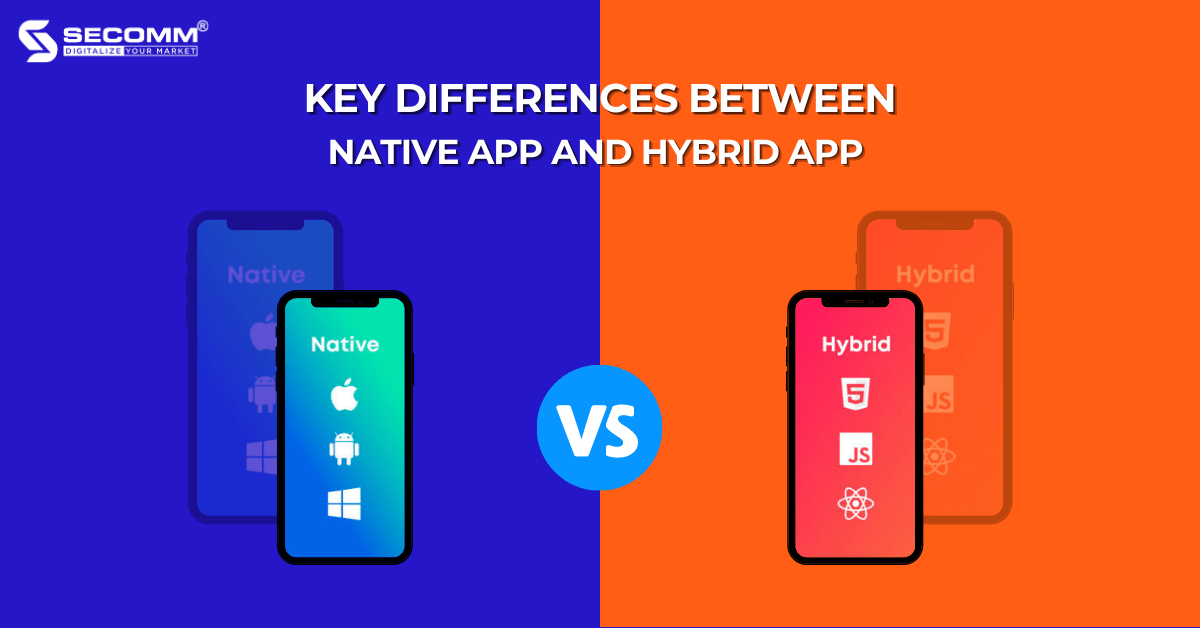
NATIVE APP & HYBRID APP: KEY DIFFERENCES, PROS & CONS
According to Statista, by 2023, there will be approximately 6.9 billion smartphone users worldwide, which will lead to the emergence of mobile apps to enrich user experience. That is why many businesses find ways to build and develop mobile apps to interact with their customers. However, with many platforms and devices around, mobile app development can be a complex and costly process. There are two most popular types of mobile apps including Native Apps and Hybrid Apps.
Both apps have their own advantages and disadvantages, so businesses should consider their demand and resources to choose the right type of app.
Native App
What is Native app?
Native app is a type of mobile application that is developed specifically for a particular platform or operating system, such as iOS or Android. Native apps use different programming languages depending on the platform they are built on: Objective-C or Swift are the main programming languages for iOS, while Java or Kotlin are the main programming languages for Android.
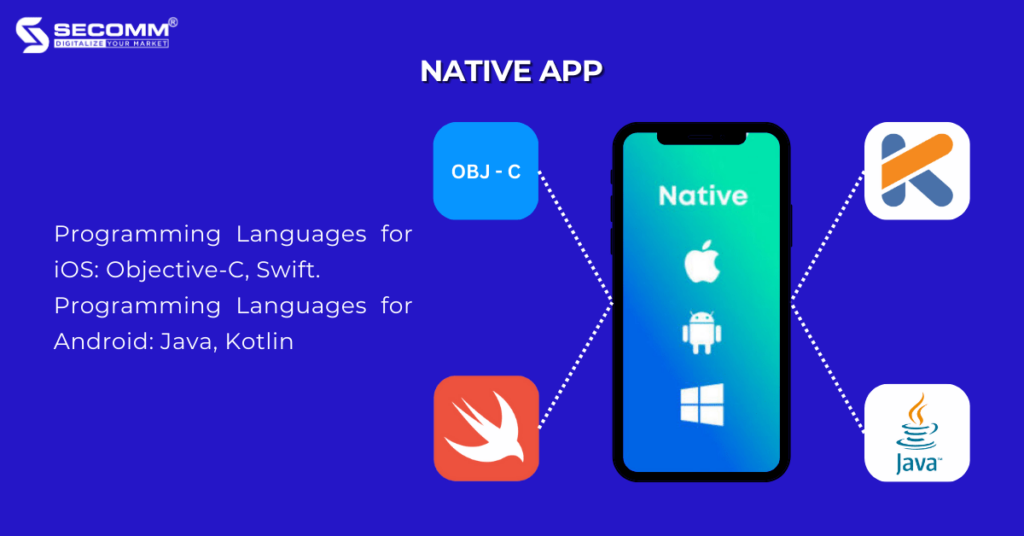
Advantages of Native App
- Performance: Native apps are designed to run directly on the device’s operating system, which means that they can fully leverage the device’s capabilities. Therefore, the app’s performance is faster and the user experience is smoother.
- Access to device features: Native apps have full access to the hardware features of mobile devices such as the camera, GPS, contacts, microphone, etc. Developers can create mobile apps with advanced features and functionality that hybrid apps cannot help.
- User experience: Because Native apps are optimized for specific platforms, they provide an intuitive and rich user experience. Users also can use native apps even when they are not connected to the Internet.
- Security: The data security of Native apps is high because they are optimized for specific platforms, so developers must comply with certain principles for securing user data and information on each platform.
Disadvantages of Native App
In addition to outstanding advantages, Native apps still have some limitations to be aware of:
- Separate codebase: This is a major disadvantage of Native apps because it requires a high level of skills and expertise in developing tools and programming languages for each platform. Moreover, the process of maintaining and updating the application version must be done separately for each codebase, leading to a lack of consistency on iOS but not on Android, or the app versions on Android are updated regularly while on iOS they are updated slower and vice versa. Because businesses have to create a separate version of the app for each platform, this can limit the app’s reach to many target customers.
- Costly and time-consuming: Because native apps have a separate codebase for each platform, businesses will spend a lot of time and costs to develop, maintain, and update app versions.
Native apps will be suitable for businesses that want to build mobile apps with high performance, diverse features, and a focus on user experience. However, this choice requires a lot of development and maintenance costs, as well as significant time and effort to be put in.
Hybrid App
What is Hybrid app?
Hybrid app is a type of mobile application built using web technologies such as HTML, CSS, and JavaScript, and then packaged in a Native app container. This allows hybrid apps to run on multiple platforms or different operating systems, including iOS and Android.
Frameworks for developing hybrid apps include React Native, Flutter, Xamarin, and Ionic.

Advantages of Hybrid App
- Single Codebase: This is a major advantage of hybrid apps because developers can create an app that runs on multiple platforms with a single codebase instead of creating separate app versions for each platform like native apps. This helps businesses save a considerable amount of budget, for example, instead of finding developers specialized in both iOS and Android platforms to build a mobile app, they only need to find someone with expertise in hybrid apps. Additionally, since hybrid apps are built using web technologies such as HTML, CSS, and JavaScript, developers can leverage existing web development skills and expertise to speed up the development process.
- Time and cost savings: With a single codebase that runs on multiple platforms, businesses will develop hybrid apps faster and at a lower cost. Also, maintenance will be easier since update versions are made on a single codebase and applied simultaneously across all platforms.
Disadvantages of Hybrid App
In addition to the advantages mentioned above, hybrid apps also have some drawbacks that businesses need to consider when building them.
- Performance: Compared to native apps, hybrid apps have pooper performance and sometimes experience lag or stuttering during use.
- Limited access to device features: Unlike native apps, hybrid apps have limited access to devise hardware features such as cameras, contacts, microphones, etc. This can significantly impact the user experience of the app.
- User experience: Platforms such as iOS or Android have different rules and operating methods, so a design that is used across most hybrid apps may not be suitable for each platform’s operating rules. This can result in a poor and disjointed user experience. Additionally, users may not be able to use the apps without an Internet connection.
- Security: Because hybrid apps are built using web technologies such as HTML, CSS, and JavaScript, and are compatible with multiple platforms, they are vulnerable to cyber-attacks.
Hybrid apps are a good choice for businesses that want to create a mobile app that works on multiple platforms and devices, with a faster development time and lower costs than native apps. However, hybrid apps still have many limitations in terms of performance, user experience, etc. Therefore, businesses should consider this before deciding to build a hybrid app.
Comparison Table
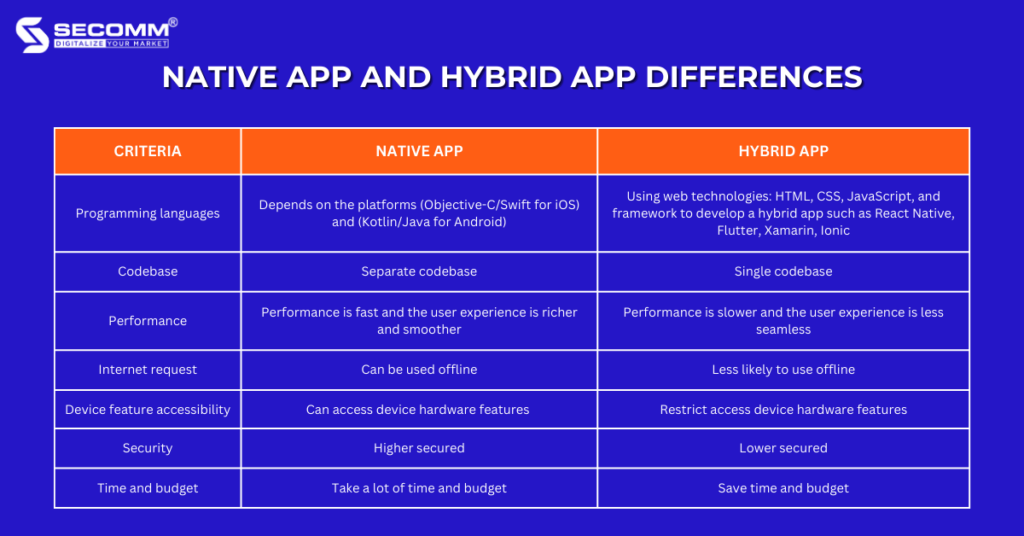
Facing the rapid development of mobile apps, quickly building a proprietary app is an urgent mission for every business. With the set of advantages and disadvantages summarized of the two most popular types of applications today: Native app and Hybrid app, the decision will depend on the purpose of each business.
SECOMM has gained many years of experience implementing eCommerce for many customers in many countries, understanding the difficulties and challenges each business faces when deploying mobile applications.
Contact us today to receive a free consultation.
 2
2

 2,968
2,968

 1
1

 1
1
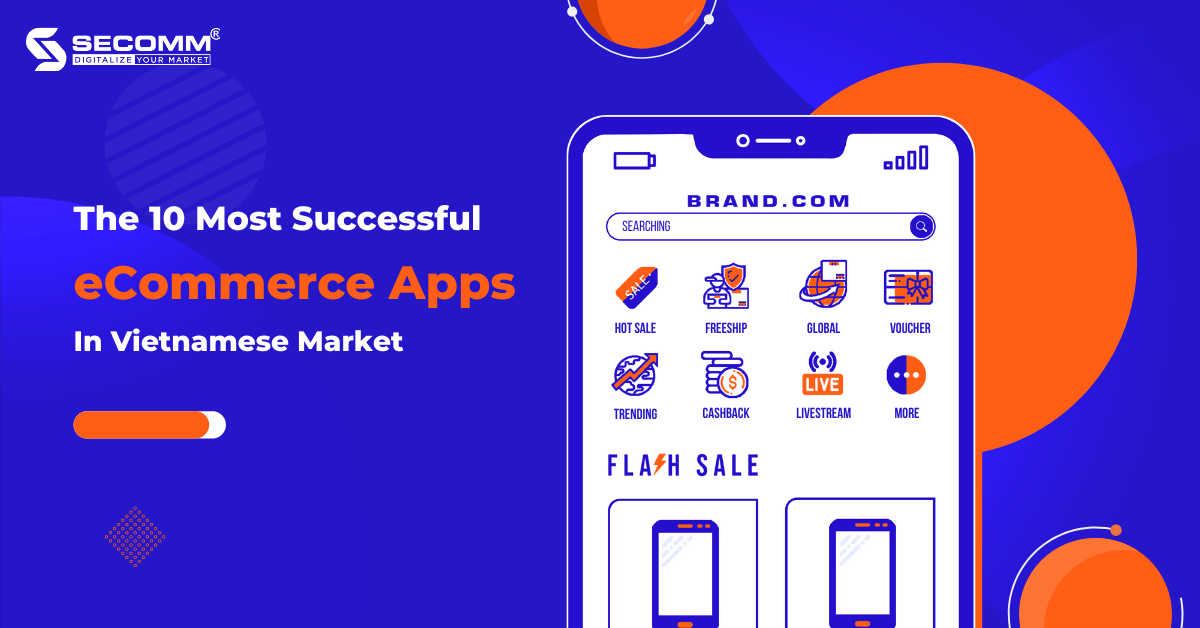
THE 10 MOST SUCCESSFUL ECOMMERCE APPS IN VIETNAMESE MARKET
The significant increase in the number of smartphone users has contributed to the rise of Mobile Commerce trends worldwide, including in Vietnam. It’s time for retailers to focus on supporting their customers in searching and shopping through mobile devices, in addition to eCommerce websites.
Many businesses across various sectors, from shopping, healthcare to food, have performed very well in this strategy by becoming pioneers in embracing Mobile Commerce trends in Vietnam.
SHEIN
The SHEIN app is known as one of the most successful eCommerce apps in the world today, and now it has become the most downloaded mobile app in the shopping category in 2022 with 229 million downloads and installs from both Google Play and the App Store.
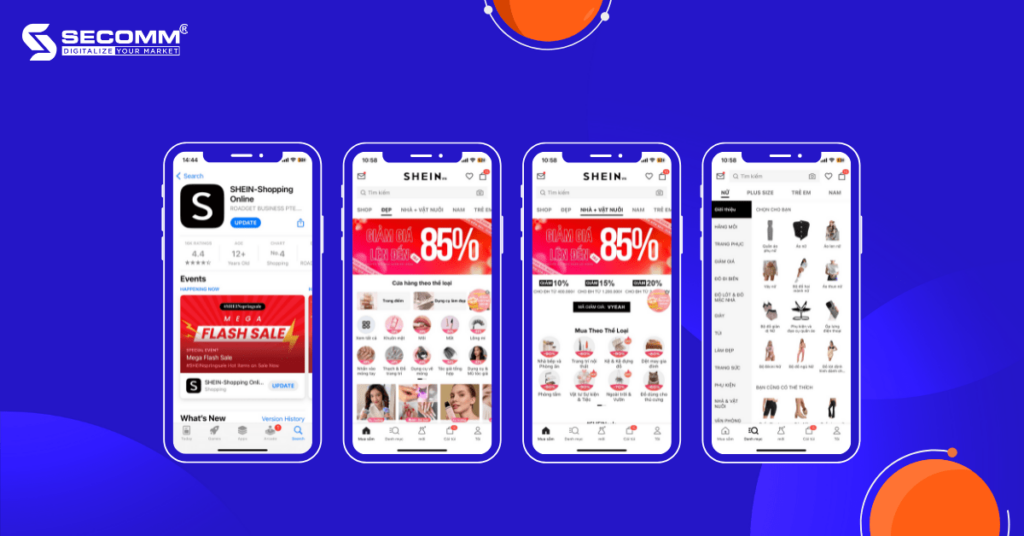
In the Vietnamese market, SHEIN is also highly rated by users for their shopping experience on the app. In the latest update, SHEIN added a discount program for some fashion items of up to 70%, as well as fixing some bugs and improving performance to provide users with a better experience.
- Downloads: +100M
- Reviews: 4.5 ★ (Google Play), 4.4 ★ (App Store)
- Rankings: #4 in the Shopping category
Download the SHEIN app: Google Play | App Store
Uniqlo VN
When entering the Vietnamese market in 2019, Uniqlo quickly captured and responded to the local consumers’ fashion shopping trends, which made the brand very popular. The Uniqlo VN app stands out with many necessary functions for a consistent shopping experience between mobile devices and other channels. In order to attract more users, Uniqlo will offer a 150,000 VND discount voucher for anyone who downloads the app and signs up as a new member.
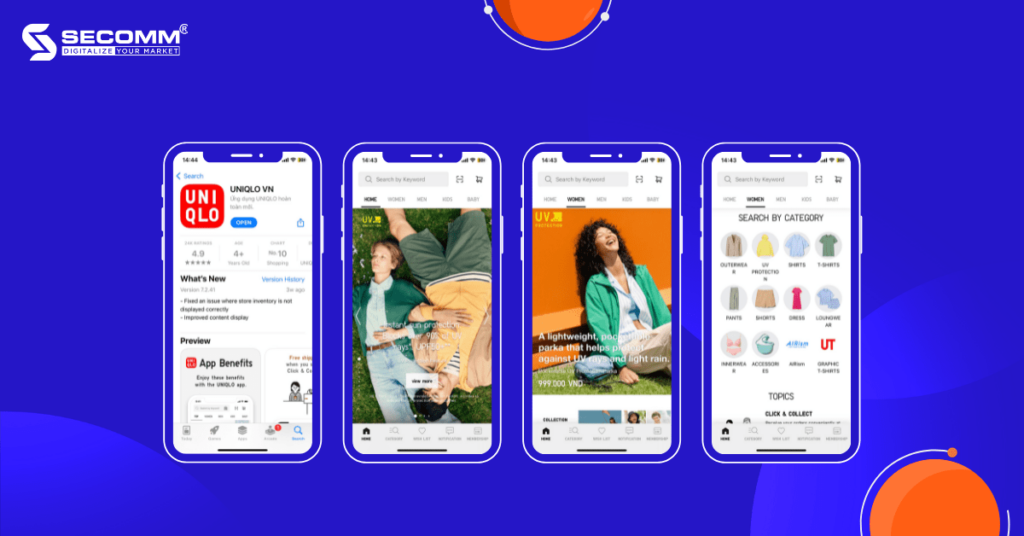
Although the Uniqlo VN app is highly rated for user experience, the brand still keeps updating and improving its features. In the latest update, Uniqlo has improved the quality of product image display and adjusted the accurate display of the number of products available in-store.
- Downloads: +500K
- Reviews: 4.7 ★ (Google Play), 4.9 ★ (App Store)
- Rankings: #10 in the Shopping category
Download the Uniqlo VN app: Google Play | App Store
Hasaki
Hasaki not only has nationwide brick-and-mortar stores and an eCommerce website but also develops a mobile app to offer its customers enriched shopping experiences and attractive incentives.
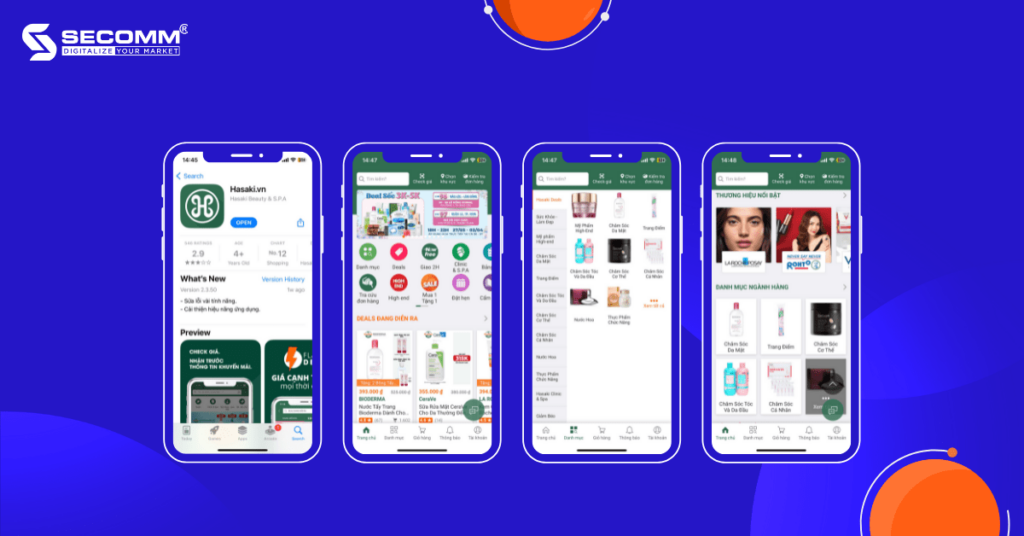
By using the Hasaki app, customers can conveniently search and purchase products anytime, anywhere, track their order status, and make appointments for spa and clinic services at the store. One thing that makes Hasaki special is the free delivery within 2 hours for all customers, whether shopping at the store, eCommerce website, or mobile app. Despite getting much critical feedback for usage quality, Hasaki is still very receptive, fixing bugs and optimizing performance in the recent updates.
- Downloads: +100K
- Reviews: 3.3 ★ (Google Play), 4.3 ★ (App Store)
- Rankings: #12 in the Shopping category
Download the Hasaki app: Google Play | App Store
Go! & Big C
After rebranding, the Big C supermarket chain has been renamed Go!. As a result, the mobile app of this business is now called Go! & Big C. Customers who shop on the app will enjoy many benefits, including:
- Free shipping for orders over 300,000 VND purchased on the mobile app;
- Daily promotions will be automatically updated;
- Create shopping lists directly on the app;
- Participate in weekly games to win coupons or vouchers;
- Track & accumulate points directly in the app.
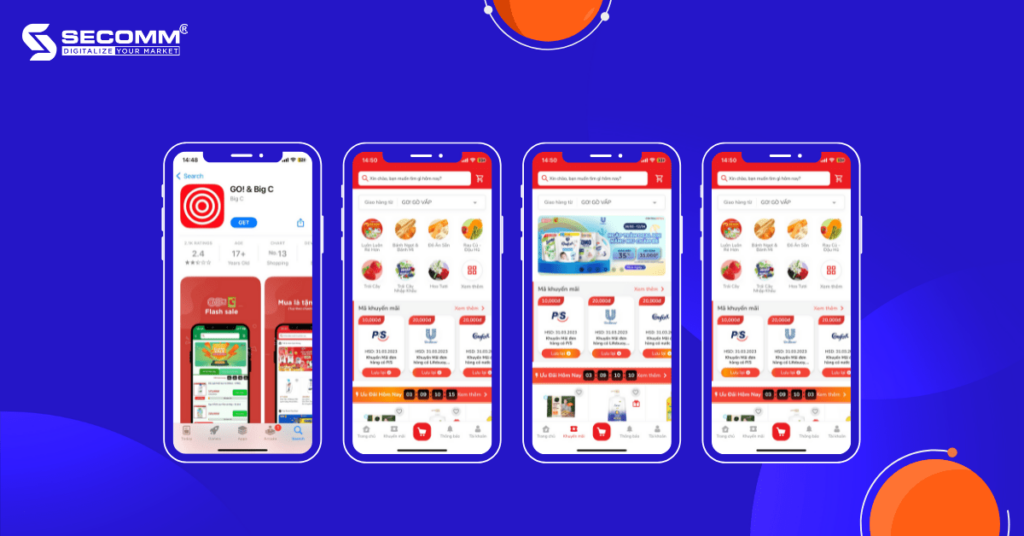
The Go! & Big C app is regularly updated to improve the online shopping experience for customers. In the most recent update, the developer has improved the payment function, fixed bugs, optimized performance, and image display capabilities.
- Downloads: +1M
- Reviews: 2.8 ★ (Google Play), 2.4★ (App Store)
- Rankings: #13 in the Shopping category
Download the Go! & Big C: Google Play | App Store
Con Cung
Con Cung is one of the first childcare brands to develop its mobile app to provide customers with a consistent shopping experience across different channels, including physical stores, mobile apps, and eCommerce websites.
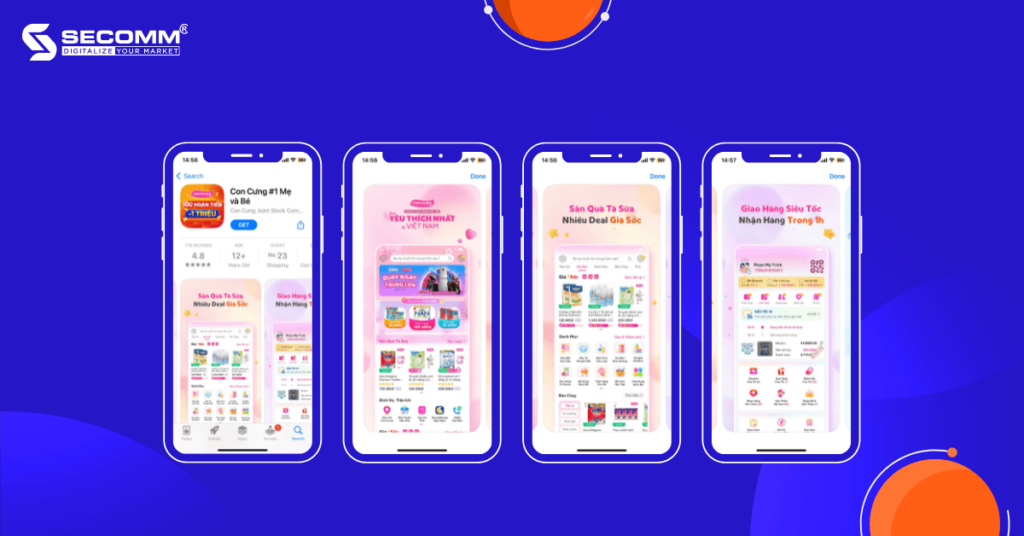
The Con Cung app has received very positive reviews from users on both Google Play and App Store for user experience, product quality, and promotional programs. However, the brand still maintains the practice of testing and improving certain features such as displaying detailed driver’s information when customers place orders for the 1-hour delivery service and fixing bugs related to payment via eWallet.
- Downloads: +1M
- Reviews: 4.7 ★ (Google Play), 4.8 ★ (App Store)
- Rankings: #24 in the Shopping category
Download the Con Cung app: Google Play | App Store
Dien May Xanh
Dien May Xanh is a big player in the Vietnamese home appliance industry that has successfully captured the market trend and quickly developed a mobile app to reach the huge smartphone user base in Vietnam – approximately 69 million users.
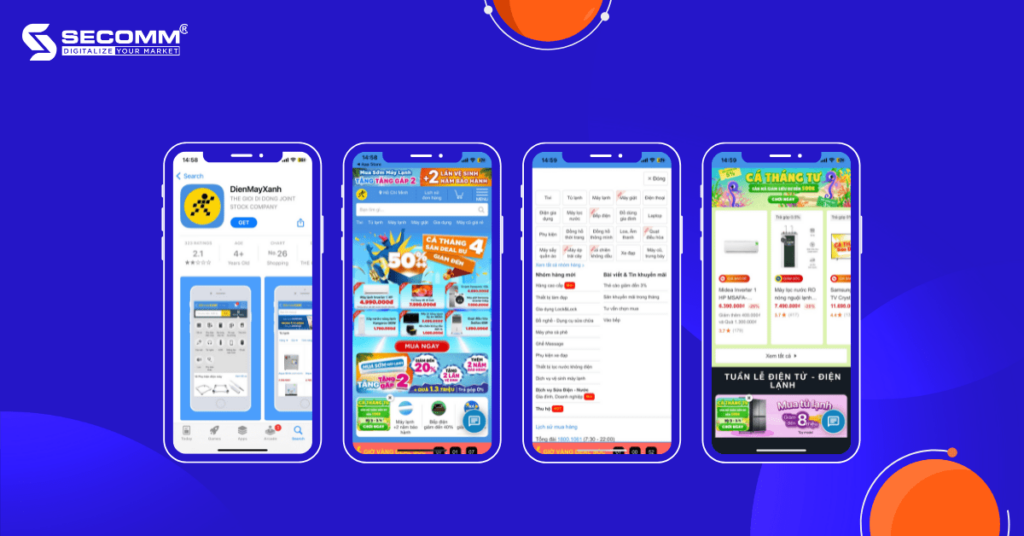
In addition to massive promotional programs on special occasions, Dien May Xanh also provides customers with discounted payment programs using various methods such as Buy Now Pay Later, QR Code, etc. All of these are carried out quickly and easily both on the website and the mobile app.
- Download: +1M
- Reviews: 4.0 ★ (Google Play), 2.3 ★ (App Store)
- Rankings: #31 in the Shopping category
Download the app: Google Play | App Store
LixiBox
The Vietnamese mobile commerce market has witnessed the entrance of another famous cosmetics retail brand, LixiBox. Similar to Hasaki, LixiBox also continuously updates its app to enhance the shopping experience of customers.
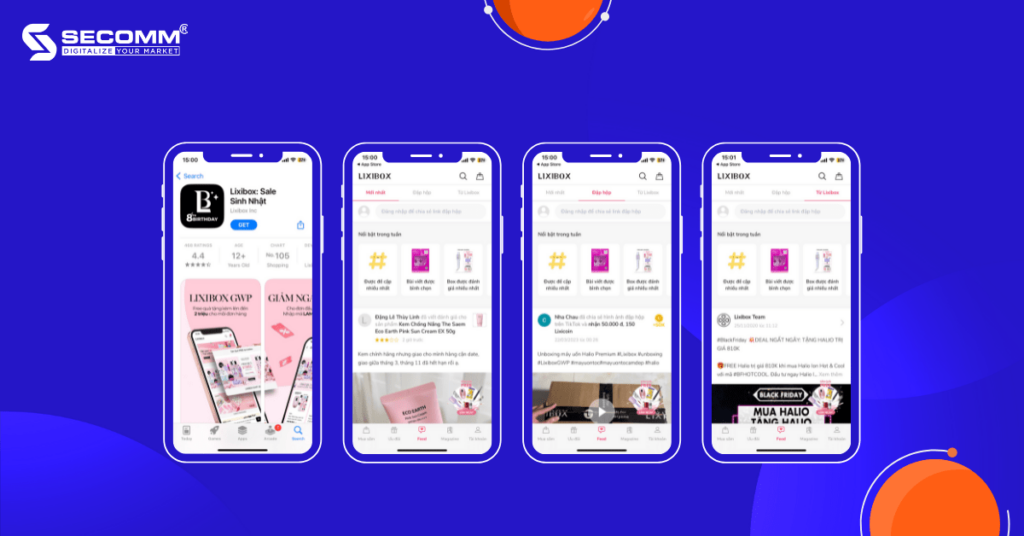
Moreover, the brand offers many special incentives to attract users such as a 20% discount for the first order placed on the app, a referral program where customers can receive 500,000 VND, a magazine section where users can update the latest beauty trends right on the app, and a LixiBox Feed section where customers can share their experiences on products and services.
- Downloads: +100K
- Reviews: 4.4 ★ (Google Play), 4.4 ★ (App Store)
- Ranking: #113 in the Shopping category
Download the LixiBox app: Google Play | App Store
Long Chau
When the Long Chau mobile app was launched during the Covid epidemic, it quickly received support from customers everywhere because they could buy medicine and healthcare products online and have them delivered to their door, while also earning reward points for their next purchase. In addition, the app has a call and message feature that allows users to contact pharmacists online for free in-depth advice and support. Furthermore, Long Chau is the first pharmacy to pioneer the Buy Now Pay Later service with 0% interest, helping patients and customers find a new convenient way to make purchases.
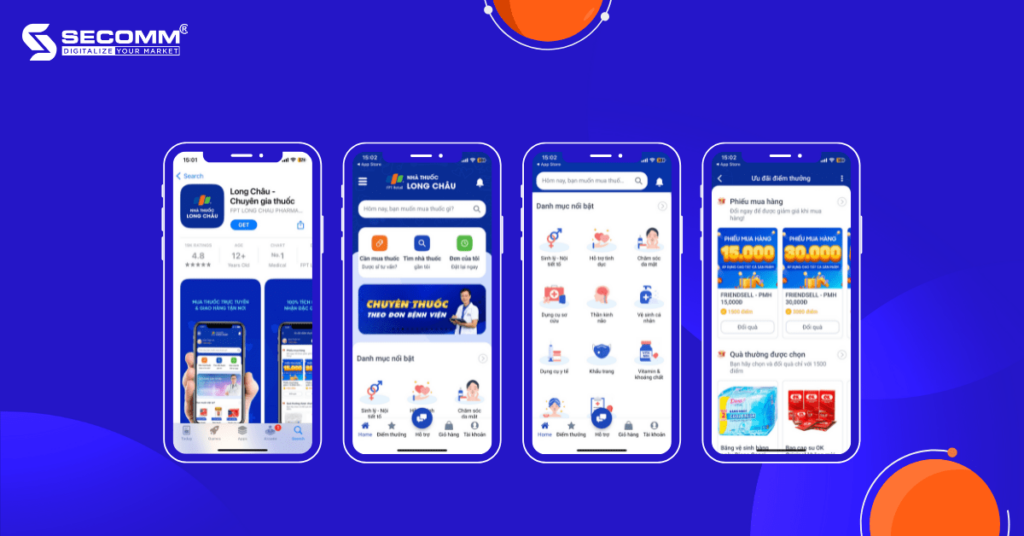
User experience is a particularly important factor that Long Chau focuses on, and the app regularly releases updates. These updates include optimizing the login function, improving the payment function, integrating payment via eWallet, synchronizing order status on the website and app, suggesting reordering, and more.
- Downloads: +1M
- Reviews: 4.5 ★ (Google Play), 4.8 ★ (App Store)
- Ranking: #1 in the Medical category
Download the Long Chau app: Google Play | App Store
Pharmacity
Pharmacity is a mobile app developed by the convenient pharmacy chain – Pharmacity in 2018. Similar to Long Chau, the Pharmacity app was created to provide customers and patients with a convenient and fast shopping experience, along with online consultation services from a team of highly specialized pharmacists.
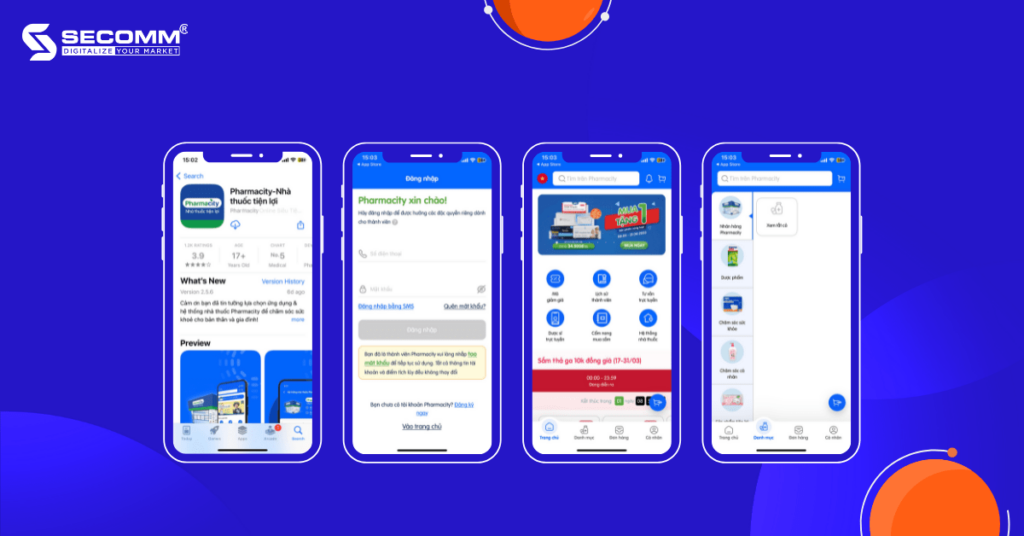
In its latest update, Pharmacity has improved and added some features, including a gift program for first-time users who download the app and sign up as members.
- Downloads: +100K
- Reviews: 2.2 ★ (Google Play), 3.9 ★ (App Store)
- Ranking: #4 in the Medical category
Download the Pharmacity app: Google Play | App Store
The Coffee House
In 2021, the famous beverage brand The Coffee House officially launched its mobile app with the same name, aimed at providing customers with the experience of ordering drinks for delivery or picking up at the store, along with many reward point programs for attractive incentives.
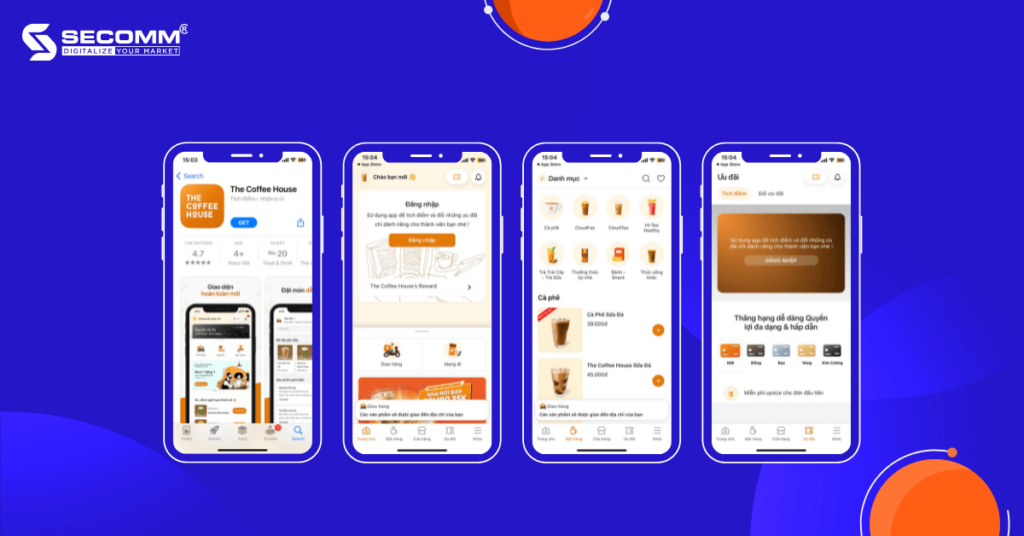
After two years of development, the new version of The Coffee House app features a completely new interface and many special features designed to enhance the customer experience both on the app and at physical stores.
- Downloads: +500K
- Reviews: 3.7 ★ (Google Play), 4.7 ★ (App Store)
- Ranking: #20 in the Cuisine category
Download the app: Google Play | App Store
Mobile eCommerce apps are one of the rising trends in mobile commerce. As a result, developing mobile shopping apps is the first smart move to achieve sustainable growth in the booming era of mobile commerce.
Contact SECOMM now for advice on how to implement and develop the best strategies to dominate the Mobile Commerce market.
 2
2

 2,878
2,878

 0
0

 1
1
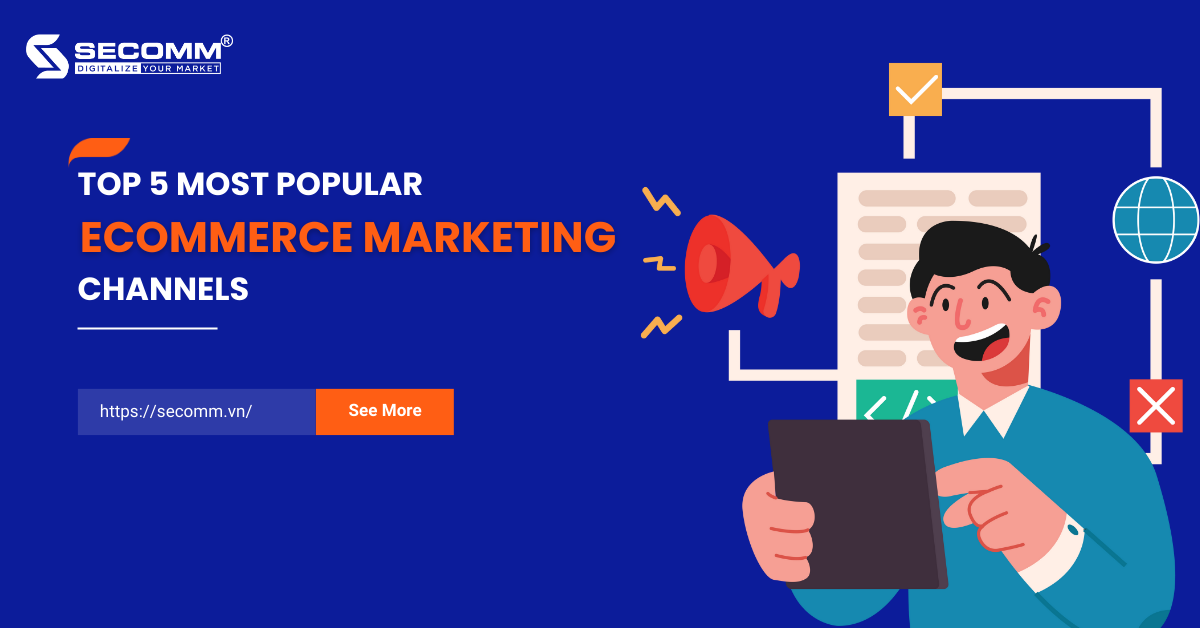
5 MOST POPULAR ECOMMERCE MARKETING CHANNELS YOU SHOULD KNOW
The global pandemic has created an unprecedented boost for the eCommerce industry, forcing business leaders to go for digital transformation whether they want to or not. However, there are still many businesses that are hesitant and encounter difficulties while embracing it.
In addition to selecting an eCommerce platform and building a website, they can leverage incredible marketing channels to develop an eCommerce marketing strategy.
What is eCommerce Marketing?
eCommerce Marketing, also known as Electronic Commerce Marketing, is the practice of using various marketing channels such as social media marketing, content marketing, SEO, or email marketing to increase the efficiency of eCommerce operations. To be more specific, eCommerce Marketing does the following:
- Directs traffic to an eCommerce website;
- Helps a brand appear in front of the target audience;
- Makes it easy for people searching for products the company sells and to discover the company’s website;
- Converts website visitors into new potential customers;
- Encourage existing customers to make repeat purchases;
- Enhances the post-purchase shopping experience to increase customer satisfaction and loyalty.
- Drive more frequent and larger orders at the eCommerce website.
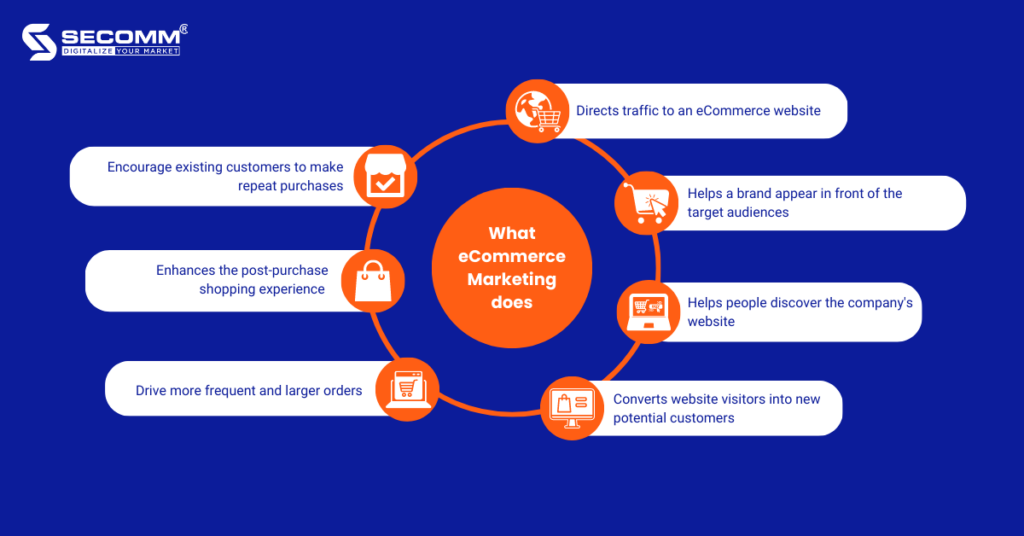
The purpose of eCommerce Marketing is to enhance brand awareness and boost sales. Therefore, if a business doesn’t have an eCommerce Marketing strategy, then it’s really hard for their eCommerce website to generate conversion despite the beautiful interface and well-built functional system.
Most popular eCommerce Marketing Channels
Social Media Marketing

Currently, most brands and content creators take advantage of the popularity of social media as the first step for connecting and serving their target audience with content that interests them. eCommerce businesses can do the same by using engaging content and images to grab the audience’s attention and direct traffic to their website.
In this case, the eCommerce website interface must have a high level of visual appeal, especially showcasing prominent products to create inspirational shopping. Moreover, businesses can implement social commerce to directly sell products on social media platforms like Facebook, Instagram, TikTok, and so forth.
Content Marketing

This is an effective marketing channel that brings long-term results for eCommerce businesses as well as a sustainable branding tool for their brands. Currently, various types of content are widely used, including
- Blogs;
- Videos;
- Podcasts;
- Educational content;
- User-generated content, such as images, videos, forum discussions, testimonials, etc.
The goal of content marketing is to answer questions, provide information, promote the brand, suggest and guide customers in choosing products, and even entertain them. With optimized content, customers will quickly find out the website and the business can increase the conversion rate. Moreover, the business can leverage that content for the next eCommerce marketing campaigns.
Search Engine Marketing (SEM)

SEM includes both Search Engine Optimization (SEO) and paid advertising. While SEO requires marketers to understand Google’s ranking algorithm to optimize their content to meet Google’s evaluation criteria, SEM relies on various campaigns such as pay-per-click (PPC) campaigns, display campaigns, or product advertising campaigns like Google Shopping Ads.
On Google, PPC campaigns ensure that potential customers will see the link leading to the brand’s website when they enter search terms that match the selected campaign keywords. That is the reason why eCommerce businesses frequently utilize Google Adwords and run PPC campaigns to advertise their product pages.
This way enhances the chances of searchers clicking on the link and making a purchase decision before leaving the eCommerce website, leading to a notable increase in conversion rates.
Influencer Marketing

A reliable influencer can be a brand’s ‘best friend’. The introduction or endorsement of an influencer can help businesses quickly increase sales, optimize marketing ROI, and raise brand awareness. In addition, Influencer Marketing leverages the trust in an individual’s persuasive abilities and self-confidence to influence and encourage their followers to make purchasing decisions.
Influencer marketing is a highly effective eCommerce marketing channel in that eCommerce brands are more likely to continually find ways to collaborate with influential individuals to drive recognition and emotional shopping for specific products or services
Email Marketing

This is one of the oldest categories of Digital Marketing. Today, in the eCommerce world, email marketing still plays a very special role that enables businesses to automate campaigns toward targeting subscribers from different segments or stages in the customer journey
However, businesses should be careful in selecting and categorizing the target groups in their email list, to send the right content to the right target audience. This way, businesses can maintain the trust of potential customers at a time when privacy and personal data security have become increasingly important to Internet users.
Therefore, they should be cautious in building their email list if email marketing is a part of their eCommerce marketing strategy.
With all things considered, if there is no eCommerce Marketing, eCommerce websites are virtually unknown. The only way for a website to gain brand recognition, attract more online customers, and generate consistent and regular revenue is to effectively implement target marketing activities.
With a wealth of experience successfully implementing eCommerce for many customers in various countries in recent years, SECOMM understands the difficulties and obstacles businesses face when undertaking tasks related to eCommerce marketing strategy.
Contact SECOMM today to receive free support and consultation.
 2
2

 2,085
2,085

 0
0

 1
1
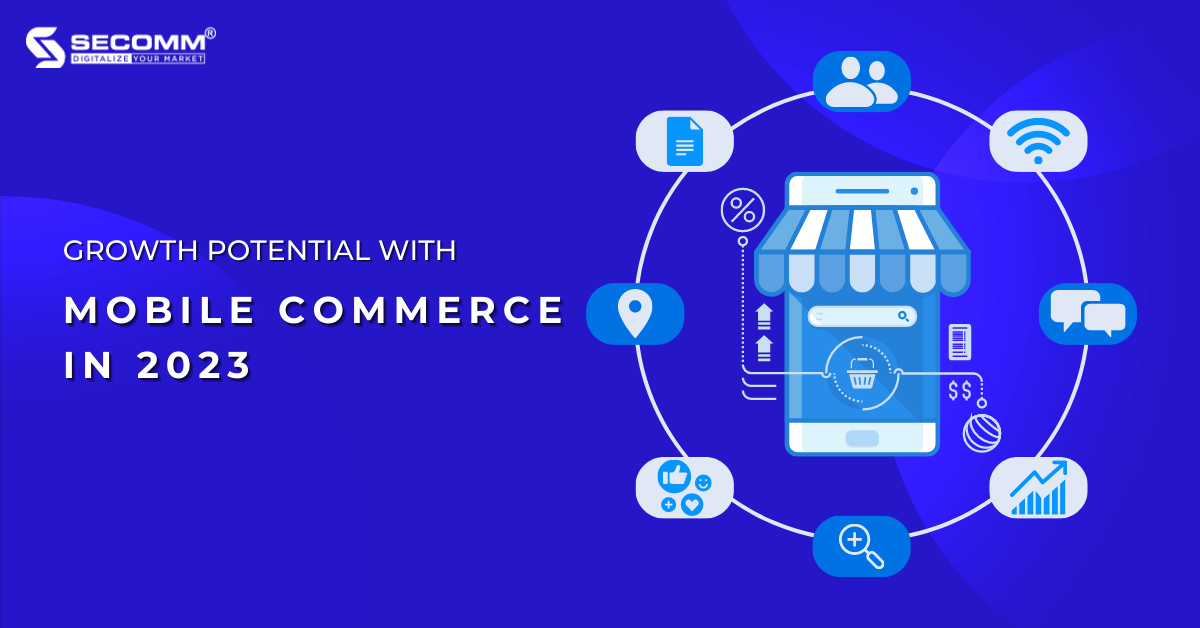
GROWTH POTENTIAL WITH MOBILE COMMERCE
According to the latest data compiled by Statista, as of January 2023, the number of global smartphone users is 6.92B people, increasing by 4.2% annually. In Vietnam alone, this number is around 69 million users, whereas, in the US, Pew Research Center estimates that about three-fourths of Americans own a smartphone. These data demonstrate that smartphones have become common devices, and the demand for owning and using smartphones is significantly increasing.
In addition, the Internet has long ceased to be a high-end infrastructure for countries. Therefore, people today tend to prioritize using mobile devices like smartphones to browse the web.
Typically, Brands tend to establish a strong presence in areas with a wide pool of potential customers, so the emergence of Mobile Commerce quickly gained acceptance and became one of the key business strategies of many enterprises.
Moreover, the appearance of the Covid-19 pandemic in 2020 became a great boost for eCommerce in general and Mobile Commerce, in particular, to explode strongly.
During that period, the smartphone became the shopping companion of users as 79% of users used their smartphones or other mobile devices to shop online, as reported by OuterBox. Despite the eventual end of the pandemic, the Mobile Commerce growth trend is projected to continue as mCommerce retail sales hit $415 billion in 2022, and are predicted to reach $710 billion by 2025.
What is Mobile Commerce?
Mobile Commerce or Mobile eCommerce, abbreviated as m-commerce or mCommerce, is also known as Thương Mại Di Động in Vietnamese. This term was first coined and used by Kevin Duffey at the Global Mobile Commerce Forum in 1997, which means “providing direct eCommerce capabilities to consumers, anywhere, through wireless technology”.
Simply put, it is a business model in which all online monetary transactions are conducted on mobile devices such as shopping, banking, eWallet transactions, ride-hailing, food delivery, hotel reservations, etc.
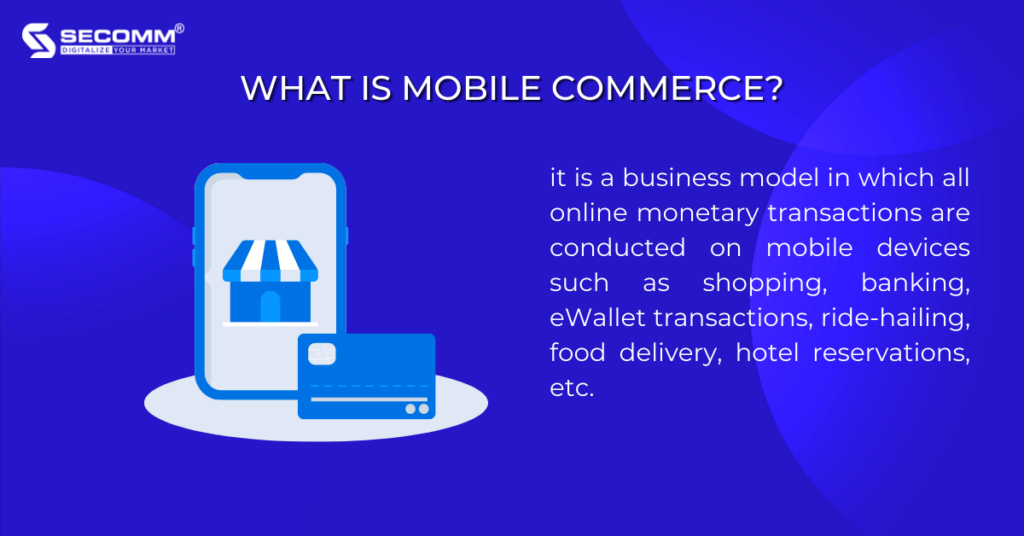
mCommerce vs eCommerce
eCommerce or electronic commerce is a relatively broad concept that refers to the buying and selling of goods and services over the Internet. Meanwhile, Mobile Commerce is a branch of eCommerce or the mobile version of eCommerce, specifically referring to electronic commerce transactions carried out on mobile devices.
Furthermore, the eCommerce shopping experience depends heavily on desktops and websites, making it less mobile-friendly and inconvenient for customers. On the other hand, with Mobile Commerce, customers can easily bring their devices with them anywhere, allowing businesses to provide personalized shopping experiences that help customers make quick purchasing decisions.
Top Mobile Commerce Trends Are On The Rise
Thanks to the popularity of smartphones in every consumer’s life, related trends are on the rise such as mobile shopping, mobile payment, and social commerce.
Mobile Shopping Apps
Mobile shopping apps are becoming more and more popular and are the most prominent trend in mobile commerce. Many retail brands across various industries are investing in building and developing their own eCommerce apps such as the fashion industry, the cosmetic industry, and so forth. This not only helps businesses increase their conversion rates and sales but also makes the shopping experience easier and more convenient for customers, as they will be able to search for products and complete purchases right on the app.
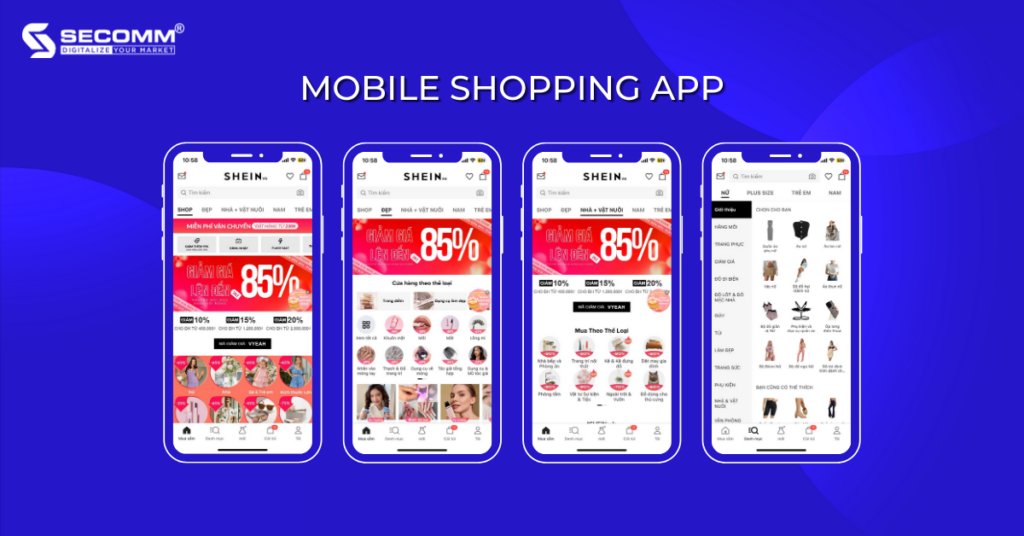
In addition, the outbreak of the Covid pandemic and the establishment of social distancing measures in 2020 marked the beginning of the boom of shopping apps. As stated by the Mobile Shopping Report 2021, global usage of shopping apps increased by 40% in Q1 2021.
In the effort to develop sustainably amidst the pandemic crisis, the SHEIN app with nearly 15.5 million global users played a significant role in contributing to the company revenue of $9.81 billion in 2020.
As of 2021, SHEIN’s mobile app reached 43.7 million users and became the second most downloaded app in the world after Shopee. In 2022, SHEIN’s user base grew to 74.7 million and officially became the most downloaded mobile app globally in the shopping category with over 229 million downloads and installations from the App Store and Google Play
Mobile Payment Apps
The usefulness of smartphones not only lies in online shopping but also makes transactions and payments more convenient and easy during the peak period of the pandemic. In addition to Mobile Banking applications, users have a special preference for mobile wallet or eWallet applications.
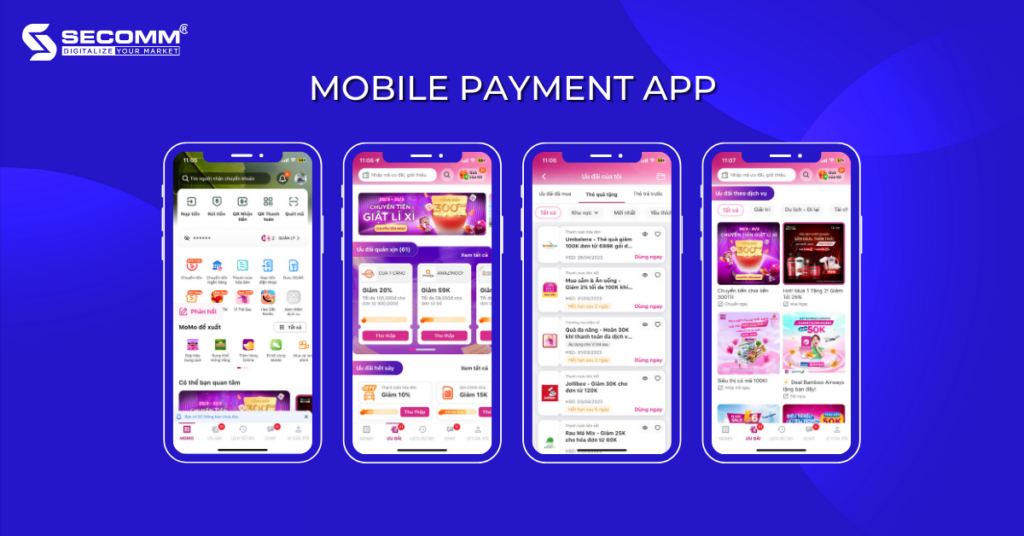
In the Vietnamese market, when it comes to eWallets, people immediately think of MoMo. However, MoMo is not only known as a typical eWallet but also an incredible super application.
To date, MoMo has built a platform that provides about 400 different types of services in many fields such as consumer finance, insurance, money transfer, payment, entertainment, shopping, dining services, and charity donations, etc. The number of MoMo users has increased significantly in recent years, from 10 million users in 2019 to about 31 million users in 2022, and the company’s next target is at least 50 million users.
- Related Reading: Top 5 Prominent eCommerce Super Apps in The Vietnamese Market
Social Commerce
In addition to making their mobile shopping apps, selling on social media platforms is also one of the widely applied strategies. The popularity and large user base of social media are a solid foundation for the development of Social Commerce and a playground for merchants of all sizes. Social Commerce is a form of online selling through social media platforms like Instagram, Facebook, and TikTok.
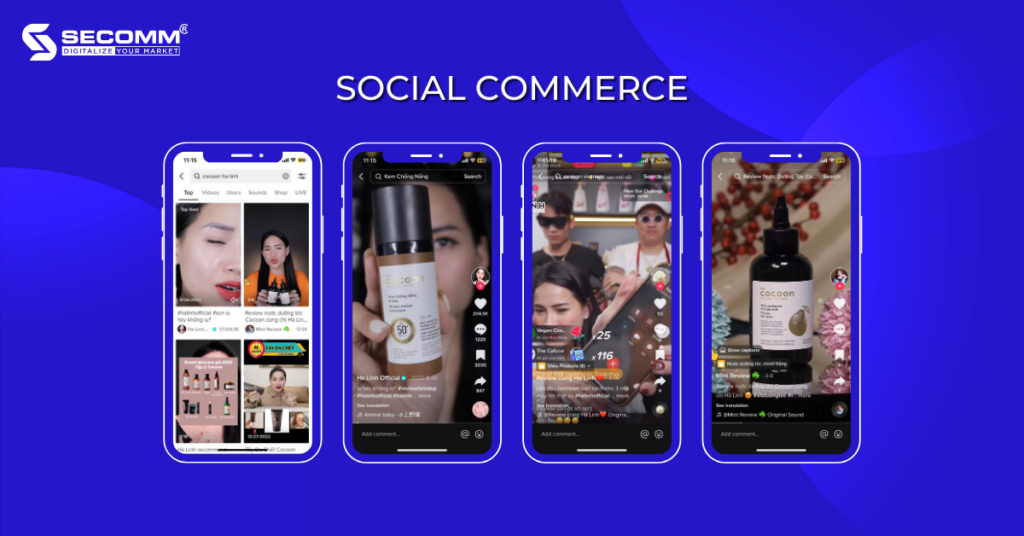
Selling on social media will help brands reach the existing large user base and utilize influencers for their marketing campaigns.
For example, the vegan cosmetics brand Cocoon does this through TikTok Shop. Cocoon is known for its environmentally friendly and animal-testing-free products, and they opened a store on TikTok and collaborated with famous beauty vlogger Ha Linh, which brought them a lot of success. It not only boosted their sales but also reached nature-loving, animal-loving, and young customers on TikTok.
- Related Reading: Everything To Know About TikTok Shop
Benefits of Using Mobile Commerce
Convenience and Accessibility
As mentioned, the global number of smartphone users is estimated to reach around 6.9 billion by 2023, which is a driving force for the development of Mobile Commerce. Anyone who owns a smartphone has the potential to become a customer. As a result, implementing Mobile Commerce will help businesses reach this enormous user base, nurture and generate conversions.
In addition, with the mobility of Mobile Commerce, smartphone users with internet access can shop anytime, anywhere, even on the go without being dependent on a fixed location. Especially when visiting a store to shop, instead of paying in cash or by card, customers can now pay through eWallets such as MoMo or VNPay, etc.
Offer Personalized Experience
Currently, businesses are very focused on personalized customer experience, which is particularly important in the Mobile Commerce world. A smartphone is a personal item that each person carries out personal activities throughout the day. Moreover, in the online shopping trend, customers highly value brands that provide them with a personalized experience because it demonstrates the brand’s concern for its customers. As a result, the more businesses focus on details and personalization in their messages and promotional programs, the better.
For Mobile Commerce, push notifications are an effective solution. Mobile Commerce apps help businesses track and collect user data including personal information, social media accounts, interests, current location, purchase history, viewed products, etc. After that, they can combine and analyze the data to send appropriate messages to the right target audience through push notifications.
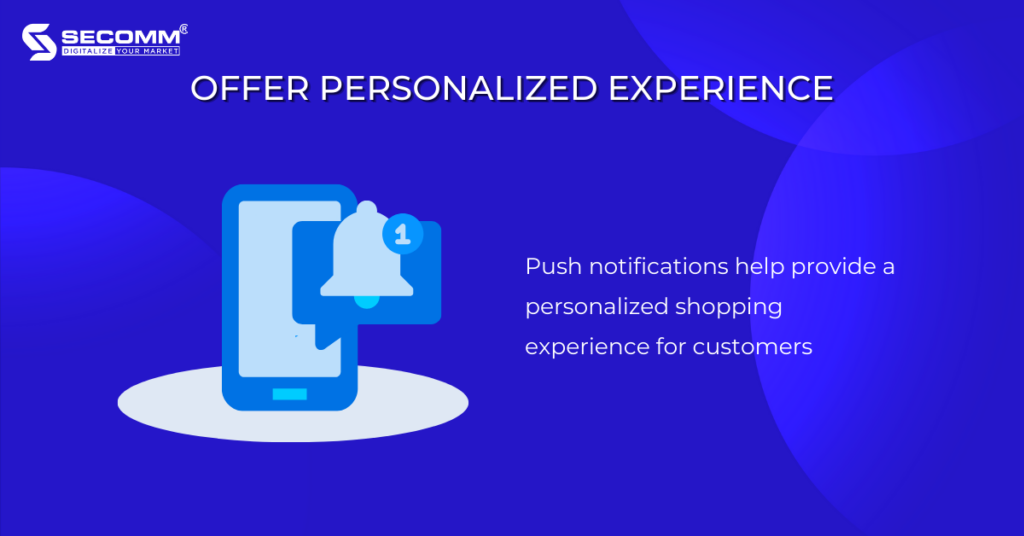
Recent studies have shown the effectiveness of push notifications in connecting with customers and notifying them about new products and special incentives.
- The open rate of push notifications is 90%.
- This open rate is 50% higher than email marketing.
- Up to 55%-60% of mobile app users agree to receive push notifications.
- 70% of them find push notifications useful.
- 52% of users search for related information and promotional programs after receiving and reading push notifications.
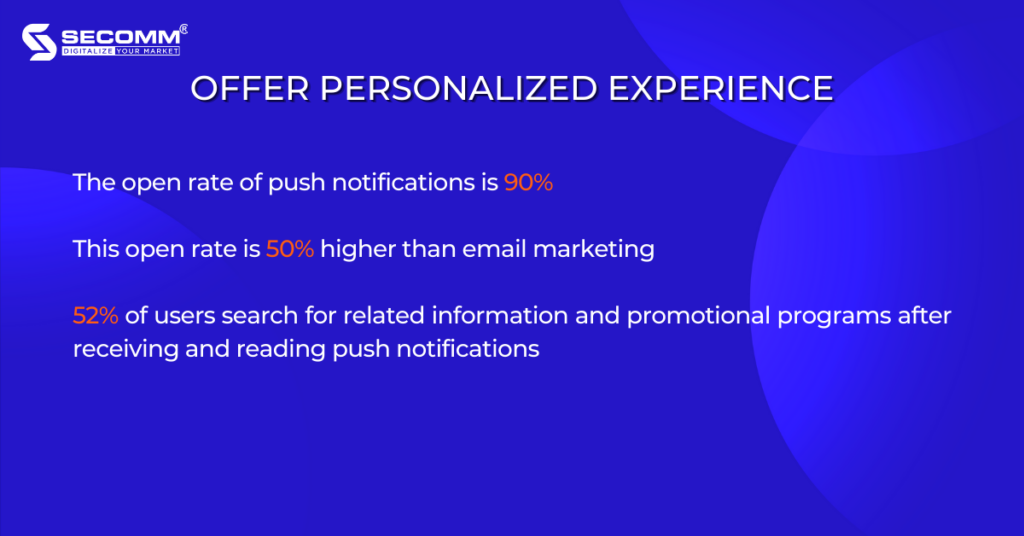
Push notifications are one of the strategies implemented to provide personalized shopping experiences and bring satisfaction to customers. The more satisfied customers are with their shopping experiences, the higher the likelihood that businesses will increase customer retention rates and maintain their loyalty.
Provide Omnichannel Shopping Experience
The demand for a personalized shopping experience is increasing among customers, as well as the need for a consistent shopping experience across multiple channels, from online to offline stores. According to a study by MasterCard, customers who have a multi-channel shopping experience with a specific retailer tend to spend 250% more than the average. The fashion brand Macy’s has stated that the value of multi-channel shoppers is 8 times higher than that of those who only shop on a single channel.
Moreover, smartphone users tend to use their devices while shopping in offline stores for various purposes, as Retail Dive‘s survey has listed in detail:
- 58% search for product information;
- 54% compare prices;
- 40% collect vouchers or coupons;
- 33% access the mobile app of the business;
- 22% scan QR codes.
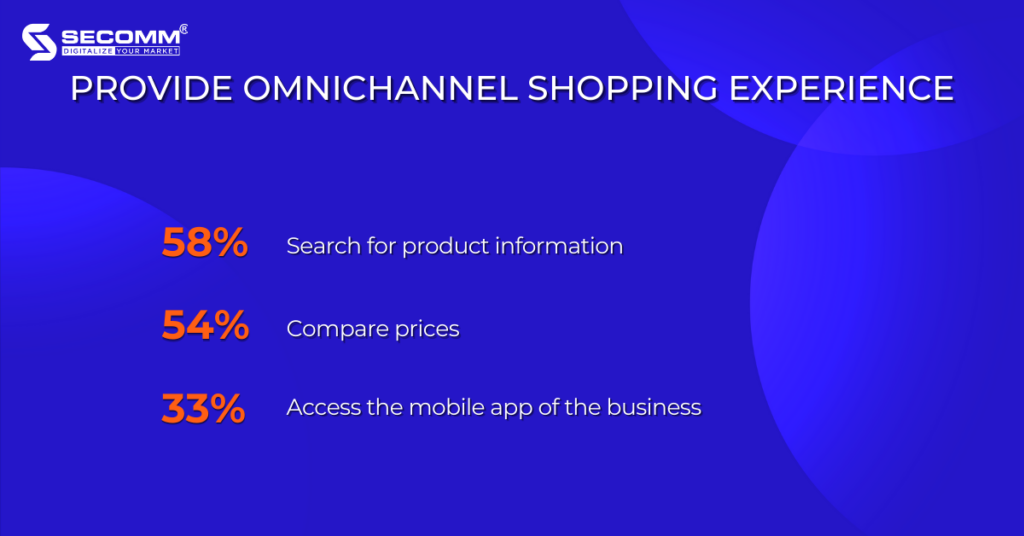
Therefore, by implementing Mobile Commerce, businesses can provide customers with a multi-channel shopping experience.
Mobile Commerce is exploding thanks to the boost from the Covid pandemic. Even though the pandemic has passed, the impact of Mobile Commerce on the development of eCommerce businesses is still significant. If businesses plan to approach Mobile Commerce in 2023, it is a wise decision.
Contact SECOMM today to learn more about Mobile Commerce and the best solutions to get started.
 2
2

 1,673
1,673

 3
3

 1
1
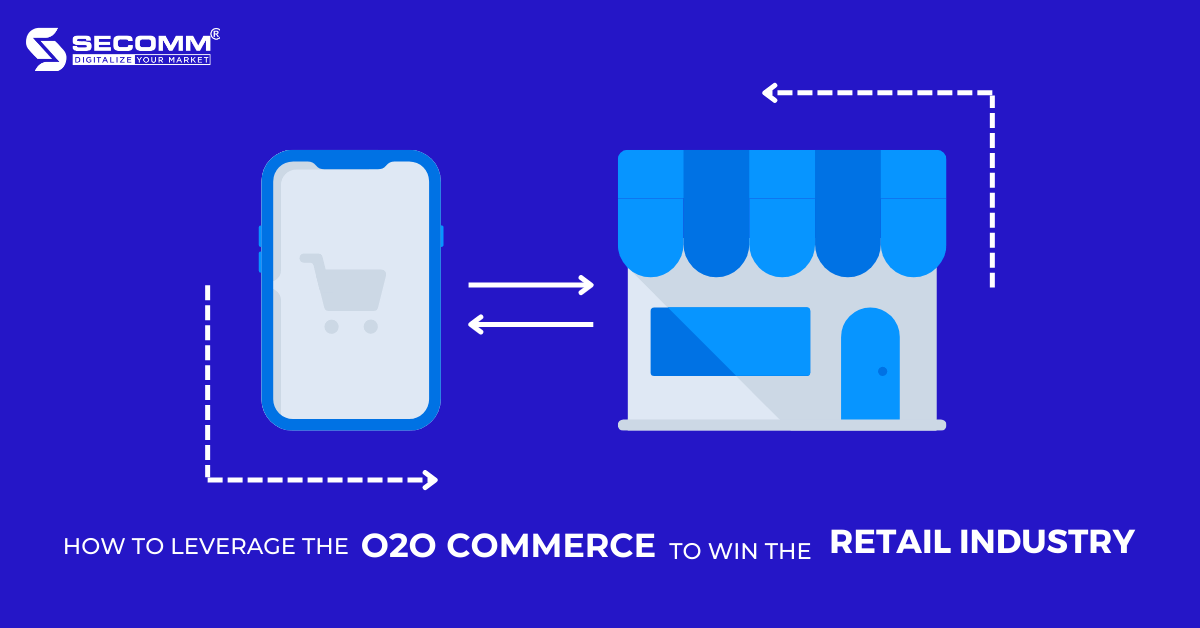
HOW TO LEVERAGE THE O2O COMMERCE TO WIN THE RETAIL INDUSTRY
Retails has miraculously recovered from the global pandemic and is expected to make a breakthrough in the years ahead. One of the ways to embrace eCommerce is the O2O model, which combines online and offline operations.
The benefits of implementing O2O Commerce
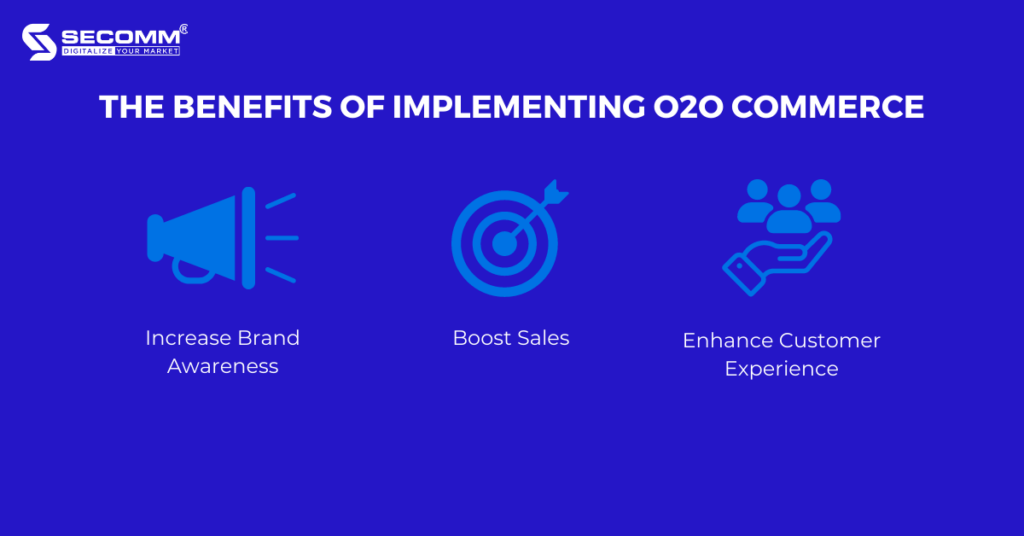
Increase Brand Awareness
One of the big challenges of physical stores is how to raise brand awareness among potential customers who are far from the store location. Using online-to-offline marketing strategies can increase the public’s awareness of a business’s brand. That way, businesses will be able to reach an influx of customers and boost their awareness of the brand and its products which then lead to higher sales volume and massive revenue.
Boost Sales
Despite the rapid development of eCommerce, brick-and-mortar stores still maintain stable sales because many customers still prioritize visiting stores to shop. A recent study indicates 46% of responders said they preferred shopping at a brick-and-mortar store because they want to touch, feel and try the products physically before making purchases. Another interesting fact is customers are likely to spend more money while in the store.
For example, a man comes to a bookstore to buy a notebook, then he looks around and decides to buy some more pens. In case he buys the notebook online, he may only buy it. Thus, the O2O Commerce model is a good choice as businesses can not only use online channels to raise brand awareness but also overcome the limitations of offline channels to earn massive revenue.
Enhance Customer Experience
The incredible combination of online and offline channels makes the customer shopping experience more seamless and interesting. Online platforms enable consumers to contact brands easily and immediately. When they want to ask for a product’s details, they can send a message through Facebook Messenger or a chatbot on an eCommerce website and the supporting team will answer their questions instantly.
Based on the customer’s data, businesses can offer product recommendations via online channels or the next time customers visit physical stores. In another case, if businesses run ad campaigns, they can notify their customers via online channels, which will help them to reach a larger audience with their online ad campaigns instead of just informing customers when they walk into the store.
Common strategies in O2O Commerce
BOPIS (Buy Online Pick-Up In-Store)
BOPIS is not a brand-new way to shop but has been around for a while. Merchants that provide this service can attract online shoppers to visit their brick-and-mortar stores. This way, customers will browse the eCommerce website to search for products, buy them and get notifications when the products are ready to pick up in the physical store. It’s convenient for customers to select a specific time to come to check and get their orders at the store. Merchants gain benefits too with amazing cross-sell and up-sell opportunities.
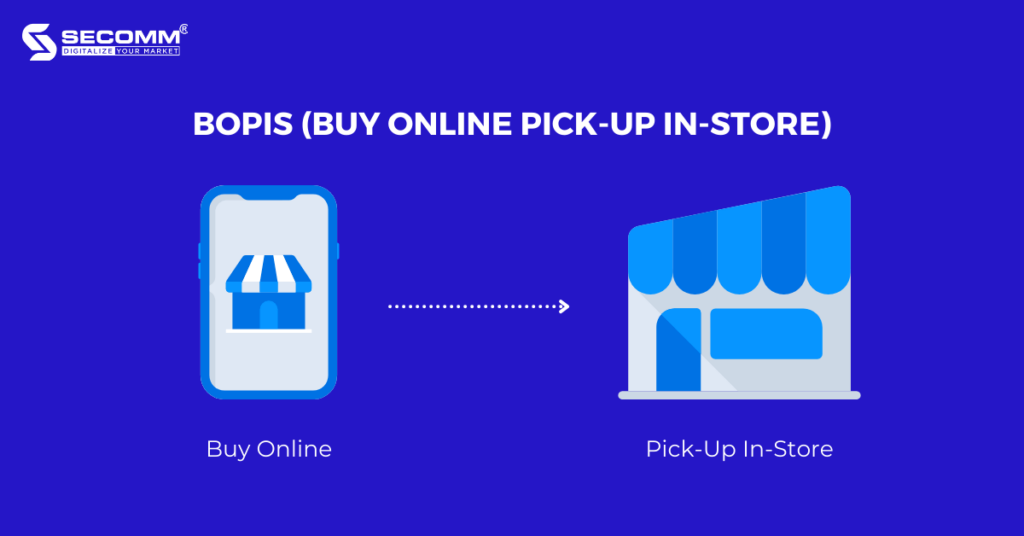
Home Delivery
Although BOPIS is great, it may not be every customer’s choice as not everyone likes to go to the store to pick up the products, instead people prefer home delivery rather than the in-store pick-up option. Sometimes, shopping at the store also causes many inconveniences, for example, finding a parking lot to go to the store in a densely populated area, picking up the goods, and returning to the car, seems time-consuming and annoying for busy people.
To solve this problem, merchants can self-deliver if the store location is close enough and convenient for the delivery process to be fast and efficient. Otherwise, collaborating with delivery companies like Giao Hang Nhanh, Giao Hang Tiet Kiem, and so forth, is a good choice when the business resources need to be increased.
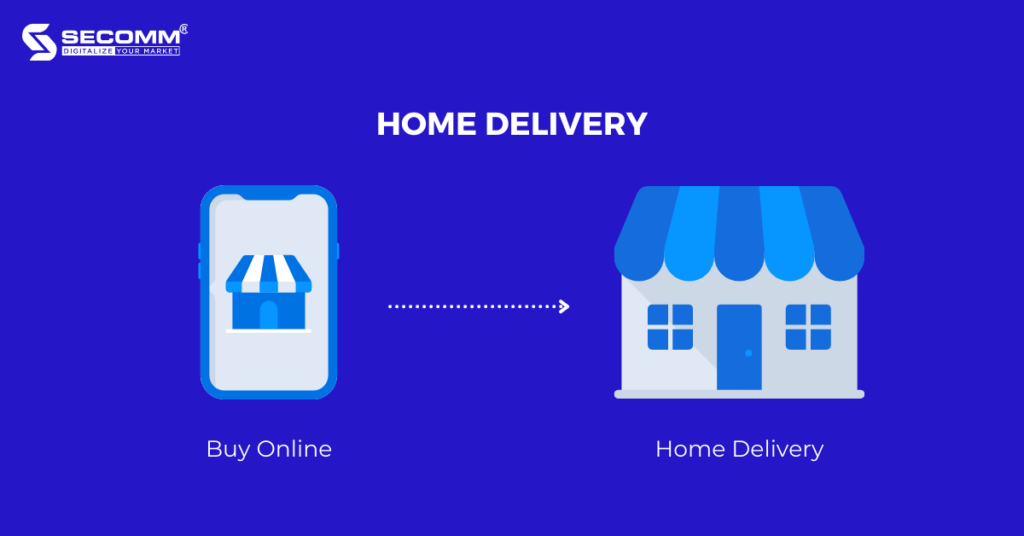
In-store Returns
Suppose a customer bought a product online but when receiving it, he realized it didn’t fit his demand. There was a store nearby, so he decided to return the product he bought there. But when he arrived, the staff there didn’t accept his return request because they had no clues of that purchase in the store’s system.
Therefore, he had to return his order to the carrier and wait a long time before receiving his refund. That will make consumers wonder whether they should keep shopping with that merchant next time. Thus, in-store return has become a fantastic offerable solution for customers to avoid the hassle of returning goods. This method simplifies the return process for shoppers and merchants because returns and refunds are processed simultaneously, which means better customer service and a much faster return to stock.
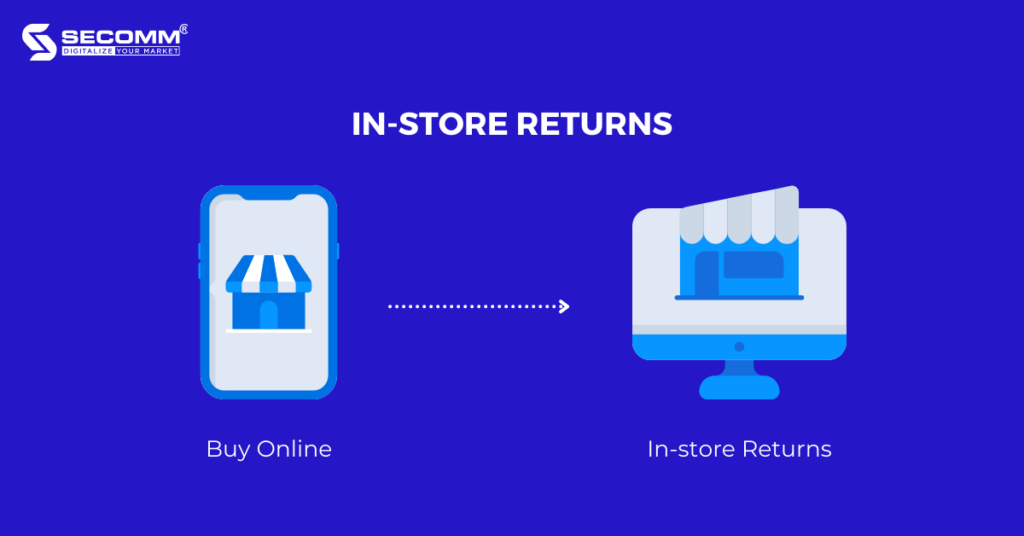
Loyalty Program
Loyalty Program is another great way to encourage customers to engage with the O2O shopping experience.
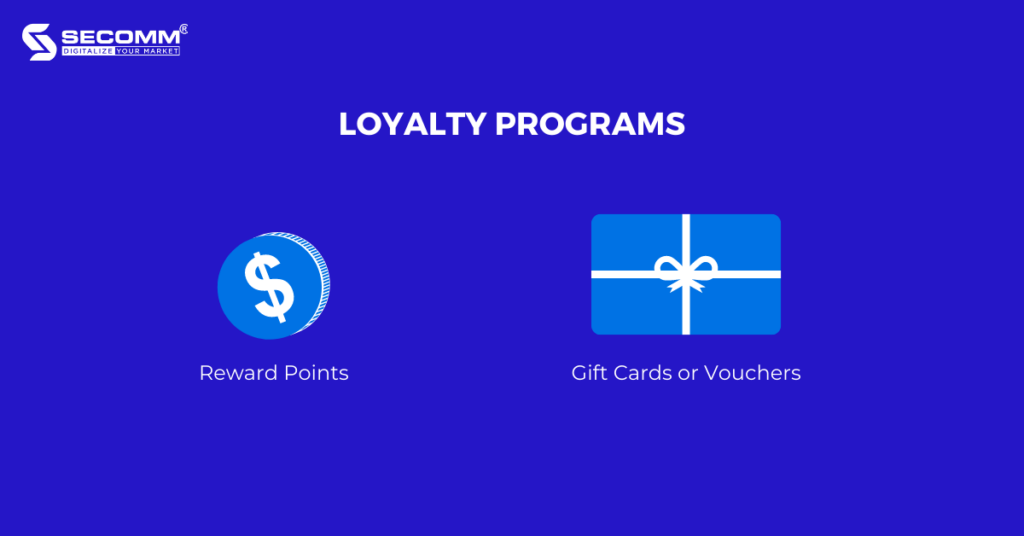
Reward Points
This is one of the popular types of loyalty programs. Every business can assign points to any items or user activities. While purchasing or joining any engaging program, customers will easily earn points afterward for later exchanging gift cards, vouchers, and even actual money which then encourages them to go back to spend more in order to get benefits from the gifts. As a result, reward points will boost sales and increase brand loyalty.
Gift Cards/Gift Voucher
Gift cards can be used not just as gifting options but also as a powerful tool to get customers to spend in their outlet. Customers can use gift cards immediately or save for later purchases, or even give it to relatives and friends. As a result, relatives and friends are likely to become potential customers of the brand soon.
How to implement O2O Commerce in business

Identify Objectives
The first thing to do is identify the main objectives. If businesses haven’t built their online presence, they should do it immediately due to the rise of online shopping. If businesses already have their online presence (eCommerce website, mobile app, marketplace), it’s important to adjust their O2O Commerce strategy to increase sales online, offline, or both. They should also consider using some measurable metrics to ensure these objectives are appropriate and achievable.
Brainstorm Strategies
Next is working with a team to raise ideas for the O2O Commerce strategy. Here are a few suggestions:
- Use performance analysis software to find out customer challenges in the purchasing process.
- Use social media to connect the brand’s eCommerce store to its physical store.
- Implement the BOPIS process.
- Provide home delivery for some or all items for both online and in-store purchases.
Then use these data to decide which strategies to try.
Measure Outcomes
Once deciding on strategies to deploy O2O Commerce, businesses will use collected data to measure the success of those strategies and make the next business decisions. Looking back on the initial objectives when evaluating and adjusting the O2O marketing and business strategy, then considering the additional objectives if the original ones have been achieved.
O2O Commerce solution at SECOMM
Founded in 2014, SECOMM is specialized in providing O2O Commerce solutions. Over the years, SECOMM owns a massive fortune of O2O commercial projects with major domestic and international customers such as, Annam Gourmet, Trentham Estate, etc.
In particular, SECOMM provides a variety of services to support businesses to improve their competitiveness and dominate the retail market in the digital age including Solution Consulting, Core-team Building, and O2O System Development, including:
Business System
- eCommerce system: websites, mobile apps
- POS system
Administration System
- Enterprise Resource Planning (ERP)
- Customer Relationship Management (CRM)
- Product Information Management (PIM)
Customer Experience Management System
- Mobile Apps
- Loyalty Program
- Omnichannel Commerce
Data system
- Analyzing and Tracking business data
- Business Intelligence
Want to learn more about O2O Commerce as well as the best solutions to win the retail industry? Contact SECOMM now for a free consultation.
 2
2

 1,906
1,906

 0
0

 1
1
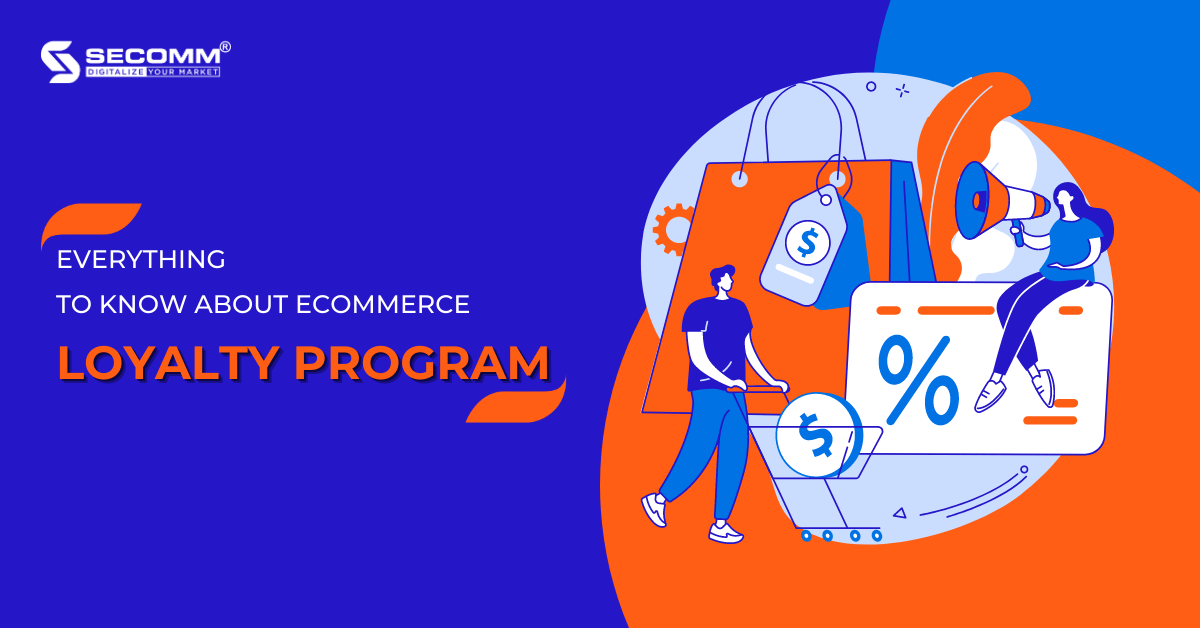
EVERYTHING TO KNOW ABOUT ECOMMERCE LOYALTY PROGRAMS
In the world of eCommerce, customer loyalty plays an important role in the success of businesses amidst fierce competition. There are many ways to build and maintain customer loyalty, but one of the most prominent is to enhance the customer experience through loyalty programs.
The Importance of Customer Loyalty for eCommerce Businesses
Sometimes businesses focus too much on finding new customers and forget the value of their existing customers. The following statistics show how valuable it is to maintain customer loyalty:
- The probability of selling to an existing customer is 60%-70%, whereas, the probability of getting a prospective customer to buy products from you for the first time is only 5% to 20%.
- 65% of sales come from existing customers.
- Compared to new and prospective customers, existing customers are 50% more likely to try out new products.
- 80% of future profits will come from just 20% of your existing customers.
- Loyal customers spend an average of 31% more than new customers.
- 32% of executives worldwide said customer retention is their top priority.
- Increasing customer retention by even 2% has the same impact on profitability as cutting costs by 10%.
- 75% of loyal customers will recommend the brand to friends and family.
Existing customers are the best customers and the most valuable asset of an eCommerce business. These customers contribute greatly to the business profit and help businesses save time and money to acquire new customers.
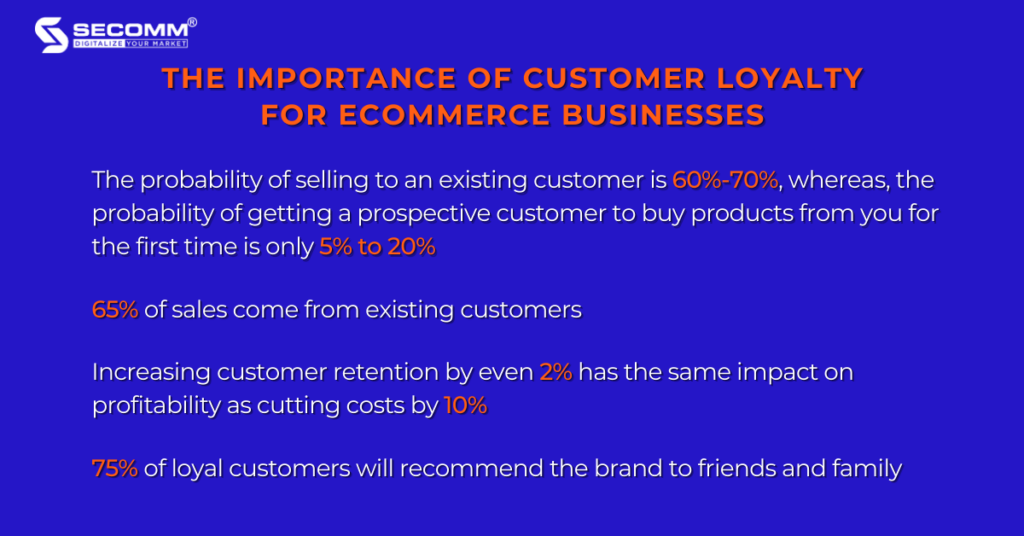
What affects Customer Loyalty?
89% of eCommerce businesses around the world agree that the customer shopping experience affects customer retention. A high customer retention rate indicates that customers are happy and satisfied which leads to increased loyalty and repeated purchases.
Retaining customers plays an important role in eCommerce businesses because the cost of attracting new customers is five times higher than maintaining existing ones. Moreover, increasing customer retention by even 5% can increase business profits by up to 95%. This is because satisfied customers are likely to refer the brand to others.
Therefore, businesses need to focus their time, money, and energy on enriching the customer experience, persuading them to come back to shop more often, and recommending the brand to friends and family.
Among the various strategies for maintaining customer loyalty, Loyalty Program is one of the most effective factors for eCommerce success.
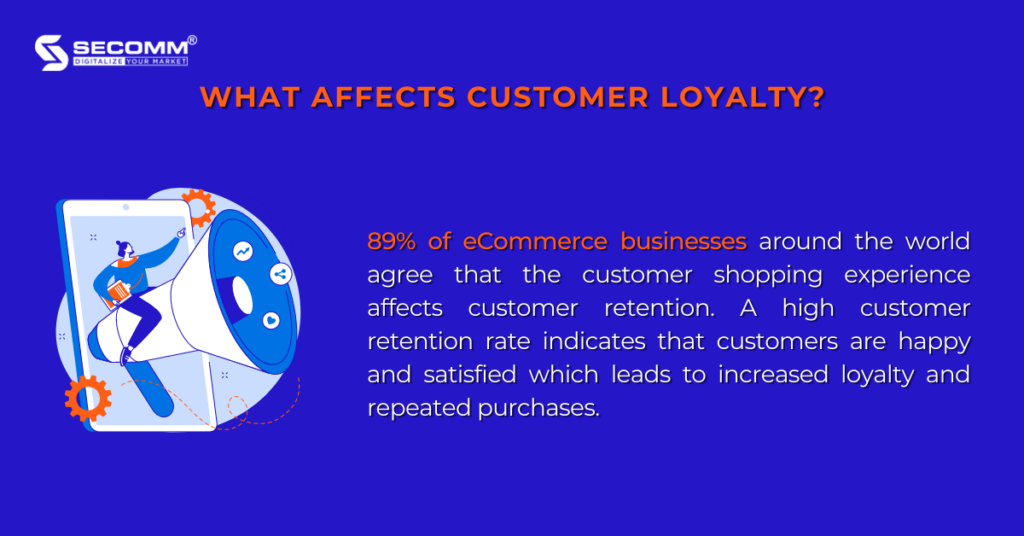
What is an eCommerce Loyalty Program?
A loyalty program is a marketing strategy designed to encourage customers to continue to shop at or use the service of a business associated with the program. Simply put, eCommerce businesses build loyalty programs to reward customers for their purchases and engagement for a long time.
The reward can be any free product, discount code, or special offer to represent the appreciation of the business for its customers, who tend to spend more because of the benefits they receive when participating in loyalty programs.
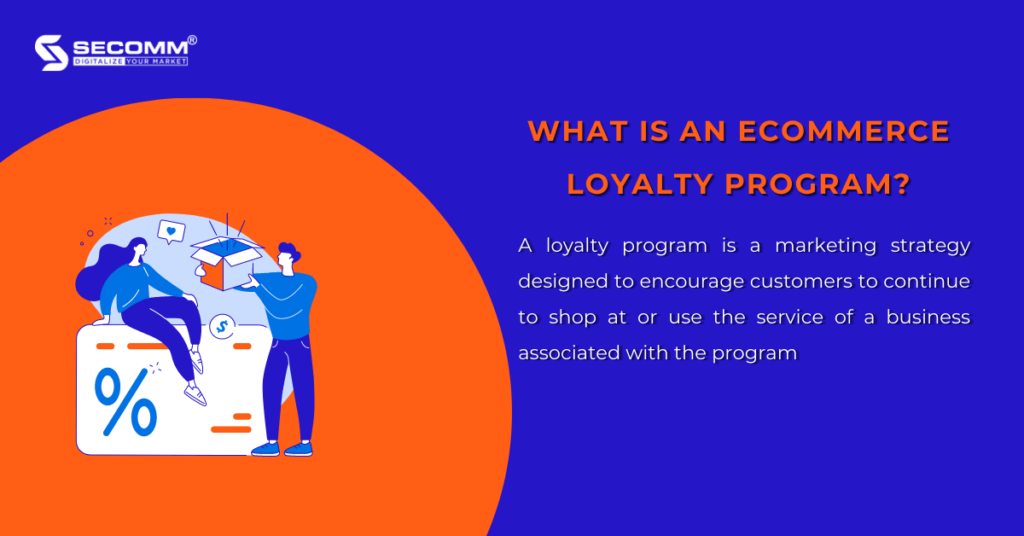
According to Yotpo, nearly 68% of customers said they would be willing to join the loyalty program and special incentives motivates them to buy more products.
Loyalty programs not only enrich the shopping experience and keep customers engaged with the brand but also from a business perspective, the benefits they bring to eCommerce businesses exceed the initial expectation.
The Benefits of Using eCommerce Loyalty Programs
Increase Customer Retention
The development of eCommerce helps customers shop more conveniently. That means their expectations for the shopping experience are higher. Today’s customers make their purchasing decisions not only based on price but also other factors such as service experience or emotional connection with the brand, etc.
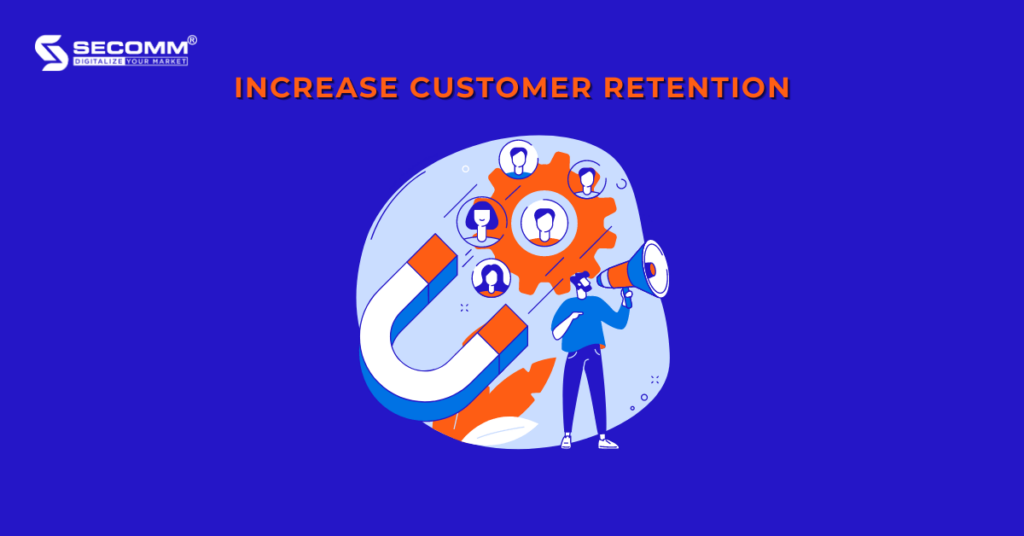
According to HuffPost, 66% of customers tend to switch brands for shopping if the service is not good enough. Loyalty programs help enhance the shopping experience. The more shopping satisfaction, the more customer retention and loyalty.
Increase Customer Lifetime Value
Customer Lifetime Value or CLV is a key metric that indicates the total revenue an eCommerce business can reasonably expect from a single customer account throughout the business relationship. Most business owners will always find ways to increase the CLV index in order to maximize their profit.
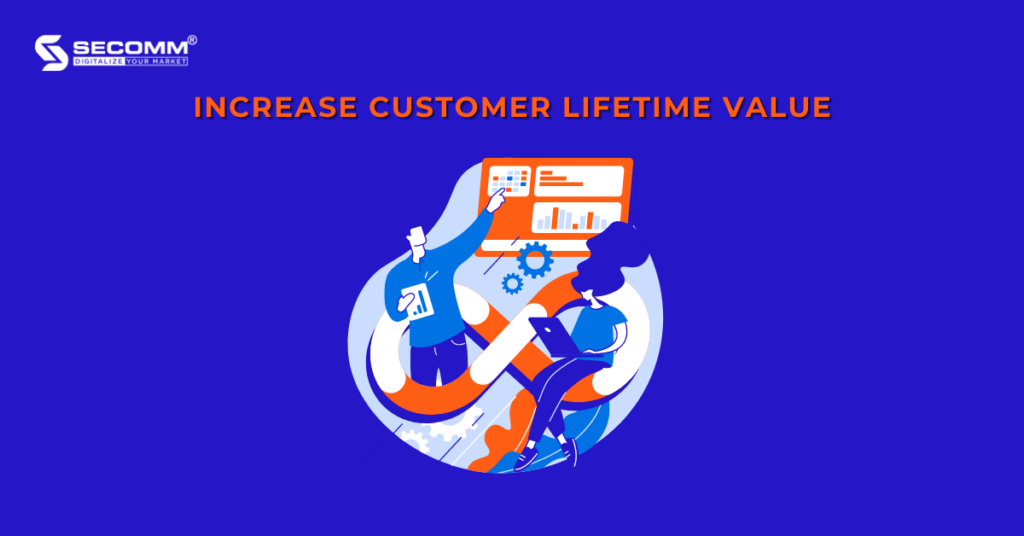
According to Harvard Business Review, the cost of acquiring a new customer is more expensive, ranging from 5 to 25 times, compared to retaining an existing customer. As a result, high lifetime value customers become priceless assets for a business, as their purchases will not require acquisition costs. In other words, a business doesn’t have to incur acquisition costs for loyal customers.
On the other hand, the business has to spend acquisition costs to convince potential customers to buy its products. Thus, even if a new customer spends the same amount on a product as an existing customer, it may not bring in equivalent profits because of acquisition costs.
Encourage Brand Advocates
In most cases, existing customers are also the most incredible advocates. When customers are satisfied with the shopping experience, they are more likely to share it with their family, friends, or colleagues, and the business will gain more potential customers naturally.

Compared to brand messages, recommendations from existing customers are even more effective. According to Nielsen, 77% of consumers trust recommendations from people they know more than any other source. As a result, before making a purchase, they will seek advice from people they trust. Plus, 64% of marketing experts believe that word-of-mouth marketing is one of the most effective forms of marketing.
With the development of the Internet and social media platforms, recommendations from existing customers come in various ways, including posts, comments on social media or review videos, etc. This helps reduce acquisition costs so that every eCommerce business needs to focus on enhancing their existing customer shopping experience and new customers will end up rolling in for free.
Types of eCommerce Loyalty Programs
Point-based Loyalty Programs
This is one of the most popular eCommerce loyalty programs since it is easy to set up and manage. By joining this type of program, customers can earn reward points after each purchase. They can then redeem their accumulated points for rewards such as gifts, discount codes, and other special offers. They also can earn reward points in many other ways besides making purchases, such as sharing product pages on social media, writing product reviews, completing surveys, filling out personal profiles, and so forth.
Although this type of program is relatively simple to implement, businesses still need to ensure that the points customers earn have enough value to encourage them to continue shopping. Plus, the time it takes to redeem points for rewards should be short enough because if customers have to wait for several months or even years to redeem points for a valuable reward, the attractiveness of the points-based program will decrease.

SHEIN, a popular fashion brand founded in 2008, has created a great SHEIN Bonus Point Program reward system on its mobile app. This program allows customers to earn points by registering an account, making purchases, reviewing products, and participating in special online events held by the brand.
Each activity equals a specific reward point. Then, customers can use their reward points to receive discounts ranging from 15% to 25%, and even up to 70% for their next purchase. Additionally, reward points can also be used to exchange vouchers or other special offers when customers participate in SHEIN events or play games on the mobile app.
Tier-based Loyalty Programs
Another popular loyalty program is the tiered-based one. It encourages customers to strive to move up higher tiers to receive more valuable benefits and rewards. The more customers spend on shopping, the more benefits they receive.
This program helps to foster customer loyalty to the brand. To maintain or move up in rank, customers have invested a lot of time and money, and they will not easily give up the huge benefits they are receiving to participate in another brand’s loyalty program.
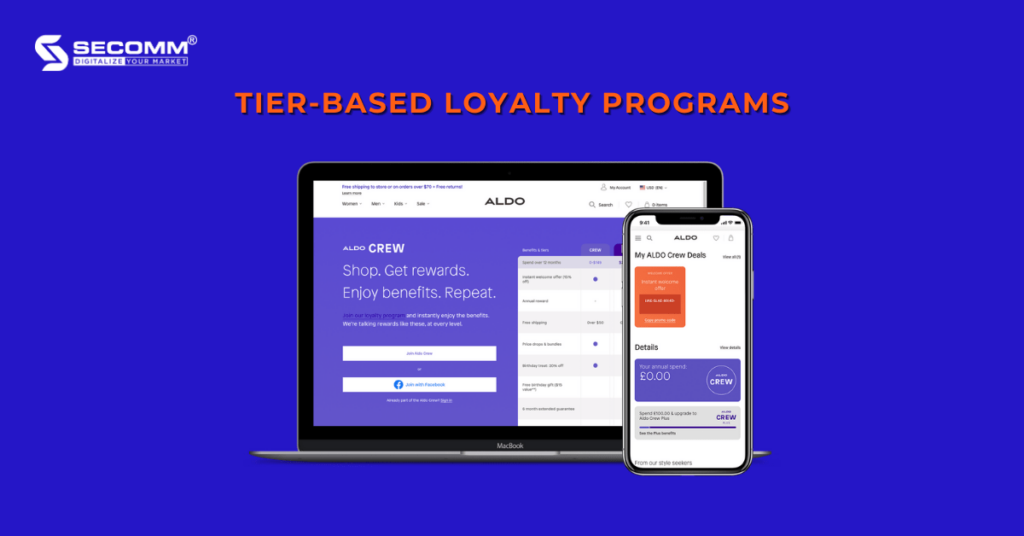
The famous shoe brand Aldo, with over 1,000 stores in 65 countries, focused on 3 main markets – the US, the UK, and Canada – when building their loyalty program. Known as Aldo Crew, the program offers customers three levels of membership: Crew, Plus, and VIP. All customers are initially enrolled as Crew level members. To advance to the Plus or VIP levels, customers must spend between $150-299/month for the Plus level and over $300/month for the VIP level. Depending on the level, each customer receives corresponding rewards, and VIP-level customers receive all the special perks offered by the Aldo Crew program.
Subscription-based Loyalty Programs
eCommerce loyalty programs are very attractive because, from the customer’s perspective, they get benefits for free. However, in reality, customers have to make a purchase or perform a specific action to earn those “free” benefits.
Many world-renowned brands have created incentive programs based on subscriptions to provide incredible services and charge customers for participation. Amazon Prime, eBay Plus, and Walmart+ are some examples.

To participate and receive truly valuable benefits, customers are required to pay a fee. Since customers have to pay a fee, their commitment to engaging with the brand is also higher than in other loyalty programs. Also, because businesses charge customers when they register as members, this loyalty program type usually has a trial period for businesses to convince customers that the benefits they receive are worth the money they spend.
In 2020, the famous American retail chain Walmart launched a subscription-based loyalty program called Walmart+. The program is integrated into the Walmart app and offers many special benefits to customers both in-store and online, including:
- Free delivery and same-day pickup
- Free delivery with no minimum order value
- The same prices for products purchased online and in-store
- Scheduling delivery options
- 10-cent discount on gasoline at over 14,000 Walmart branches
- Scan-and-go checkout option
- Special member-only deals and promotions during holidays and events, etc.
To join the program and enjoy these benefits, customers have to sign up and pay a specific membership fee of $12.95/month or $98/year. Customers can try the program for 30 days before committing to a membership.
The loyalty program strategy plays an important role in customer experience which leads to their loyalty to the brand. The success of SHEIN, Aldo, and Walmart has become an inspiration for other eCommerce businesses to jump into the game.
To learn more and develop the best loyalty program strategy, contact SECOMM now for a free consultation.
 2
2

 1,920
1,920

 0
0

 1
1
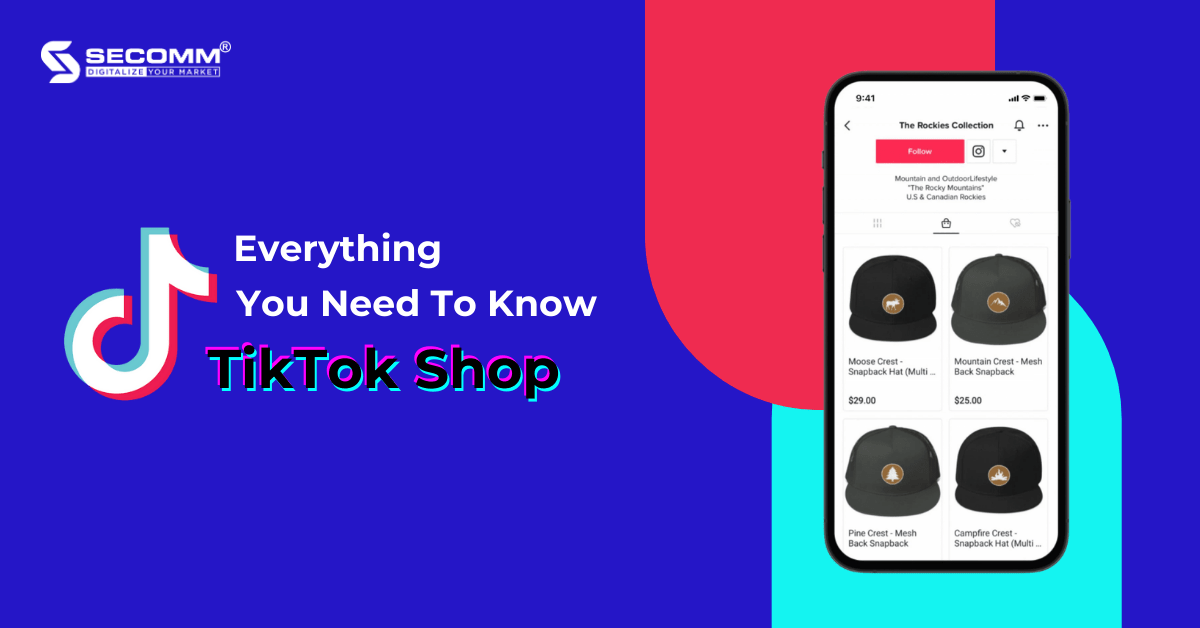
WHAT IS TIKTOK SHOP? EVERYTHING YOU NEED TO KNOW?
Along with the development of technologies, social platforms like Facebook, Instagram, and Twitter have been around to satisfy the demand for online interaction for over two decades. However, the change in consumer behavior makes TikTok the new favorite.
By the end of 2022, TikTok was reported to reach 1B users globally, becoming the fastest-growing social platform ever. Having a large user base amid the rise of online shopping is an advantage, which contributes to TikTok’s ongoing transition into a Social Commerce platform.
Recently, the social media platform has added a new buying and selling feature called TikTok Shop. It is a new solution for businesses of all sizes to boost customer engagement, brand awareness, and sales.
What makes TikTok special?
The content of TikTok consists of vertically arranged videos that are compatible with smartphones and users only need to swipe up to watch a series of videos that are only a few seconds to one minute long. Creating content on TikTok is also easy and simple, users only need to upload the original video and add a few effects, then they will have an interesting and fun short video. With over 1 billion videos viewed on TikTok every day, it has opened up marketing opportunities for many brands.
The majority of TikTok users are Millennials and GenZ, and it now expands to even younger users. They are a driving force behind the increasing expectation of digital experiences. Over 55% of GenZ in Vietnam are using TikTok, in the US, 62% of people between the ages of 10 – 29 are using this social network. The attention span of Millennials is about 12 seconds and for GenZ it’s around 8 seconds. Therefore, TikTok’s short-length videos are particularly popular with these generations because of their easily consumable content.
When compared to Reels (a feature of Instagram) and Short (a feature of Youtube), TikTok even has the upper hand. As The Graygency has noted, the monthly user base of IG Reels is in the lead with 2 billion users, followed by Youtube Shorts with 1.5 billion, and finally TikTok with 1.2 billion. The Reels feature was launched in 2020 and immediately became popular due to Facebook and Instagram’s enormous existing user base. The same is true for Youtube Shorts.
Meanwhile, TikTok was launched in 2016 but has reached 1 billion users in just 5 years. For Instagram and Youtube, this number took 8 years. A new player like TikTok when compared to the 2 major social platforms with a not-so-significant difference in user base, makes TikTok incredibly special. Plus, when considering other criteria like Engagement Rate, Female Users, Male Users, etc, TikTok even has higher rates than IG Reels and Youtube Shorts.
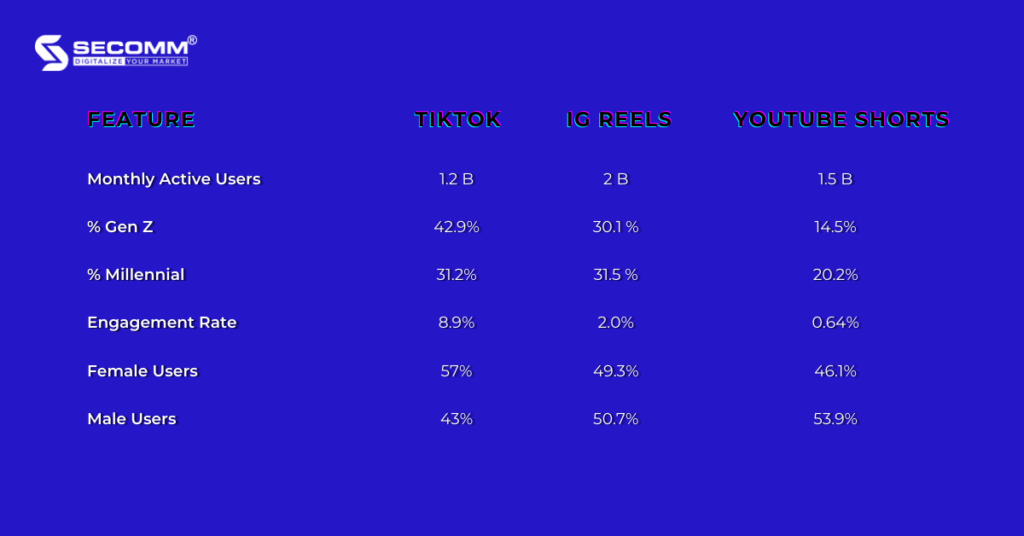
Another thing that makes TikTok special lies in its algorithm. When opening the app, users will see the “For You” page where TikTok displays videos that users may be interested in and immediately capture their attention. However, these videos don’t come from creators or brands that the user is already following but from the users’ interactivities on the videos, which is completely different from other social media platforms.
The “For You” page is the most successful feature of the app as it creates content every second specifically tailored to each user’s personal preferences. These successes have led to a new step for the social platform – TikTok Shop
What is TikTok Shop?
TikTok explained in its launch statement:
“TikTok Shopping is a suite of solutions, features, and advertising tools that give businesses the opportunity to capture the full power of TikTok’s influence on purchase decisions”
Simply put, TikTok Shop is a new feature that allows TikTok users to buy products right on the app. Also, it provides businesses a way to display, promote and sell their products to a huge user base on TikTok.
After setting up the TikTok Shop feature, a dedicated shopping tab will appear on the brand’s profile. That way, customers can browse through and purchase within the TikTok app or be transferred to the brand’s eCommerce website for checkout.
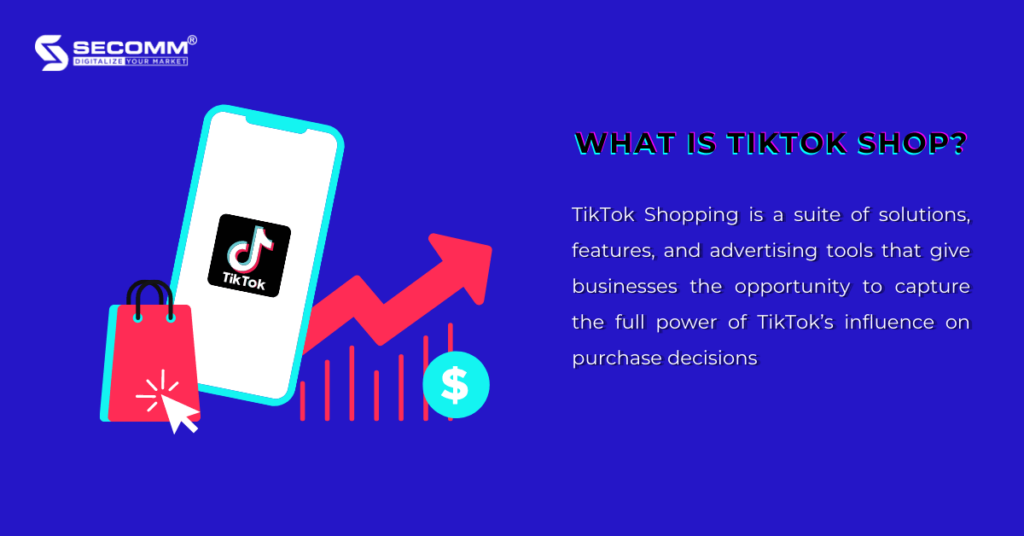
TikTok Shop Live
Besides the TikTok Shop feature, TikTok Shop Live is also a great resource to take advantage of. Brands can integrate their products from TikTok Shop into their live stream to encourage customers to interact with the brand and whenever they see a product they like, they can buy it during the live shopping stream.
Let’s see the key TikTok Live Shopping stats:
- 50% of TikTok users have bought something after watching TikTok Live;
- Users on TikTok are 50% more interested in branded Live content than non-TikTok users;
- 1 in 5 users watch TikTok Live and of that group 62% watch it every day
- TikTok users are two times more likely (compared to non-TikTok users) to say the live stream is the most trustworthy to use when shopping.
Ha Linh, a female beauty vlogger in Vietnam, is widely recognized by everyone in the Vietnamese beauty community for her genuine product review videos. She fearlessly provides critical feedback on any brand, and her reputation precedes her. Recently, Ha Linh held her first live stream on TikTok, which incredibly got 11 million hearts and 80K views. To everyone’s surprise, within an hour, all the products from the three factories of the brands she collaborated with were sold out. This case highlights the effectiveness of influencer marketing campaigns in conjunction with TikTok Live Shopping for brands targeting young customer demographics.
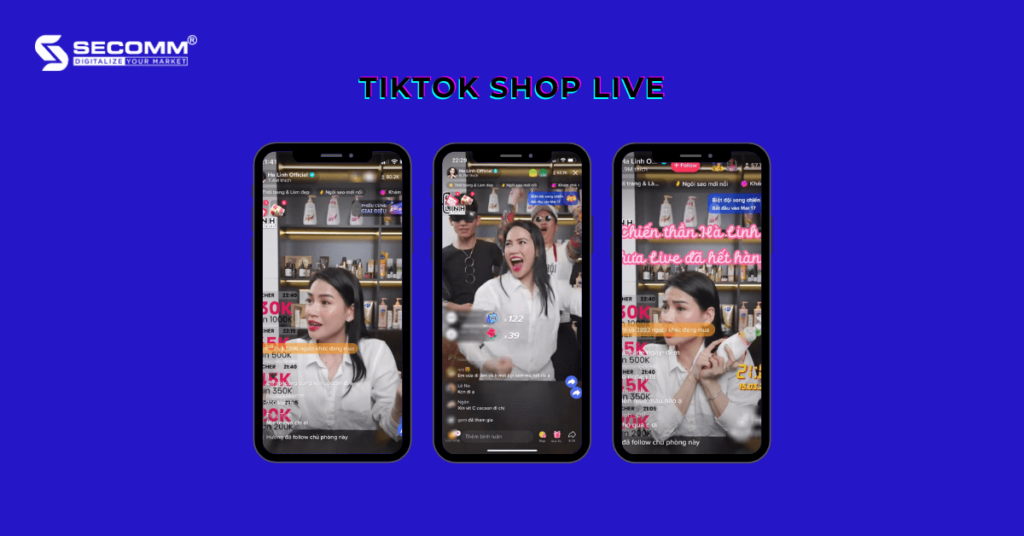
Why brands need to embrace TikTok Shop?
Keep up with Social Commerce
According to research, 87% of customers make their purchasing decisions through information provided on social media, 90% discover brands through social media, and the average spent per day on social media is over 2 hours. This is a new great boost for Social Commerce globally. In 2022, global Social Commerce sales reached $992B and are estimated to exceed $3 trillion in 2026.
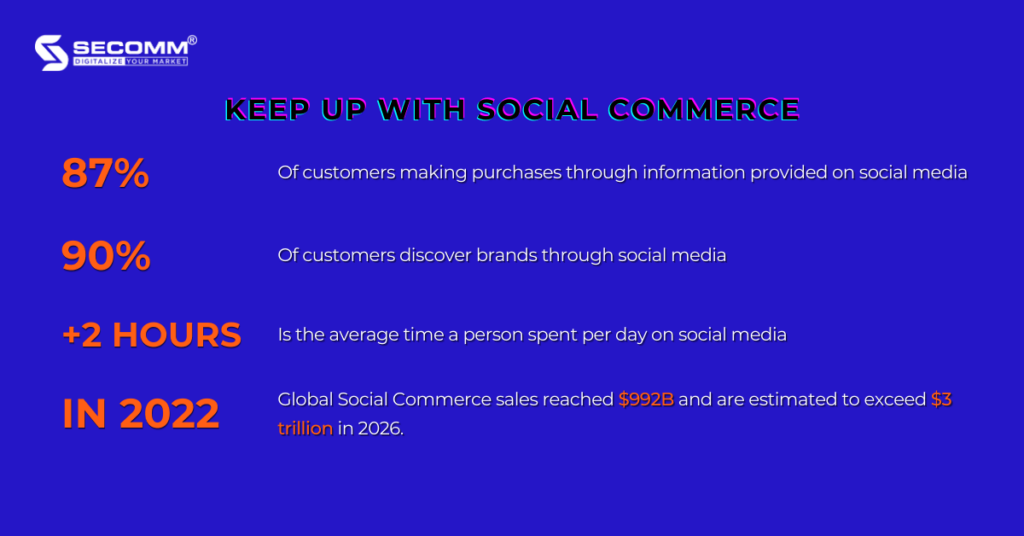
With a massive user base of over 1 billion, TikTok has the potential to become the leading platform in global Social Commerce, and the TikTok Shop feature has been launched to achieve that goal. TikTok Shop is currently available in Europe, North America, and 7 Asian markets, including Vietnam.
The short videos on TikTok are already very appealing, and when combined with cleverly integrated advertising content, they can attract users’ attention. This not only entertains and engages users, but also motivates them to make purchases from the advertised shoppable content. According to data compiled by TikTok, 67% of users have purchased after watching a video even if they didn’t intend to do so beforehand.
Thus, TikTok has created an infinite loop of shoppertainment that combines shopping and entertainment within the app. As TikTok prioritizes user-generated content and 83% of its users have created videos on the platform, after purchasing, they are more likely to share their experience with other people on the app. This ultimately creates an endless loop of shopping, discovery, consideration, purchasing, reviewing, and engaging that repeats itself.
Reach out to a large user base on TikTok
The majority of TikTok users are in the age range of 18-34. According to Statista, as of January 2023:
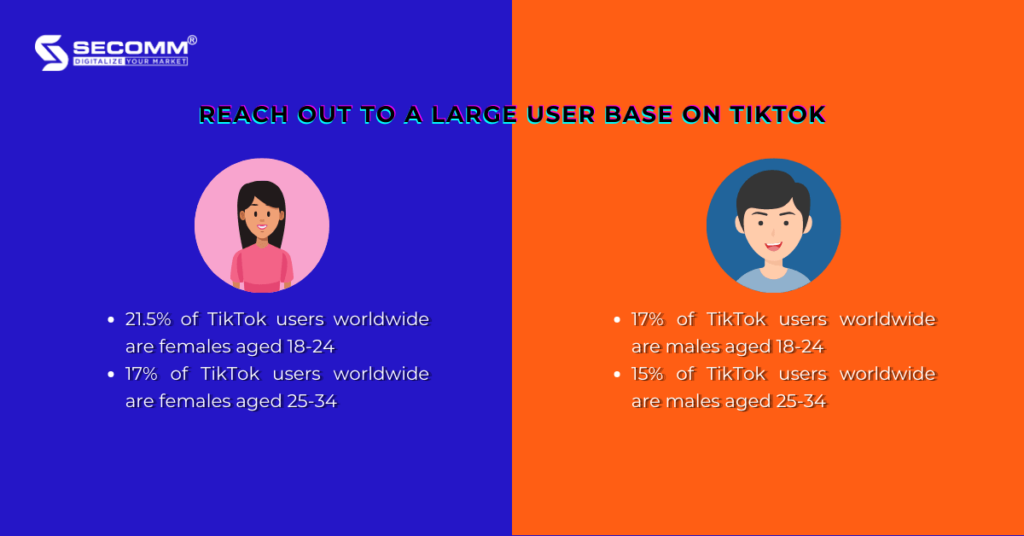
Bên cạnh đó, những danh mục nội dung phổ biến nhất trên TikTok bao gồm giải trí, thể thao/fitness, nấu ăn, mỹ phẩm, thời trang,…
Do đó, nếu các doanh nghiệp đang kinh doanh trong những lĩnh vực này và hướng đến phân khúc khách hàng trẻ tuổi thì xây dựng hiện diện nhanh chóng trên nền tảng TikTok và tận dụng tính năng TikTok Shop là điều cấp thiết phải triển khai, như cách mà Kylie Cosmetics đã làm.
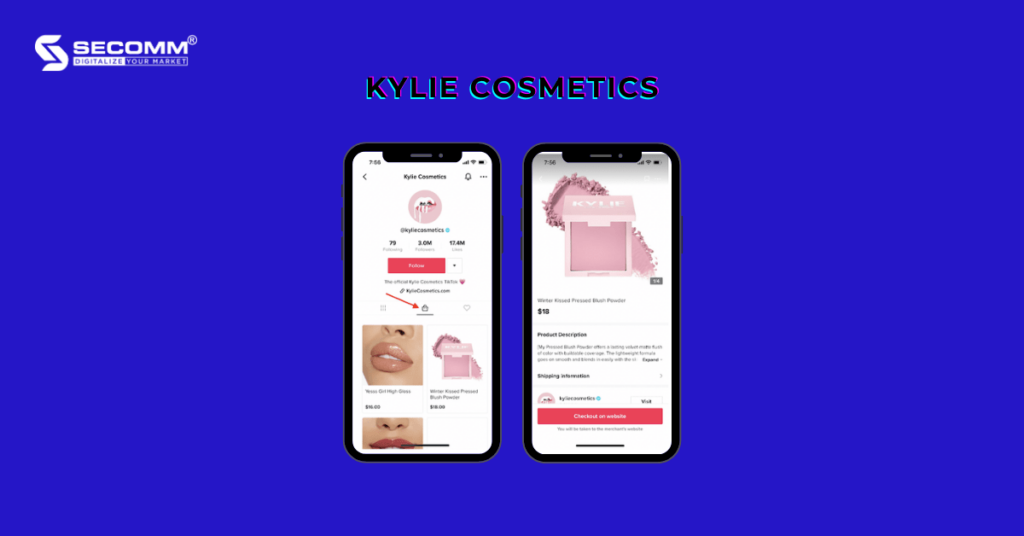
Moreover, the most popular content categories on TikTok include entertainment, sports/fitness, cooking, cosmetics, fashion, etc. Therefore, for businesses operating in these fields and targeting younger customer segments, building a quick presence on TikTok and leveraging the TikTok Shop feature is crucial to implement, as Kylie Cosmetics has done.
As soon as TikTok Shop was launched in the US market, Kylie Cosmetics was one of the first brands to get involved. To date, the brand’s TikTok account has over 3.5 million followers. Kylie Jenner once explained: “I built my business on social media; it’s where my fans go first to look for what’s new from Kylie Cosmetics. I have so much fun creating TikTok videos, and I love sharing posts of my fans using the products. That’s why I’m excited for Kylie Cosmetics to be one of the first to let customers shop directly on our TikTok!”.
Take advantage of TikTok Influencer Marketing
If Influencer Marketing plays a crucial role in the brand’s success on other social platforms, TikTok is no exception. This strategy is primarily used to increase brand awareness, run promotional campaigns, and boost sales. TikTok is a place for creative and engaging short videos, so TikTok users have a special love and interest in creators with their unique style and creativity that attracts users’ attention.
TikTok Influencer Marketing is where business brands and personal brands are closely linked. Thus, some experts advise that in order to successfully implement TikTok Influencer Marketing, businesses should let their partners freely create promotional content as long as it meets ethical and cultural standards. This is because if TikTok videos are too focused on advertising, it will make users or potential customers “turn away”.
Walmart, the American retail chain, recently sponsored a dance challenge called “SavingsShuffle”, which required players to show how to save money while shopping at Walmart with their creative fun dance moves, and then post the recorded video on TikTok. Six influencers were chosen to promote this campaign, including Trinity, AdamW, Sam Hurley, Bdash, Kidrl, and Ajani.
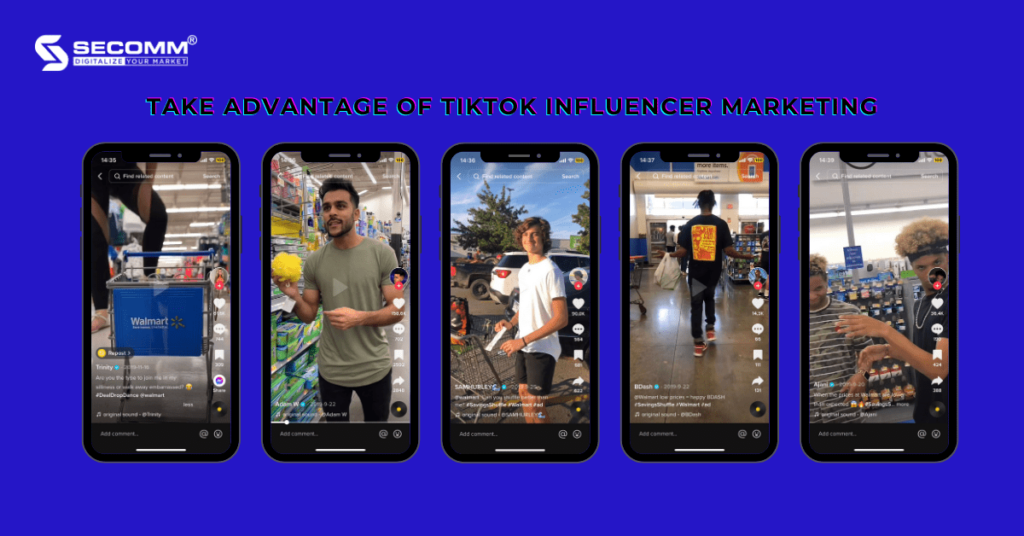
Selling on TikTok VS eCommerce Marketplace
- eCommerce marketplace: Brands and merchants have to rely heavily on the policies of eCommerce marketplaces, prices, products must be competitive, storefronts must be high-rated, etc.
- TikTok: This is a fair playing field for all brands and merchants. By creating attractive content and cleverly incorporating promotional elements, they can increase sales and their followers. However, participating in the high-level sales race on TikTok requires brands and merchants to invest more in creativity.
With many years of experience in successfully implementing eCommerce for many customers in many countries, SECOMM understands the difficulties and challenges of implementing eCommerce. Talk to our expert to get free advice on eCommerce implementation.
 2
2

 2,800
2,800

 1
1

 1
1
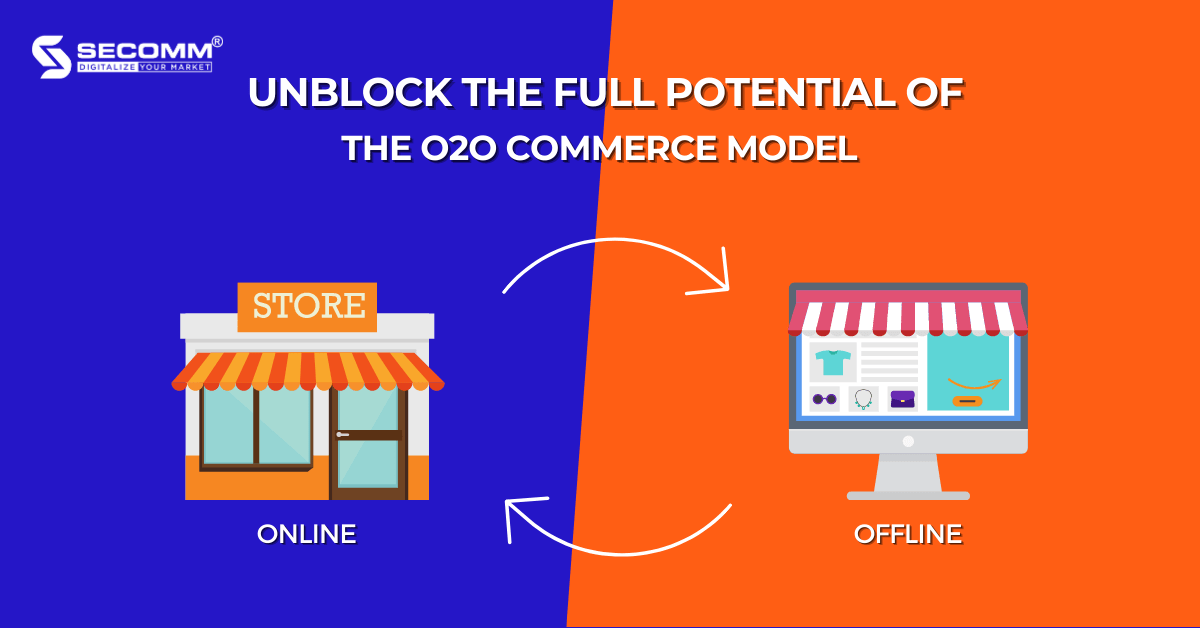
UNBLOCKED THE FULL POTENTIAL OF THE O2O COMMERCE MODEL
After Covid, eCommerce is on the rise and is expected to continue to thrive stronger and more resilient than ever. Global retail eCommerce sales reached $4.9 trillion in 2021, as stated by Statista. By 2025, this figure is projected to increase by 50% to approximately $7.4 trillion and there is no sign that the growth of online shopping will slow down anytime soon.
The expansion of eCommerce has raised concerns among physical store owners and urged them to embrace eCommerce quickly to avoid being left behind. It’s simple for businesses with a large budget, but other small and medium-sized businesses will not be able to move their entire operations online. Thus, the O2O Commerce model is the solution worth considering. Its popularity has been raised since 2021 and is expected to reach retailers soon.
What is O2O Commerce?
O2O or Online-to-Offline Commerce Model is a business strategy that draws potential customers from online channels to make purchases in brick-and-mortar stores. This model aims to create a seamless shopping experience at all stages: before, during, and after purchasing.
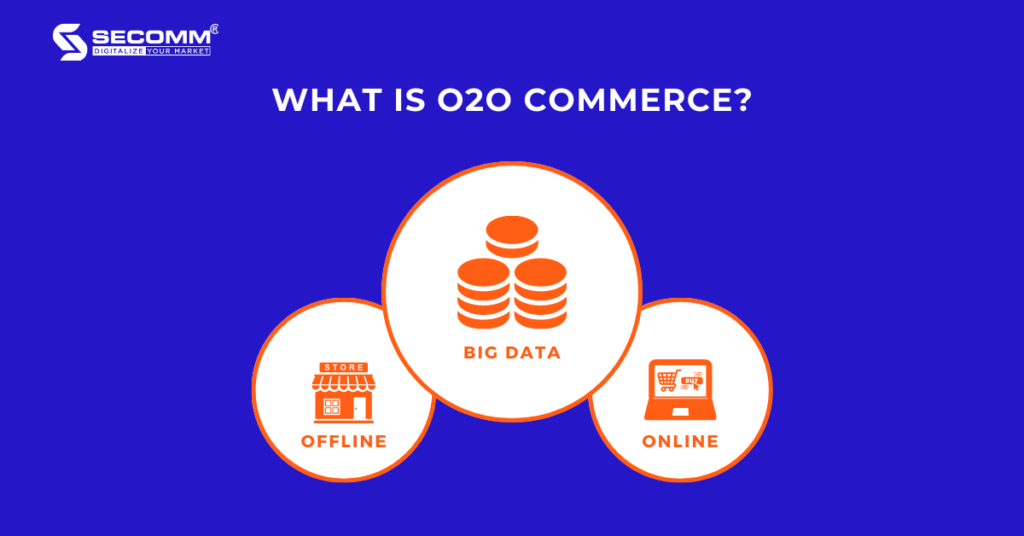
How does O2O Commerce work?
O2O Commerce combines online and offline business models. Its objective is to increase product awareness online, allowing customers to search for what they need before visiting a physical store to make a purchase. There are some O2O strategies that businesses can try including Buy Online Pick-up In-store (BOPIS), In-store Returns, Home Delivery, etc
For example:
- A man wants to buy a shirt from a particular fashion brand;
- He searches for it online and goes to the web store that sells the product he is interested in;
- Then, he chooses the shirt’s size and color, applies a discount code, and makes a purchase;
- He goes to a local store and picks up the shirt by providing his information;
- He tries on the shirt he ordered in the store to check its quality, size, and comfort. If he is not satisfied with the product, he can return it and get a refund.
That way, the customer can both take advantage of the discount code for the shirt, and try it on at the nearest store without having to wait for delivery. Moreover, he can completely return the shirt immediately and go to another store if he is not satisfied.
Home Delivery is also another popular strategy in the O2O world. It will take a few hours or a day. So, the man can buy his shirt online, select the home-delivery option and wait to get it. In another case, when going to the store to pick up the shirt, he sees and likes a jacket but needs help finding the right size or favorite color. He simply places an order online while in store and that desired jacket will be delivered to his door.
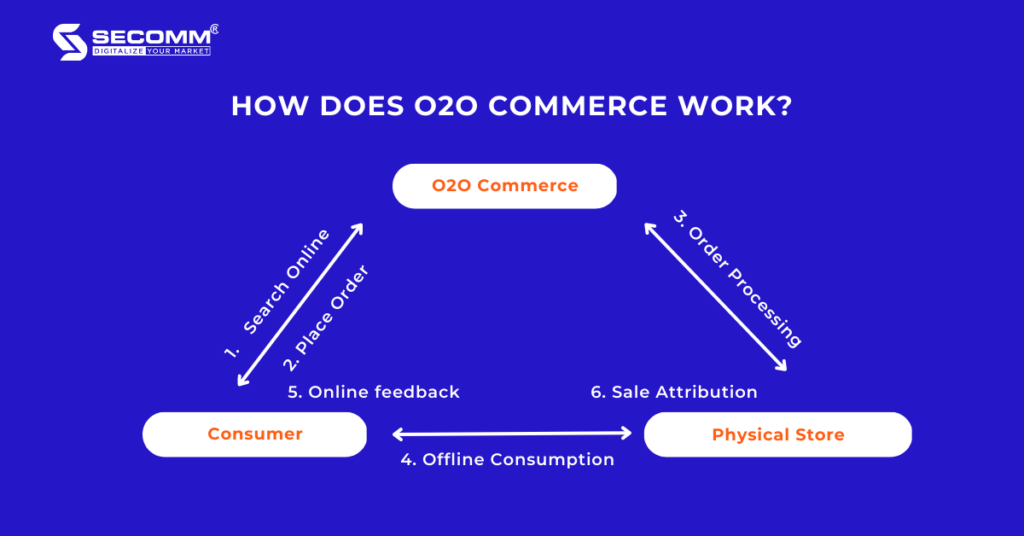
The differences between O2O and Omnichannel
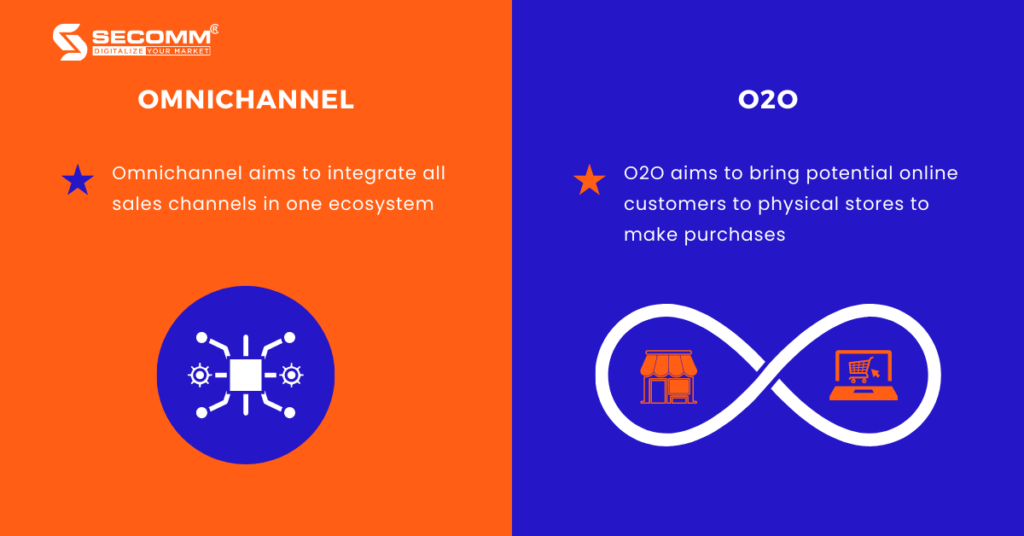
The example above may confuse the O2O commerce model and the Omnichannel commerce model. Although they both facilitate a more seamless shopping experience among channels, their main goals are quite different. While Omnichannel aims to integrate all sales channels in one ecosystem, O2O aims to bring potential online customers to physical stores to make purchases. Both strategies are designed to bridge the gap between online and offline sales, but O2O prioritizes a specific buying journey instead of multiple touchpoints in Omnichannel commerce.
Case studies

Topshop
One of the brands that understand what they are doing to connect in-store shopping with online shopping in a tight way is Topshop. By partnering with eCommerce website ShangPin to open retail stores in malls, with giant iPhones decorated in Topshop style, customers can access “The Mobile Adventure” by scanning a QR code to view and try on virtual Topshop fashion products in the store. Then they share their look on social media and place an order.
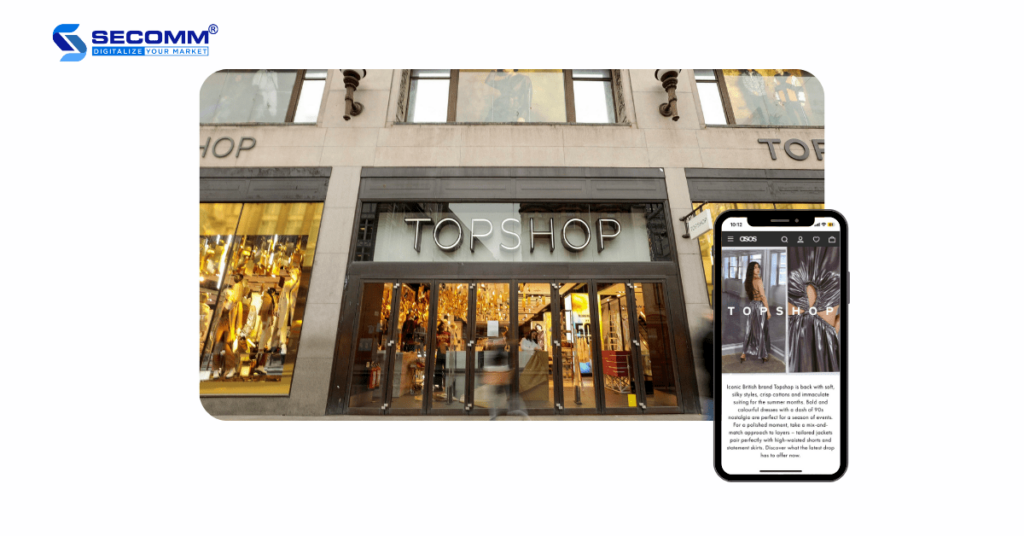
Tommy Hilfiger
When it comes to fashion, Tommy Hilfiger has shown his agility when deploying the O2O model. In 2015, the brand launched digital showrooms, pioneering the fashion industry’s digital revolution. In 2016 they launched a chatbot through Facebook Messenger and in 2017 they launched the Hilfiger Club app with a loyalty program of personalized special offers and invitations to the brand’s events. All of that gives customers a good reason to come to the store.
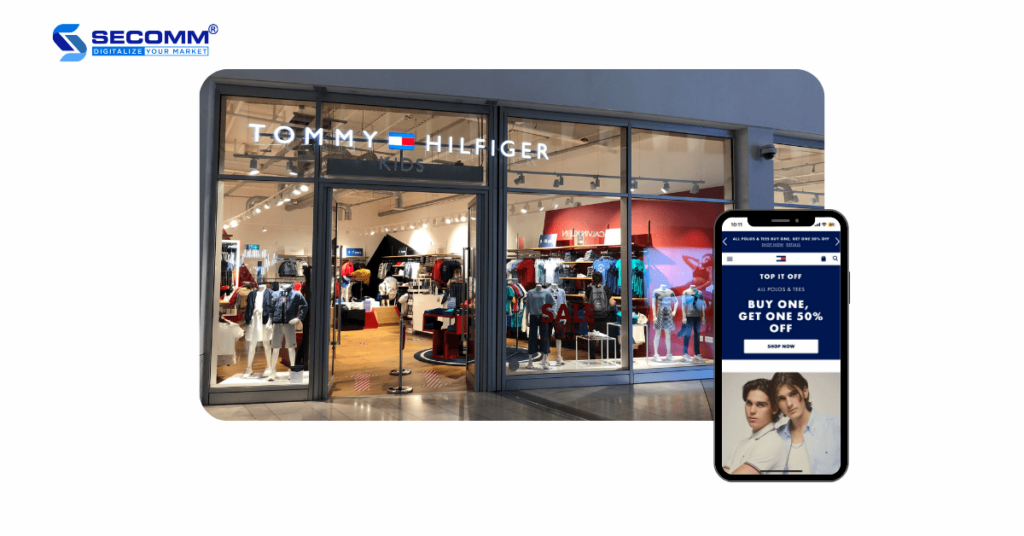
99 Ranch Market and WeChat’s Shake
In recognition of the significance of an O2O commerce strategy, WeChat introduced a “Shake” feature that enables mobile users to connect to a nearby local business by shaking their phones. The retailer’s unique offers are then all accessible, encouraging customers to engage in the in-store buying experience.
Soon after, the 99 Ranch Market, a chain of Chinese-American supermarkets, benefited from the popularity of WeChat’s “Shake” feature and the rise of O2O among the Chinese community in the US. Customers can play a “beacon shake” game the company has created, which is activated by in-store beacons and gives them the chance to win a variety of prizes and coupons for their subsequent purchases.
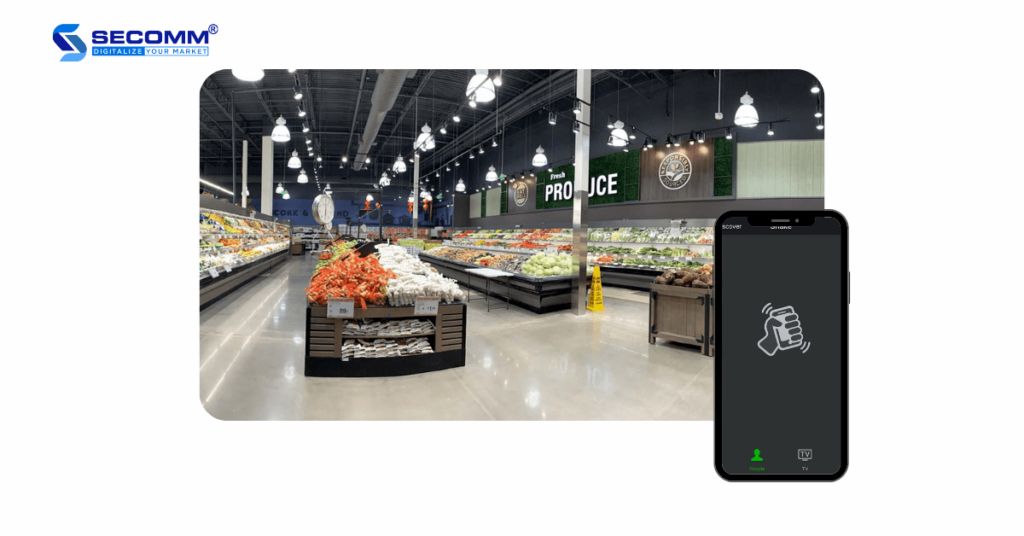
The O2O Commerce model is an incredible idea with great potential to change both online and offline sales in the eCommerce era. While customers can shop both in-store and online, brands can optimize engagement, conversion rates, and average order value.
Today, when customers’ expectations for online shopping are similar to offline shopping, one condition for physical stores to survive is to build their online presence quickly. The O2O strategy is about leveraging both online and offline channels, thereby enhancing brand loyalty, and providing a seamless Online-to-Offline shopping experience at all stages: before, during, and after purchases.
Want to know more? Contact our experts to learn more about O2O Commerce and how to implement it in your business.
 2
2

 2,592
2,592

 0
0

 1
1
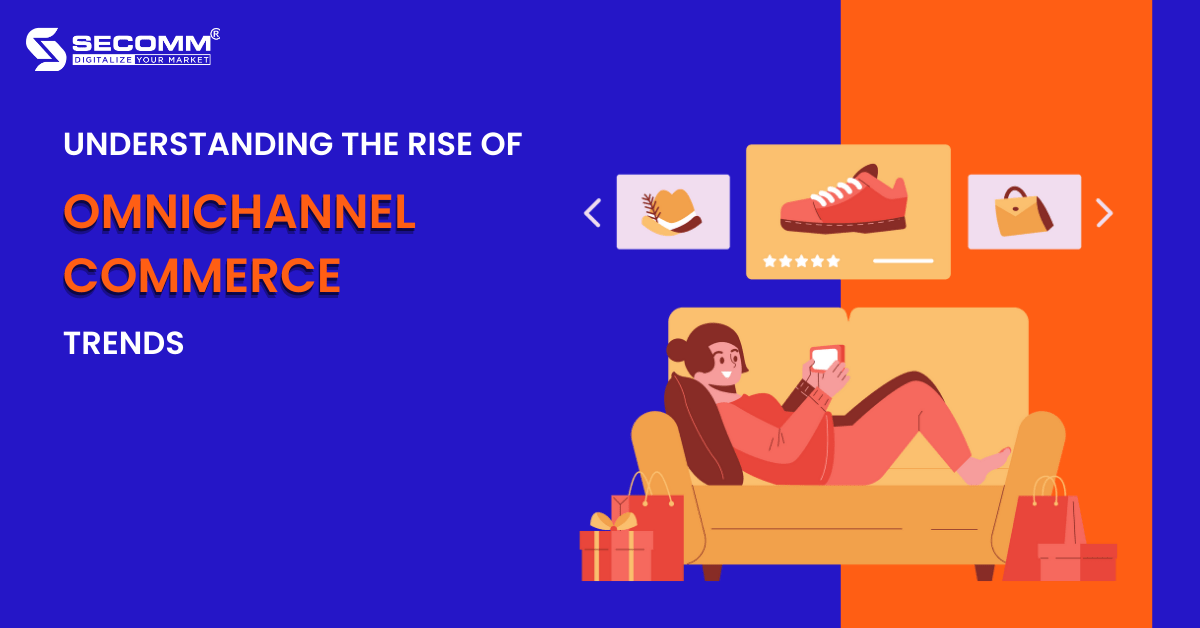
UNDERSTANDING THE RISE OF OMNICHANNEL COMMERCE TRENDS
We are living in a world where the younger generation has taken the lead in setting ever-rising standards for digital experience. So, it’s important for businesses to quickly adapt to new trends for sustainable development to keep up with the shift.
Especially during a global pandemic, eCommerce has become one of the top priorities of every business owner. In order to thrive in a rapidly changing market and keep customers loyal, brick-and-mortar businesses have had to build an online presence and increase their eCommerce capabilities.
The term “Omnichannel Commerce” is defined as a “trend” that helps businesses achieve the aforementioned objectives and this trend is expected to continue to accelerate in the coming years.
What is Omnichannel Commerce?
Omnichannel Commerce is a multichannel approach that focuses on offering a seamless shopping experience by marketing and selling across all channels where potential customers are present including mobile devices, social networks, eCommerce websites, and brick-and-mortar stores.
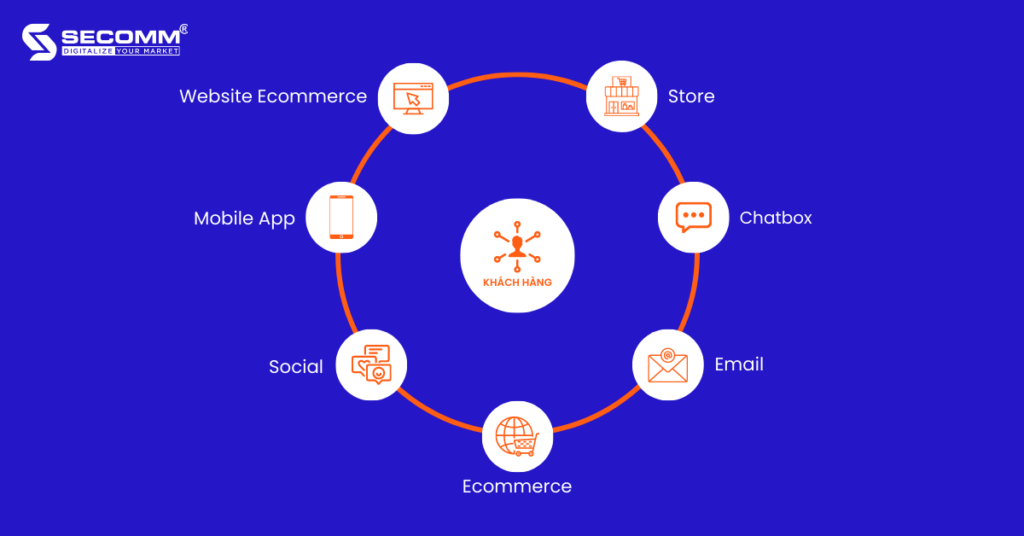
The main differences between Single Channel, Multichannel, and Omnichannel
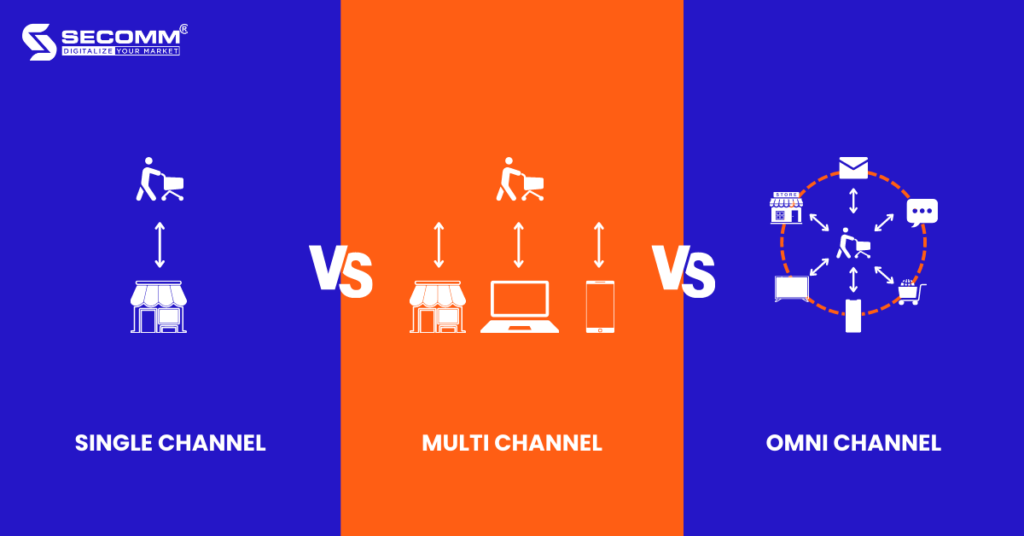
Single-channel Commerce
When a company sells its products or services only through one channel, that approach is known as single-channel commerce. It could be a physical store, an eCommerce website, or a marketplace like Shopee, Lazada, Tiki, etc.
Selling through a single channel could initially be quite successful, but if businesses desire to provide their customers with a richer shopping experience and increase brand awareness, they need to add multiple channels to showcase and sell their products or services.
Multichannel Commerce
When it comes to the Multichannel Commerce strategy, businesses will interact with customers and sell their products through both online and offline channels. This strategy makes use of touchpoints where customers can perform the same action at any available channel. These touchpoints, however, are independent and barely or not at all connected among channels. For example, a physical store with an eCommerce website has no inventory-sharing function.
Omnichannel Commerce
Similar to Multichannel Commerce, Omnichannel Commerce enables a company’s marketing and sales efforts to be spread across numerous channels. The main distinction is that Omnichannel Commerce prioritizes the customer, connects all touchpoints, and creates a unified buying experience. But, Multichannel Commerce aims to reach as many channels as possible, with unique content for each and customers will interact with brands through their preferred channels.
How does Omnichannel Commerce work?
An effective Omnichannel Commerce strategy includes effective operations of each sales channel that will be integrated in a seamless and consistent manner. Touchpoints should provide a unique but connected experience based on previous interactions. That experience takes customers to the end of the customer journey to get the business’s objectives.
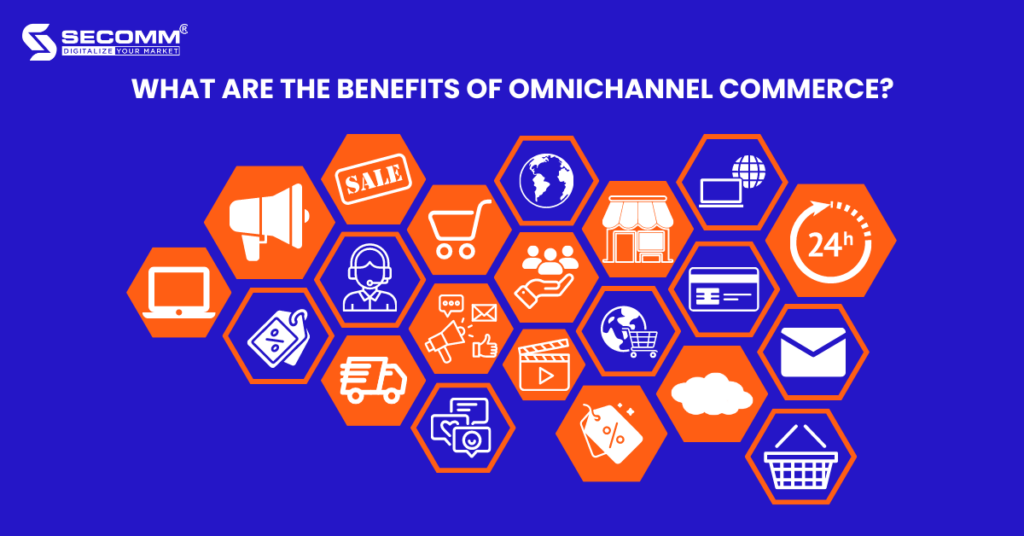
Imagine a man who wanted to buy a new washing machine. After seeing an attractive TVC with the merchant’s information, he used his laptop to begin searching on the Internet. He discovered the merchant’s eCommerce website, and his desired product is offered at a local physical store. He decided to add that product to his shopping cart after chatting with the customer service team.
He downloaded the merchant’s app, signed into his account, and accessed his cart before heading to the store because he wanted to see and check that washing machine in person before making a purchase. He checked the app to ensure the item is still in stock, its quantity, the best payment method, and any associated special offers.
When he arrived, he checked the product’s quality and checked out with the QR Code. The transaction is finished. Under the CRM system, his information and data would be saved for upcoming marketing campaigns and post-sale efforts.
What are the benefits of Omnichannel Commerce?
Nowadays, consumers receive a ton of offers and messages from many brands day after day. This brings up many considerations when choosing a brand to engage with. Developing an Omnichannel strategy to connect with customers in a seamless manner across multiple channels will set a brand apart from the competition.
Omnichannel Commerce is a customer-centric model, connecting touchpoints and providing personalized experiences. This contributes to the company’s revenue increase as expected with cross-sell and up-sell opportunities.
Also, the branding strategy will be effective and successful, enhancing customer loyalty as well as the brand message will reach the right target audience thanks to the consistency of the Omnichannel Commerce model. It’s not only useful for increasing customer engagement but also for customer data evaluation.
Thus, businesses will have a bigger picture of the customer journey, the times and channels customers usually interact with, as well as the most effective and valuable marketing campaigns. All this data needs to be meticulously analyzed and reused in the next marketing campaigns.
3 examples of Omnichannel Commerce in the real world
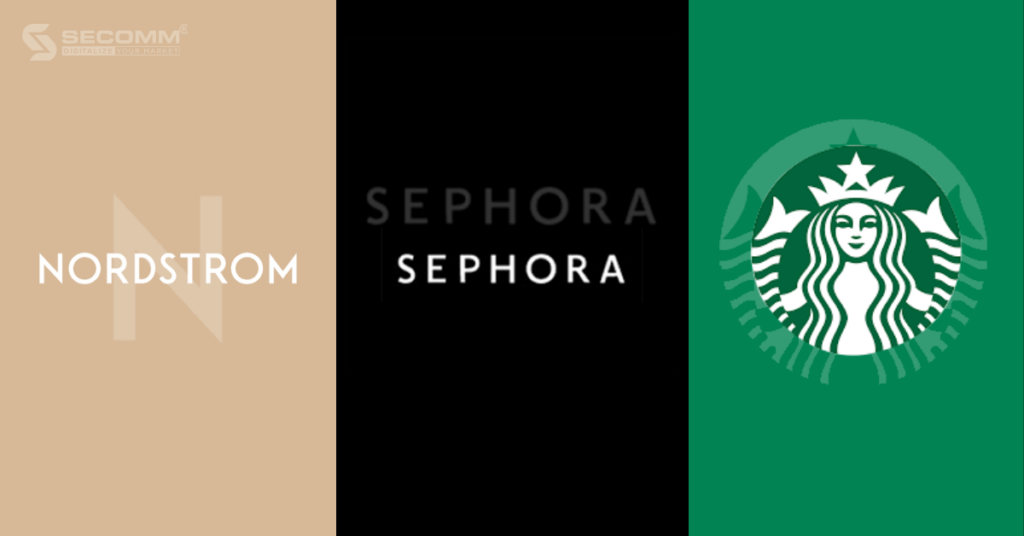
Nordstrom
Omnichannel Commerce has long been a strength for Nordstrom. They created the Pincode feature that allows customers to use their smartphone to scan and access Pinterest to get a $100 Nordstrom giveaway while in the store. The brand also showcases in the store Pinterest’s best-selling products as an interesting suggestion.
In addition to Pinterest, it uses Youtube to create video tutorials for matching outfits and suggests its customers go to the physical store to meet a professional. At the store, they will receive valuable advice that may lead to a purchase decision.
Recently, Nordstrom has leveraged Instagram’s shoppable posts to inspire shopping and encourage customers to make quick decisions.

Sephora
Sephora is one of the major brands in the beauty industry that is successful with Omnichannel Commerce. The company has established a strong connection between online and offline shopping experiences. Customers can access Sephora Beauty Bag’s personal account by using available tablets in its brick-and-mortar stores.
This account allows them to look up details of the items they are interested in and try them out using virtual reality. Additionally, Sephora’s benefits, like its in-store makeup tutorials and personalized gifts, have encouraged customers to make larger purchases.
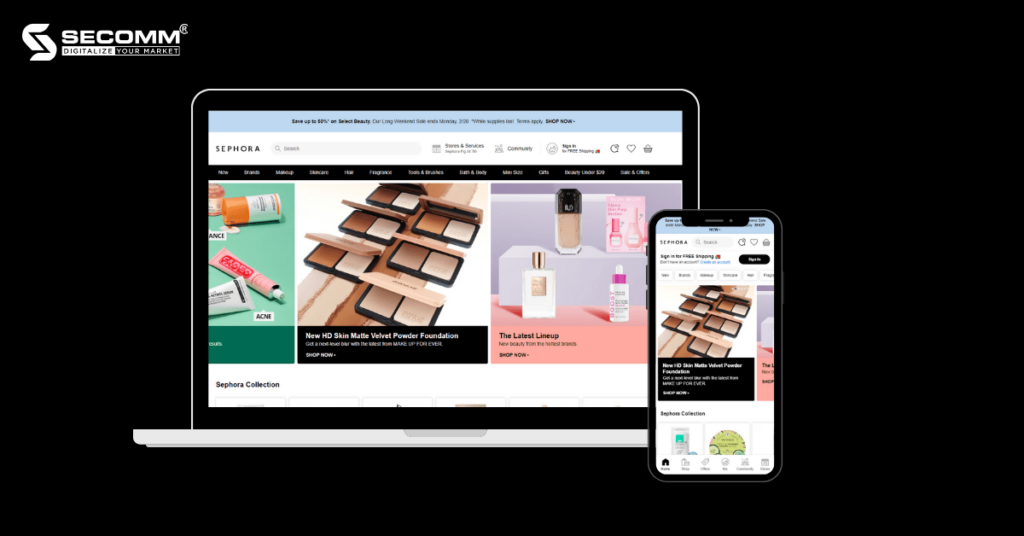
Starbucks
The world-famous beverage brand – Starbucks has launched the Starbucks Rewards App which is considered the pinnacle of Omnichannel Commerce. After creating an account, Starbucks fans can find a list of local stores, order drinks, and pay in advance so they don’t have to wait in line.
The app also regularly makes personalized recommendations for each customer based on previous orders, loyalty programs, weather, holiday seasons, or local store inventory.

Keeping up with the ever-changing business world is not easy. In fact, many big brands in the world have implemented Omnichannel Commerce early and have achieved great success. Plus, many other businesses are tending to gradually shift from Single-channel or Multichannel to Omnichannel and recognize this model as a bridge connecting customer experience between online and offline channels in a seamless way.
With many years of experience in successfully implementing eCommerce for many customers in many countries, SECOMM understands the difficulties when doing an Omnichannel Commerce strategy.
Contact our expert now to get a free consultation.
 2
2

 2,079
2,079

 0
0

 1
1
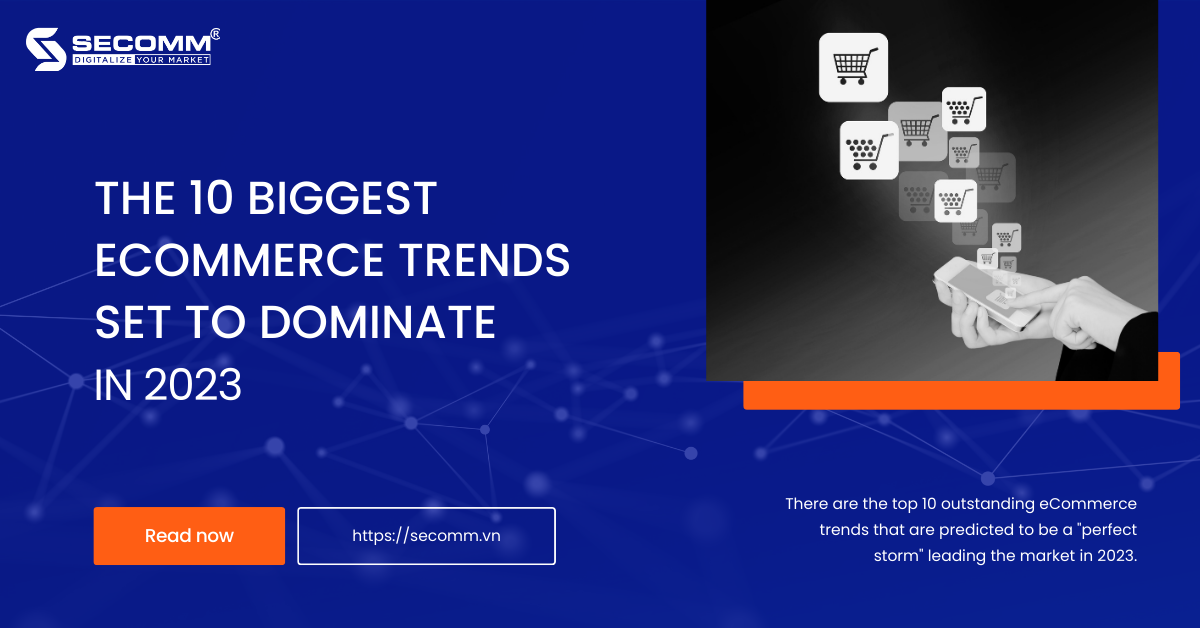
THE 10 BIGGEST ECOMMERCE TRENDS SET TO DOMINATE IN 2023
The eCommerce industry has a sizable market share in the Vietnamese economy and has shown impressive growth over the past two years due to the effects of the worldwide pandemic and social isolation.
After a year of society adjusting to the “new normal”, customers have started to buy at traditional stores again but the established trend of eCommerce consumption and the push from the wave of global digital transformation have encouraged businesses to change in order to suit the way the digital economy works.
Therefore, recognizing and anticipating the eCommerce trend of 2023 is extremely necessary for businesses’ New Year’s Marketing strategies to be implemented effectively and successfully.
Below is a list of 10 eCommerce trends that are forecast to “storm” the market in the next year.
Omnichannel
Omnichannel is an omnichannel sales model that helps businesses reach customers through many channels such as eCommerce websites, social networks, eCommerce platforms, chain stores, and distribution agents but operating in just one management system.
Additionally, there is a second type of sales model called “Multi-channel” that differs from Omnichannel in that it allows for discrete marketing content, unlinked data, and independent channel operation.
When purchasing across numerous channels, continuous and seamless updates result in a heterogeneous and seamless customer experience.

Due to the lifting of social distance restrictions, consumers are beginning to return to in-store buying after two years of online shopping.
However, that doesn’t mean that eCommerce’s growth momentum is stagnant; on the contrary, it keeps exploding.
Businesses there make use of the current rise in popularity of online shopping to encourage the use of Omnichannel to improve the varied and efficient shopping experience.
As researchers have noted:
- An estimated 56% of customers use smartphones to look up products while in a retail store.
- Nearly 75% of users use many different channels such as websites, social networks, and physical stores to shop.
- Around 73% of eCommerce consumers say they take an Omnichannel approach throughout the experience journey. For example, after shopping at a store, shoppers continue to follow the brand’s website, social networking sites, and eCommerce platforms.
As a result, 2023 will still be recognized as a strong year for omnichannel in eCommerce.
Mobile Commerce
Mobile Commerce or mCommerce is a business model that allows companies and individuals to deliver goods and services directly to consumers through handheld wireless devices such as smartphones and tablets.
According to Bankmycell, the number of smartphone users worldwide in 2022 is 6.648 billion, equivalent to 83.07% of the world population owning a smartphone.
Moreover, it is predicted that this number will increase to 7,516 billion by 2026. In addition, the percentage of global users participating in online shopping in 2022 accounts for 58.4%.
In Vietnam alone, interesting figures are listed in the Vietnam eCommerce White Book in 2022:
- 88% of people’s means of accessing the Internet are mobile phones, while this rate will only reach 57% in 2021.
- The percentage of Internet users participating in online shopping is 74.8%.
- 91% of the electronic means commonly used to order online are mobile phones.
- Among online shopping channels, 47% of users make purchases through mobile shopping applications.
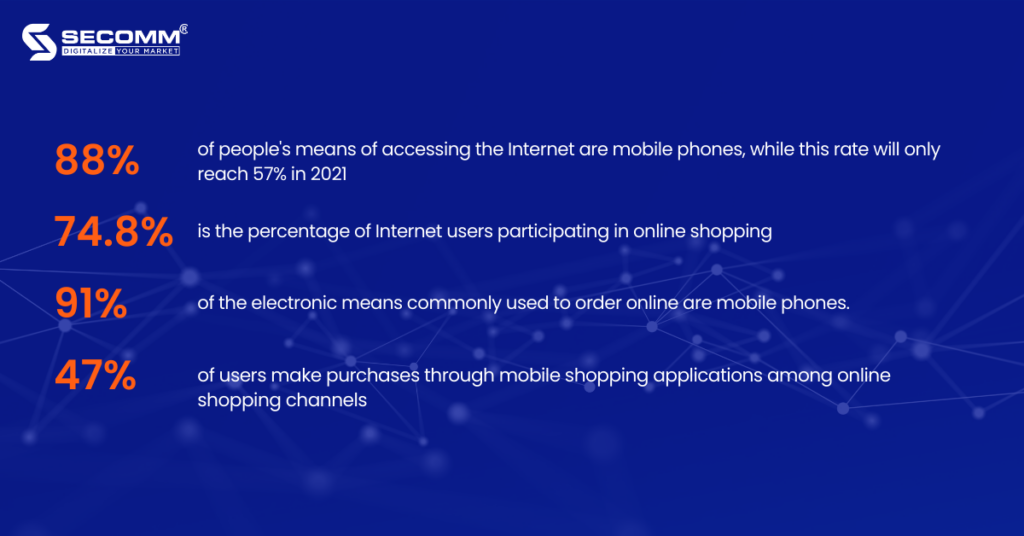
In upcoming years, the percentage of global people and Vietnamese people as well who own mobile devices and use them for online shopping is high and predicted to increase significantly.
Social Commerce
Social commerce refers to the method through which companies advertise and sell goods and services online using social networking sites like Facebook, Instagram, TikTok, Youtube, Zalo, etc. In other words, this type of business combines eCommerce and social media.
The impact of social networks has grown significantly in recent years. Over 59% of the world’s population uses social media, it is not surprising that this percentage will continue to rise.
While in the past businesses used social media to raise brand awareness and draw in new customers, today eCommerce businesses boost sales by offering goods and services to clients online via social media.
As a result, it’s incredibly handy for customers to interact, exchange information, and search and shop online all in one location.
According to Statista, global social commerce sales will reach $992 billion in 2022 and are projected to reach nearly $3 trillion by 2026.
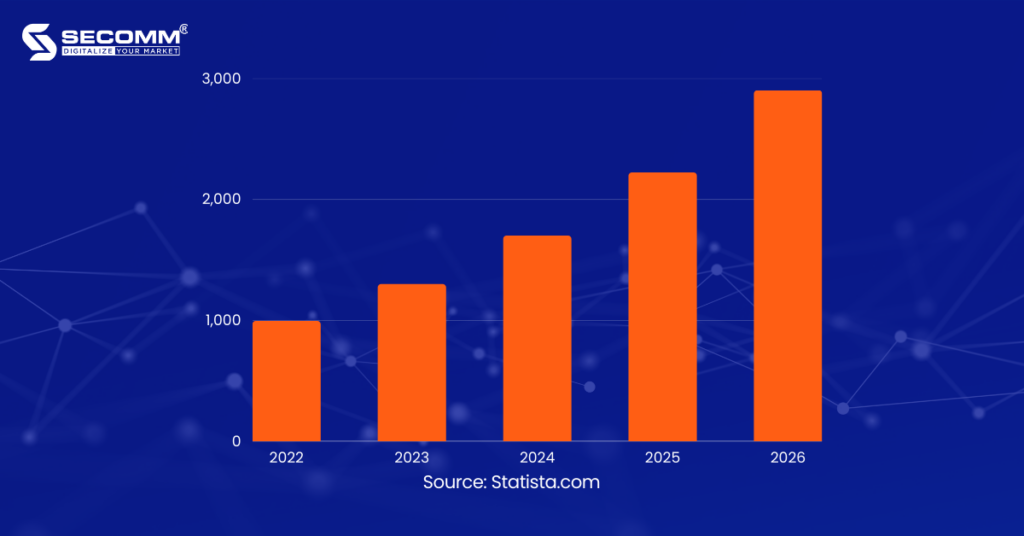
Thanks to the development of social networks, social commerce has had a strong acceleration and has become a magnet for brands to come to approach and analyze a large number of potential customers, and achieve marketing and sales goals.
As a result, failing to prioritize social commerce in enterprises’ marketing strategies in 2023 is probably to lead to a significant loss of competitive advantages in the eCommerce market.
Headless Commerce
Today, businesses have a lot of choices to build an eCommerce website, but basically, the structure of a website will include the following main parts:
- Frontend: Everything the user sees and interacts with when accessing the website including the interface, content, and functions,… is received from the backend.
- Backend: All the active parts of the website or app that are not visible to the user such as the database system, design tools, management tools, and custom functions.
For websites using a traditional structure, the frontend and backend will be operated on the same platform and from there will be closely connected with each other. Therefore, any changes on the website will be edited in two parts at the same time. However, with Headless Commerce, the backend and frontend will be decoupled from each other and operate independently on two separate systems.
The benefits of deploying Headless Commerce:
- Increase customization
- Increase Scalability
- Increase the page load speed
- Seamless integration
- Multi-channel sales support
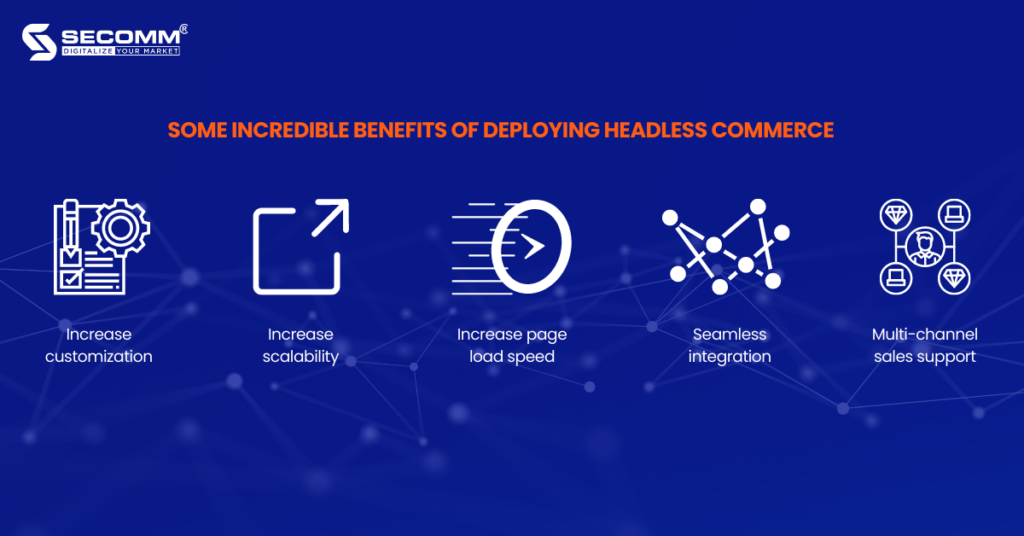
By using the Headless structure, Nike has become a brand with a much larger market share than Adidas – a formidable competitor of Nike.
Moreover, Nike’s website recorded more than 60 million pageviews in just 1 month. In addition, the proportion of direct purchases without intermediaries also increased significantly.
From Nike’s Case Study, one of the practical alternatives for companies looking to encourage eCommerce sales growth is Headless Commerce.
Shoppertainment
Shoppertainment is a form of shopping combined with entertainment that is used as a marketing strategy to encourage customer engagement with brands and consequently increase shopping demand. Moreover, it is used and takes over most of the online commerce in the era of digital transformation, when eCommerce is positioned at the forefront of contemporary business trends.
Some common practices of Shoppertainment trends:
- Live selling
- Shoppable video
- Gamification
These three practices all focus on entertainment and interaction. Then, the emotional element is aroused, leading to a series of unwise and unplanned shopping decisions. From a business perspective, this is beneficial for brands. TikTok‘s recent research proves it:
- In Southeast Asia, 82% of consumers purchase goods from companies they hardly ever use.
- 55% of consumers have made unplanned purchases.
- After watching videos on TikTok, 89% of consumers made unplanned purchases.
- Half of TikTok users confess to finding new brands or products while using the app.
- One in three customers desires to purchase and is satisfied with it.
- One in three customers wants to add fun and entertainment to shopping.
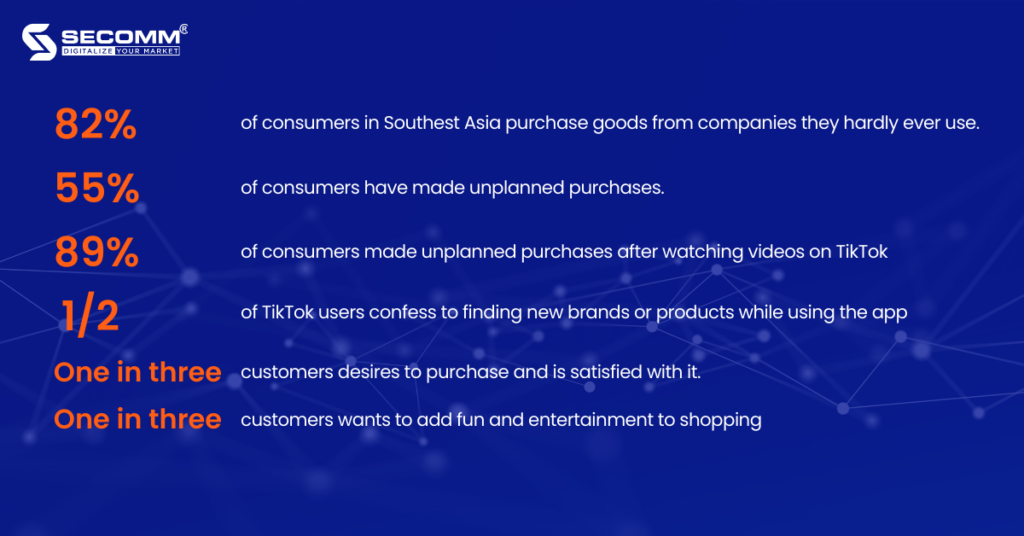
The growth of the Shoppertainment trend in recent years demonstrates the extreme demand for social interaction and connection following the period of Covid’s life.
Shoppertainment is the solution that businesses seek. This is a way to make the most of the customer’s biggest weakness – emotions.
When feelings of euphoria and joy are elicited during the shopping process, customers engage more, and purchase more unplanned products, conversion rates are higher, and sales follow.
AI Technology
Artificial intelligence now has a significant impact on eCommerce businesses in providing solutions to optimize the online shopping experience of customers.
The following statistics demonstrate the incredible influence of AI on the eCommerce market and businesses operating in this field:
- The AI-powered eCommerce market is estimated to reach 16.8 billion USD by 2030 (InsightAce Analytics).
- In the retail eCommerce market, the value of AI is predicted to increase from $1.7 million in 2021 to $36.4 million in 2030 (Precedence Research).
- 78% of brands have used AI for eCommerce websites (Oracle)
- Chatbot’s market value is predicted to reach 3.99 billion USD by 2030 (Grandview Research).
- It is predicted that eCommerce transactions made through Chatbots will reach 112 billion USD in 2023 (Business Solution).
- The cost of using AI Chatbots for customer care is 30% lower than hiring personnel to do this (Business Solution).
- 79% of eCommerce business owners admit that combining AI with marketing and sales helps increase the company’s revenue (McKinsey).
- 54% of businesses in France think that AI is good for analyzing eCommerce data (Statista).
- 70% of eCommerce business leaders in Europe and North America think that AI technology can help optimize customer experience personalization (Statista).
- 37% of users who click on an AI-driven eCommerce recommendation on their first visit to a website, return the next day (Investp).
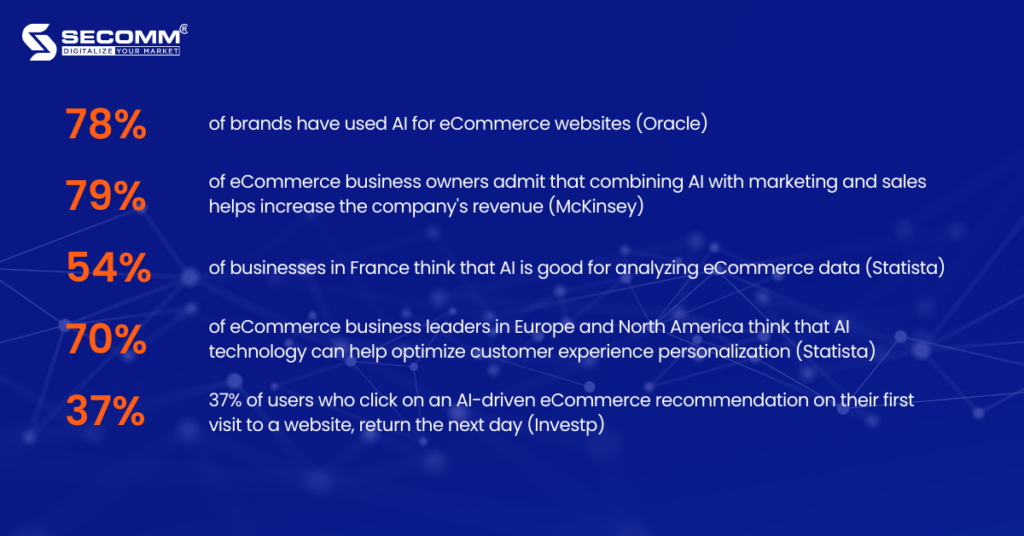
Currently, there are two applications of AI technology that are commonly used in eCommerce:
Chatbots
For eCommerce businesses, Chatbots will be like salespeople who can interact directly with customers 24/7. This helps businesses narrow the distance in terms of geography and time zones, helping the sales and customer services process to take place effectively without interruption.
Personalized Advertising Campaigns
By collecting customer data, AI can create tailored content and recommendations for each specific customer. To improve marketing campaigns and personalize the customer experience, AI can also predict purchasing behavior based on a user’s browsing and search history, when the data is legally available.
VR/AR Technology
VR (Virtual Reality) is a modern technology that brings users into a simulated but still very realistic space with only 3D glasses (virtual reality glasses). The virtual world that the user sees is actually set up and controlled by a highly configurable computer system.
AR (Augmented Reality) is a new technology enhanced from VR technology. This technology has the potential to erase the boundary between the real world and the virtual 3D model. That is, users will experience virtual models in real space through smartphones or computers.
With a clear plan and the appropriate approach, Lazada has been in front of the augmented reality trend for a number of years and developed a certain competitive advantage in luring both consumers and sellers.
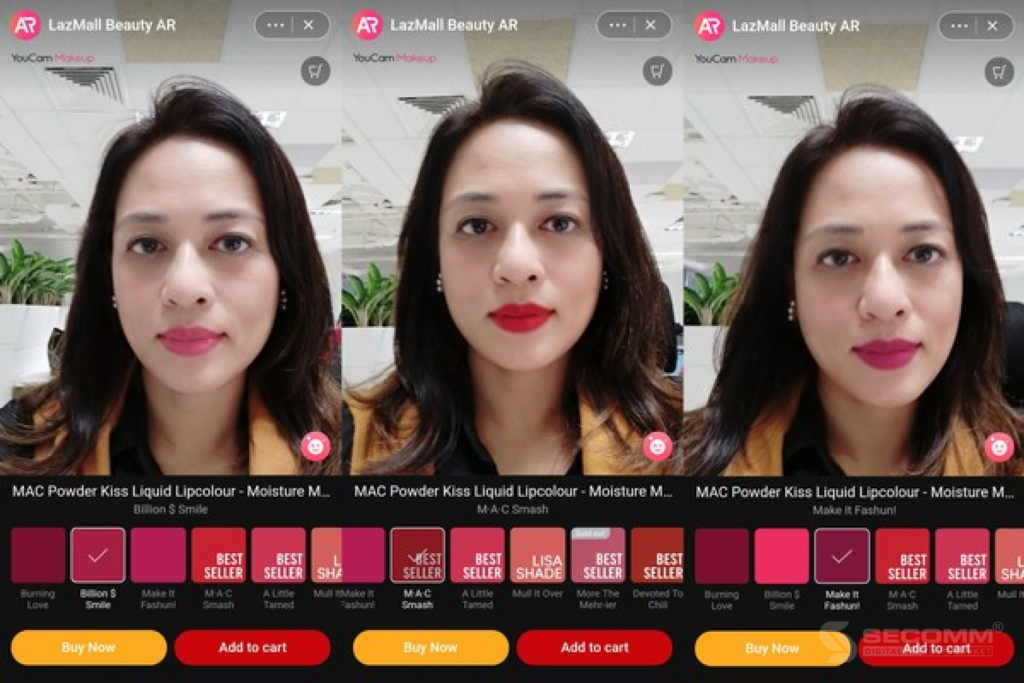
In particular, the VTO (Virtual Try On) function on Lazada includes a wealth of features to assist customers in freely selecting and trying goods like eyeshadow, eyeliner, foundation, and cushions whenever and wherever they like.
Since its launch, LazMall brand partners in the cosmetics sector have experienced tremendous success with the VTO function, which has helped to boost conversion rates by 3.1x and average order values by up to 11%.
KOL/KOC
The rapid growth of social networks and eCommerce has given marketing efforts a fresh and original breeze thanks to KOL/KOC. Although KOL and KOC have long existed in some form, they have truly taken off in recent years.
KOL – Key opinion leader, also known as an “influencer”, is an individual or organization with expert product knowledge and influence in their field or industry.
KOC – Key Opinion Consumers are “the most influential consumers in the market”. Their job is to test products and services and make comments and reviews.
KOL will suit mid- to high-end brands, while KOC will suit mid-range brands. If KOL is used to select brand ambassadors, holiday season ambassadors, or product launch campaigns, KOC is used to boost sales in a short time or direct customers to websites or eCommerce platforms.
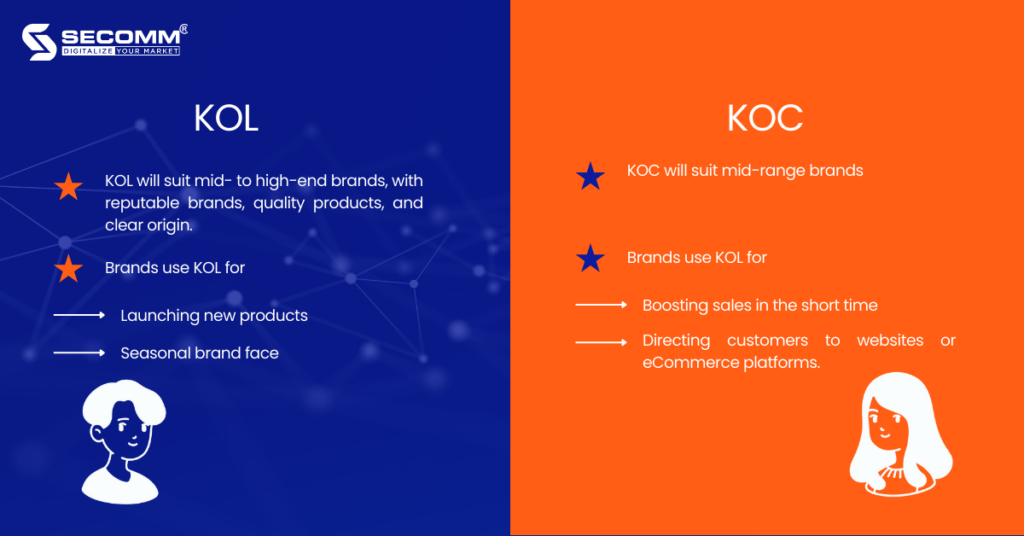
Some famous KOLs in Vietnam: Helly Tong, Giang Oi, Dino Vu, Co em Trendy, Chau Bui, Khanh Vy, Khoai Lang Thang,…
Some famous KOCs in Vietnam: Ha Linh, Call Me Duy, 1m88, Ong Giao Review, Chau Muoi, Hoang Viet, Pu Met 7,…
BOPIS
BOPIS – Buy Online Pick-up In Store is one of the shopping trends that promise to explode in 2023. Customers won’t have to be concerned about shipping costs, extended delivery times, or the risk of receiving unexpected goods when using BOPIS.
Businesses all around the world are pushing up their BOPIS implementation to meet customer expectations when merging online buying with in-person pickup. This is the ideal approach to boost store visits and close the gap between the offline and online buying experiences.
According to GlobeNewswire, the global BOPIS market is projected to reach $703 billion by 2027 with an estimated CARG of 19.3% between 2021-2027.
In addition, the following BOPIS trend statistics can help businesses consider implementing in 2023:
- In the last 6 months of 2022, 67% of US consumers use BOPIS.
- 49% of BOPIS consumers admit to buying more products while in store to pick up their items.
- 65% of customers choose BOPIS to avoid shipping costs.
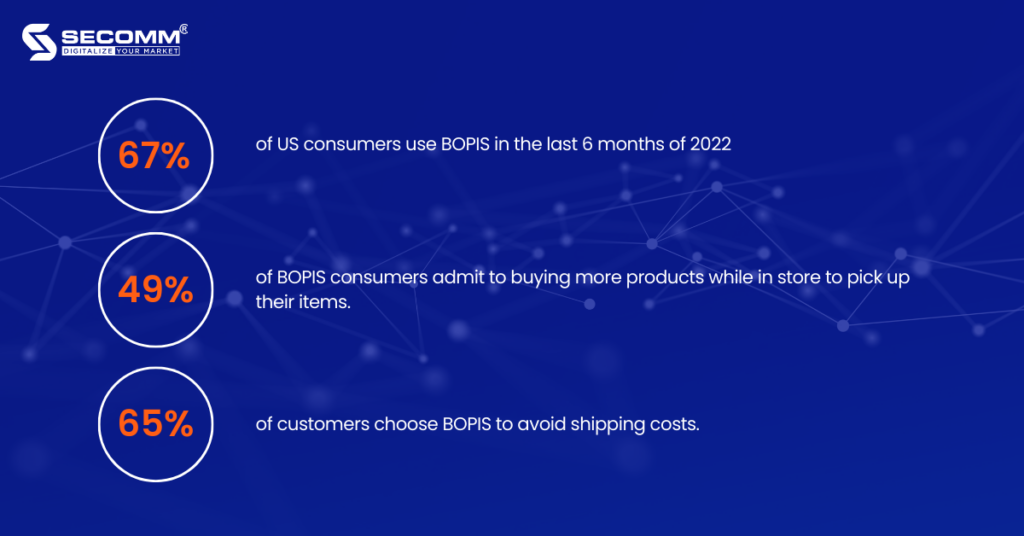
The BOPIS model also aids businesses in cutting expenses, expediting deliveries, boosting demand for retail goods, and lowering the risk of product returns.
UGC
User Generated Content, also known as UGC, includes text, photos, video and reviews. Because people are becoming less and less engaged in the brand’s message over the past ten years, UGC has grown in importance.
According to a recent Salesforce survey, 53% of Millennials think user-generated content (UGC) influences their shopping decisions, and 92% of consumers prefer content created by friends and family over that created by brands. The reason for the above numbers is trust.
Therefore, user-generated content (UGC), such as photos, videos, and customer evaluations, is trustworthy social proof and aids in the development of a company’s reputation.
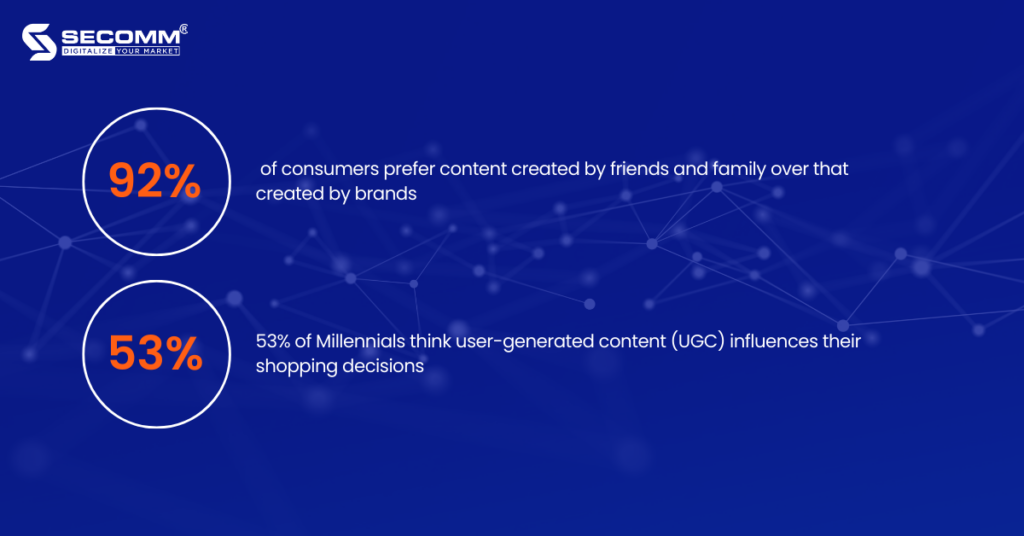
In a nutshell, businesses must quickly adapt to evolving eCommerce and digital technology trends in order to avoid falling behind and being driven out of the market. By reading 10 eCommerce trends that stated and analyzed above, businesses will have an overview to be ready for the new journey.
With many years of experience in successfully implementing eCommerce for many customers in many countries, SECOMM specializes in providing consulting services with comprehensive and professional eCommerce implementation solutions.
Contact SECOMM today for free support and advice.
 2
2

 3,380
3,380

 0
0

 1
1

WINE ECOMMERCE SHINES BRILLIANTLY IN THE DIGITAL ERA
Over time, the Covid-19 pandemic has greatly damaged the world economy, with significant consequences for investors and business owners across a wide range of sectors, including the wine sector.
Sales of alcoholic beverages have decreased dramatically as a result of the closure of hotels, restaurants, and nightclubs as well as the postponement of big events and festivals.
Despite the global economic issues, eCommerce must be considered among the industries that perform very well. Some companies across multiple areas have enthusiastically embraced eCommerce to weather the downturn.
Also, wine firms follow that wave of change, making eCommerce shine in the new era – the era of digital transformation.
Why 2023 is the perfect year to deploy wine eCommerce?
Wine eCommerce growth statistic
- Wine eCommerce sales reached $6 billion in 2021, an increase of 131% compared to 2020. In the two years 2021-2022, online wine sales increased by 4%, while in 2020 they only increased by 2%.
- The online revenue of the wine market reached more than 261 billion USD in 2022 and is expected to grow at 10.51% annually from 2022 to 2025.
- According to IWSR, the global wine eCommerce market value will reach $42 billion by 2024.
- An estimated 1.6% of the total liquor market revenue in 2023 will be generated from online sales.
- The average annual growth rate of wine eCommerce in the US is around 20%.
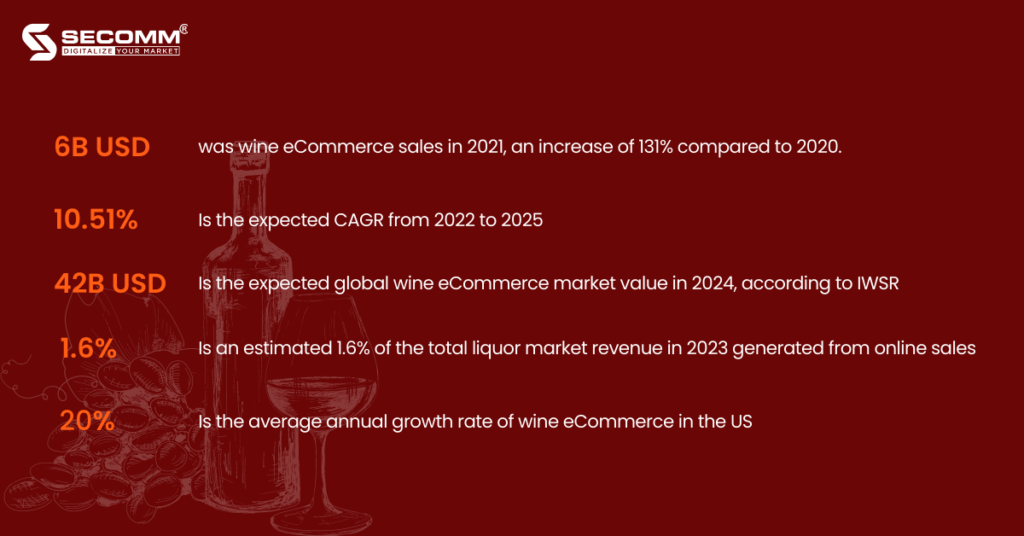
Key drivers of wine eCommerce growth
Global Pandemic
In the midst of the global pandemic-related crises, the wine business, like many others, saw a breakthrough in the speed of online purchasing.
When the pandemic breakout occurred, 44% of American consumers placed their first-ever online wine and liquor orders.
The year 2020 saw a 42% increase in wine eCommerce as a result. Online wine sales increased from just $1 billion in 2018 to $6 billion by 2021.
Young wine consumer
In the US, according to Avalara, Millennials and the legal drinking age population are steadily increasing.
By 2023, the Millennial generation is estimated to account for nearly 45% of the LDA (Legal Drinking Age) population under the age of 80. By 2030, this number is projected to be 54%.
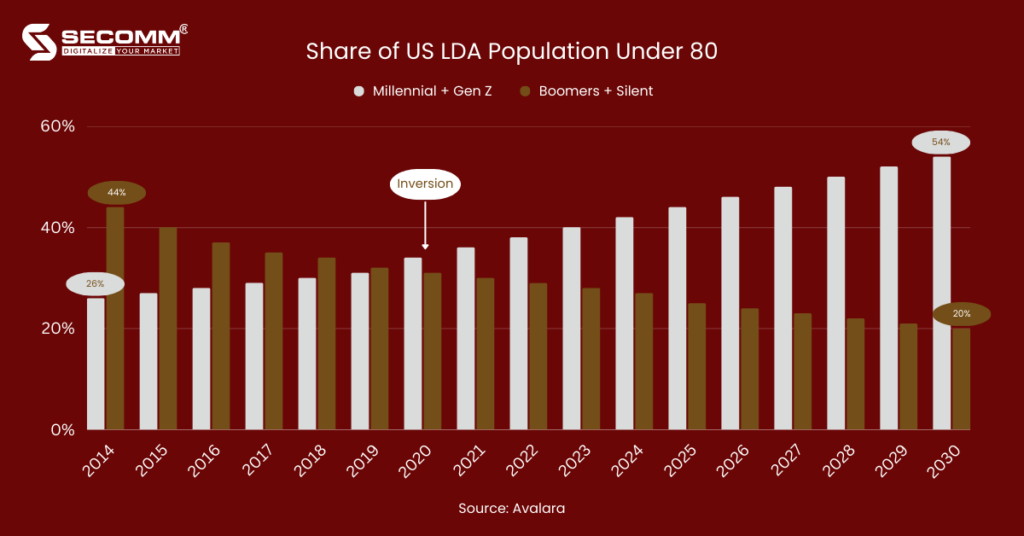
In Vietnam, Millennials (25–38 years old) and Gen Z (18–24 years old), often known as MillennialZ, currently make up 47% of the population or about 45 million people who are of drinking age. The population structure of the MillennialZ generation is expected to keep growing.
The primary factors influencing the growth of the eCommerce sector as well as the digital economy of Vietnam will also be the young people’s awareness of and keeping up with new trends in digital technology compared to previous generations.
Case study
iShop Changi Wines
The Duty Free Shop Group (DFS) and Changi Airport Group (CAG) collaborated on the iShop Changi Wines eCommerce online project, which offers world-renowned and premium wines and spirits with exclusive discounts to visitors to Changi Airport, particularly those who are CAG members.
The iShop Changi Wines website is cutting-edge and exquisitely styled, showcasing the distinctive qualities of the wine industry as well as the aesthetics from page layout, color, font text, logo, and banner, all of which are guaranteed to optimize the purchasing experience while also, and this is crucial, emphasizing the identity and brand-development elements for both CAG and DFS.
Due to the fact that this is a project of well-known companies, the iShop Changi Wines website has consistently received a lot of traffic, averaging approximately 592 thousand views each month since its introduction.
Therefore, to combat the unexpected surge in traffic and orders during the busiest shopping seasons of the year, the eCommerce system must be continually enhanced and optimized.

The fact that major corporations CAG and DFS both started and developed successful wine eCommerce websites shows the enormous potential of this industry now and in the future.
Previously, the business scope of wine businesses was quite limited, but now that limit has been broken thanks to the dominance of the Internet and the rise of eCommerce.
Moreover, the government’s assistance in lowering legal restrictions has given wine producers the assurance to confidently market their goods to a significant number of potential buyers in several nations across the world.
The Warehouse
The Warehouse, established in 2001, is renowned as a top supplier of wines and spirits in Vietnam, offering more than 16 different varieties of wine from numerous nations.
In addition, along with Annam Gourmet Market, Yves Rocher, and Flormar, this is another well-known retail brand of the Nam Group. Before being formally put on the market, products at The Warehouse are consistently inspected and carefully chosen to fulfill quality criteria.
The company has so far increased the reach of its distribution network across the nation, including Ho Chi Minh City, Hanoi, Da Nang, Nha Trang, Hoi An, Quang Ninh, and Phu Quoc.
The Warehouse achieved its objective of serving the wine market with B2B and B2C business models by utilizing the Magento platform.
This implies that the business will broaden the retail channel to include private customers in addition to distributing wines to restaurants, hotels, resorts, pubs, and lounges.
A series of symbols, logos, and banners created especially to fit the characteristics of the wine industry are combined with Bordeaux red to create a website interface that is focused on UI/UX perfection.

The Warehouse is flexible, secure, and has quick ordering, payment, and delivery options. Therefore, customers can place orders through phone, mobile app, or eCommerce website.
Customers can then pick up their purchases from the store or, in major cities like HCM, Hanoi, and Da Nang, the company will deliver them quickly within 2 to 3 hours. In other places, conventional courier delivery takes 2 to 5 days.
The Warehouse has been successful in raising brand recognition, expanding its customer base, and increasing both offline and online sales as a result of the timely growth of its business model and digital transformation
Trentham Estate
Long-standing Australian company Trentham Estate Winery, founded in 1988, focuses on the manufacture and distribution of wine.
After many years in business, the company is well regarded for its creativity in the wine-making process, which resulted in a variety of wines with different delicious flavors. Also, the brand has received hundreds of medals, titles, and other industry awards.
In the beginning, the business created and ran a WordPress website system for branding purposes.
Trentham Estate, however, has been forced to increase its company scale by making a substantial investment in an entire eCommerce website system due to the growth of eCommerce and the increasingly varied purchasing needs of potential clients.

In the beginning, the business created and ran a WordPress website system for branding purposes. Trentham Estate, however, has been forced to increase its company scale by making a substantial investment in an entire eCommerce website system due to the growth of eCommerce and the increasingly varied purchasing needs of potential clients.
That is what led to the creation of the website trenthamestate.com.au, which has a modern interface while still accurately capturing the distinctive features of the wine industry.
Similar to The Warehouse, Trentham Estate likewise creates an eCommerce website based on the Magento platform with a variety of features that satisfies eCommerce requirements and wine industry specifics.
Therefore, businesses can access and serve a wide range of large customer files not only in Australia and internationally thanks to effective marketing and branding strategies, towards a sustainable business model along with the changes of the digital age.
It would be hard to believe that an industry as sensitive as wine could be traded online so easily and efficiently. In that efficiency and convenience, there is a great contribution of the trend of eCommerce and the comprehensive National Digital Transformation program that is committed to supporting by the Government. This is an extremely appropriate time for wine businesses to confidently deploy eCommerce because of the support from the Government and the push from the market.
However, planning to implementation are two completely different categories. Businesses are required to have a practical strategy and technical assistance from highly skilled firms to hasten the success journey and help advance the National Digital Transformation goal.
SECOMM has many years of expertise in effectively executing eCommerce for numerous customers in various countries. We specialize in offering free consultation services with qualified eCommerce implementation solutions.
Contact us right away for free counsel and assistance.
 2
2

 2,645
2,645

 0
0

 1
1
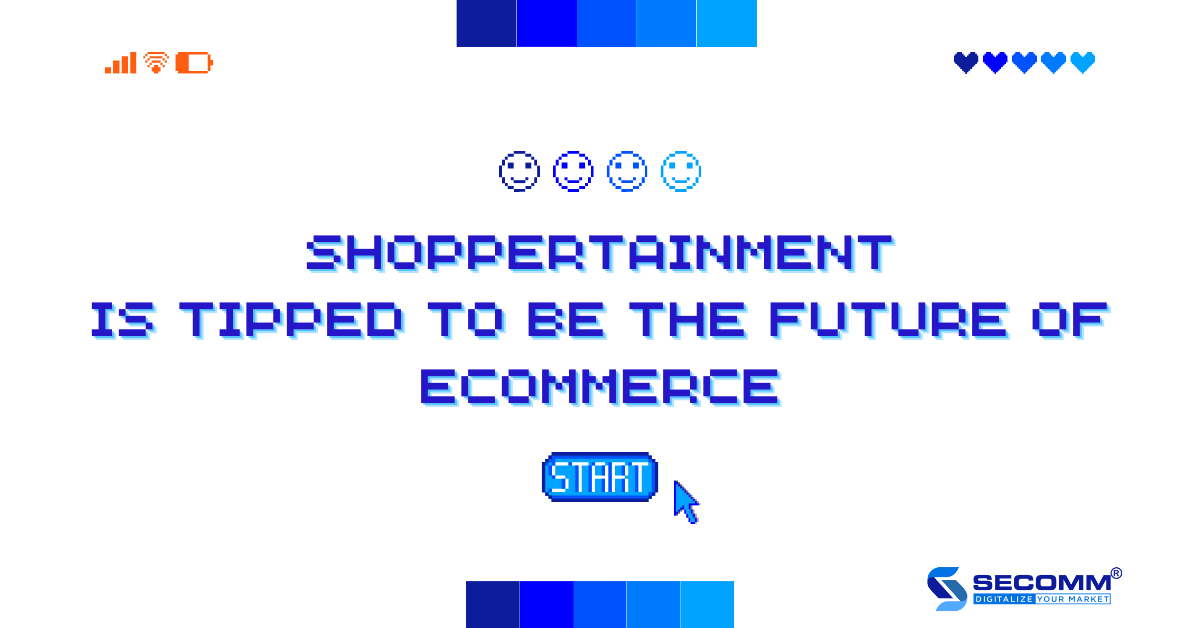
SHOPPERTAINMENT IS TIPPED TO BE THE FUTURE OF ECOMMERCE
The Covid-19 pandemic not only encourages the tremendous growth of eCommerce but also helps shift consumers’ priorities from in-store to online buying. However, instead of just buying, consumers frequently prefer to seek out novel, inspiring experiences.
Therefore, every company should strive to implement the approach of shopping combined with entertainment (Shoppertainment) in order to improve marketing effectiveness and boost sales.
What is Shoppertainment?
Shoppertainment is a combination of two elements “shopper/shopping” and “entertainment”.
Shoppertainment is described as “the provision of recreational or leisure facilities within or next to a retail store or shopping center, as part of a marketing strategy, which is designed to attract customers and stimulate purchasing” in the Oxford Dictionary (1990).
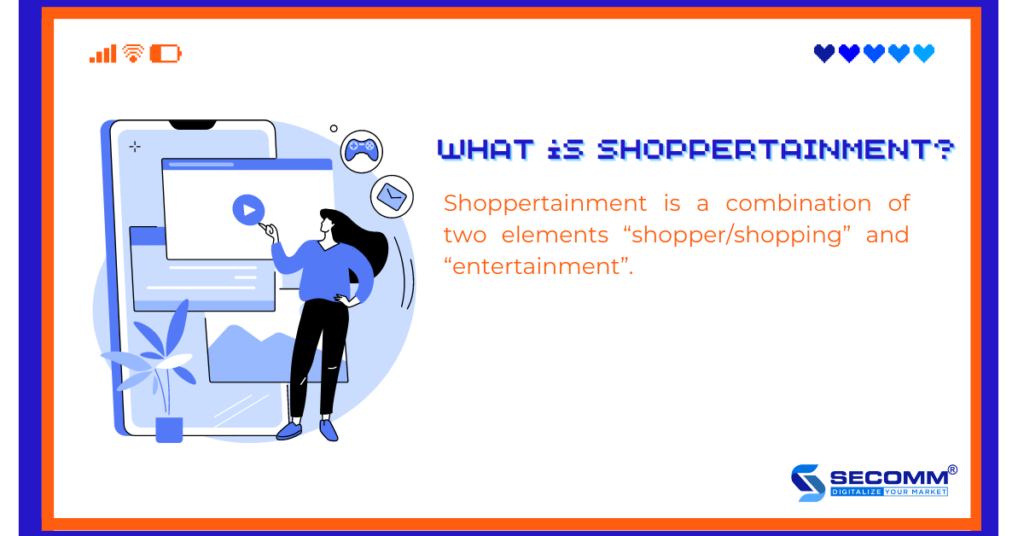
Many companies, notably IKEA, the biggest furniture retailer in the world, have used shoppertainment with success in the past. IKEA launched a campaign in 2019 called “IKEA nightclub – Tonight is to sleep” for 100 lucky individuals.
During this campaign, customers can partake in activities like manicures, massages, snacks, and tea instead of cocktails before spending the night in rooms with IKEA furniture that is soon to be released.
The brand has had remarkable sales success thanks to the campaign’s resonance in North America.
The shoppertainment trend, however, is no longer just restricted to stores or other physical locations thanks to the growth of eCommerce and digital marketing but has instead gained popularity and taken over online shopping activities.
In comparison to the prior definition, shoppertainment has been enlarged and changed. Shoppertainment is a trend that combines online shopping with entertainment, allowing buyers to engage with merchants in addition to purchasing products as usual.
In Vietnam and in the Asia-Pacific region, certain forms of entertainment-infused shopping are very common. Examples include live streaming, shoppable videos, and gamification.
What role does shoppertainment play in eCommerce?
According to the Vietnam eCommerce White Paper 2022, the size of the retail eCommerce market in Vietnam will increase from $11.8 billion in 2020 to $13.7 billion in 2021 and is estimated to reach 16.4 billion USD in 2022.
Meanwhile, the percentage of consumers shopping online on eCommerce websites is 78% in 2021, up 4% over the same period last year.
Because of the urgency, lack of options, and social isolation, the effects of the epidemic have actually contributed to a change in consumption tendencies from in-person purchases to online purchases.
Since that time, it has seen the quick decline of the conventional commerce model and the rise of eCommerce. By 2026, Statista projects that eCommerce sales will total $8.1 trillion.
Additionally, it is not surprising that consumers like shoppertainment. Although this combination is not novel, it promises to set the consumption trend in the years to come as eCommerce takes center stage.
The demand for online shopping will be higher there, and expectations for the best shopping experience—including both online shopping and fascinating experiences will also be higher.
Retail businesses around the world have seen a significant rise in sales during the outbreak by combining online shopping with live streams, entertainment videos, and video games to create real-time digital interactions with customers.
For instance, Taobao Live, which Alibaba introduced in 2016, saw a 150% surge in sales in 2020 when the epidemic first appeared in China.
“Shoppertainment is now a basic expectation. You really have to leverage engaging tools so the shopper gets to learn about the product, its superiority, and has fun along the way,” notes Alex Vogler, senior director and head of marketing, eBusiness, Procter & Gamble (P&G) Asia, Middle East, and Africa.
The Covid-19 pandemic has had a significant negative impact on the human psyche, causing issues including depression and anxiety. On the other hand, a portion of the populace said that the social connections they were unable to have prior to the epidemic significantly improved their psychological well-being.
People need to connect with the community and others like them more than just for amusement. Brands have therefore concentrated on improving the consumer experience by transforming personal experiences into shared ones that bring communities together.
As an example, consider the hashtag #TikTokMadeMeBuyIt. Through the TikTok platform, users can easily and amusingly share their shopping experiences, resulting in videos going viral and receiving more than 4.5 billion views.
Shoppertainment will result in emotional and impulsive purchasing decisions since it emphasizes entertainment and connection. According to a recent TikTok research:
- In Southeast Asia, 82% of consumers purchase goods from companies they hardly ever use.
- 55% of consumers have made unplanned purchases.
- After watching videos on TikTok, 89% of consumers made unplanned purchases.
- Half of TikTok users confess to finding new brands or products while using the app.
- One in three customers desires to purchase and is satisfied with it.
- One in three customers wants to add fun and entertainment to shopping.
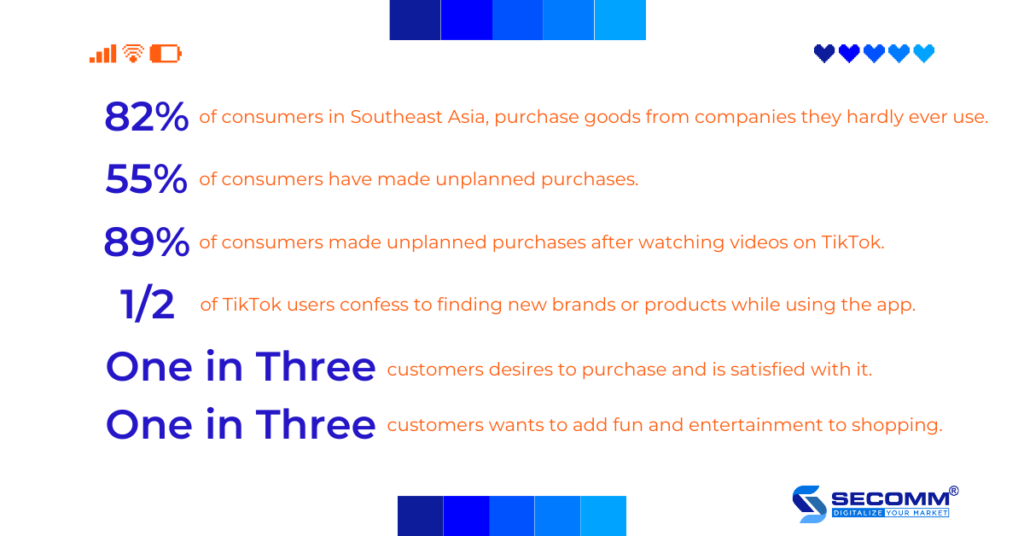
The studies mentioned above demonstrated the enormous influence that social networks and online shopping trends have on consumer decisions.
Because of this, Vietnamese retail companies have prioritized shoppertainment in their marketing plans.
Customers demand a more social and engaging online shopping experience, as well as the ability to connect and converse with one another while buying, which is the reason for any of this.
Best Shoppertainment practices
Live Selling
In recent years, both buyers and sellers in the Asia-Pacific (APAC) area have grown accustomed to live selling. Live selling is less common in the US and Europe than it is in APAC, but businesses there are nonetheless keeping an eye on this trend.
For instance, AliExpress initially introduced the live selling feature in France in May 2020, and since then, more than 3,000 live programs have been launched, with the involvement of more than 100 vendors.

The combination of sales, interaction, and entertainment makes this one of the top social selling strategies. Customers can interact with vendors directly, view actual product photos, and make decisions by pushing their shopping emotions.
Plus, the engaging social interactions that take place throughout live streaming help retailers make an impact on customers, resulting in a high return rate.
Due to the growth of the Shoppertainment trend and the effectiveness of live streaming in generating sales through social networks, eCommerce marketplaces have started to put more of an emphasis on investing in producing engaging entertainment material for users on their apps, particularly through live streaming.
The customer buying experience is improved by several well-known live stream channels, like TaobaoLive, LazLive, Shopee Live, TikiLive, etc.
These companies have the resources to develop this feature for themselves, but lower-budgeted companies can still try the live-selling concept by integrating Facebook or YouTube live stream with an eCommerce website.
Shoppable Video
Live-streaming videos will be effectively replaced by shoppable videos. One of the joys of using this type of video is that companies may produce videos in their own distinctive styles that quickly introduce customers to their products, explain how they operate, and demonstrate how to use them. These videos can be attached to an eCommerce website. Users can always click the product link in this kind of short video to find out extra details or to make a purchase. The short-form video has overtaken popular platforms like TikTok, Instagram Reels, and Youtube Shorts as the go-to method for branding, cultivating customer trust, and influencing purchasing decisions.
83% of people, according to Nielsen study, prefer watching videos of advertisements to GIFs or text. Short-form videos have gained popularity as a result of global digital transformation and consumer preference, and many brands now opt to use those as part of their video marketing strategies due to their useful advantages, which include the following:
- Simplify the customer journey
- Increase customer engagement
- Improve the conversion rates
- Get a boost in sales
- Create brand loyalty
- Build a better customer experience
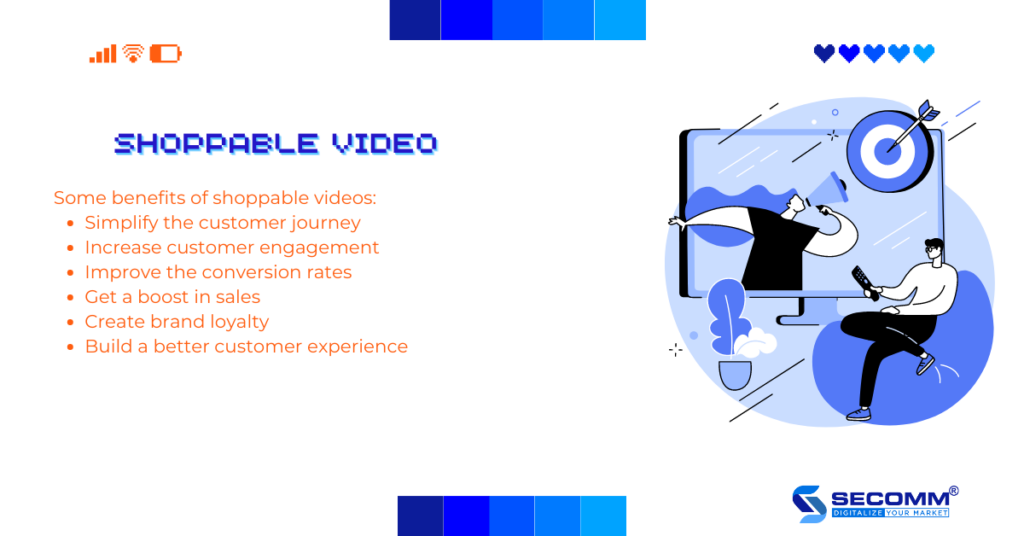
Gamification
Gamification or Gamification Marketing is the skillful incorporation of a video game’s mechanics into promotional operations in a unique and impressive method to meet marketing objectives.
Gamification’s primary advantage, similar to live selling, is engagement, which keeps people on the site, drives conversions, and boosts sales.
Users are actually more likely to return for more shopping if a business can convince them that engaging with it is an interesting experience rather than a transaction.
A study by Bazaar Voice demonstrates the impact of gamification on businesses’ marketing strategies as follows:
- 70% of shoppers want gaming elements incorporated into online shopping.
- But only 42% of shoppers enjoy gaming in-store.
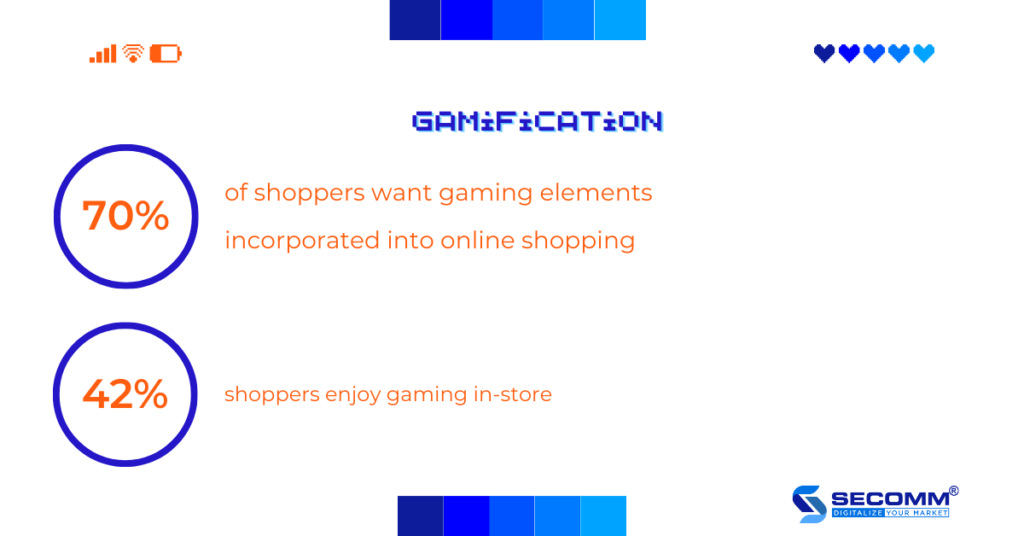
For instance, take Bajaj Finserv’s Indian financial company’s Gamification Marketing campaign. The game was created by this firm to encourage people to use its travel loan services.
Users will complete tasks and respond to questions about their preferred travel destinations. Customers adored the campaign, and it immediately trended on Twitter with more than 75 million impressions.
Thus demonstrating Bajaj Finserv’s efforts to develop engaging experiences and provide them to customers in line with its marketing strategy. Brands attract more potential customers, enjoy the better engagement, and increase conversions as a result of the viral impact.
Shoppertainment has been around for a while, but it wasn’t until Covid-19’s effect that this trend truly took off. Businesses should take advantage of this trend to improve the online shopping experience for customers and increase sales in the era of eCommerce.
Due to the growing demands of customers for a better shopping experience and the ongoing changes in the market, achieving this goal is difficult and labor-intensive. As a result, companies must work with expert agencies to plan the proper eCommerce deployment from the start.
With many years of experience in successfully implementing eCommerce for many customers in many countries, SECOMM specializes in providing consulting services with comprehensive and professional eCommerce implementation solutions.
Contact SECOMM today for free support and advice.
 2
2

 3,381
3,381

 0
0

 1
1
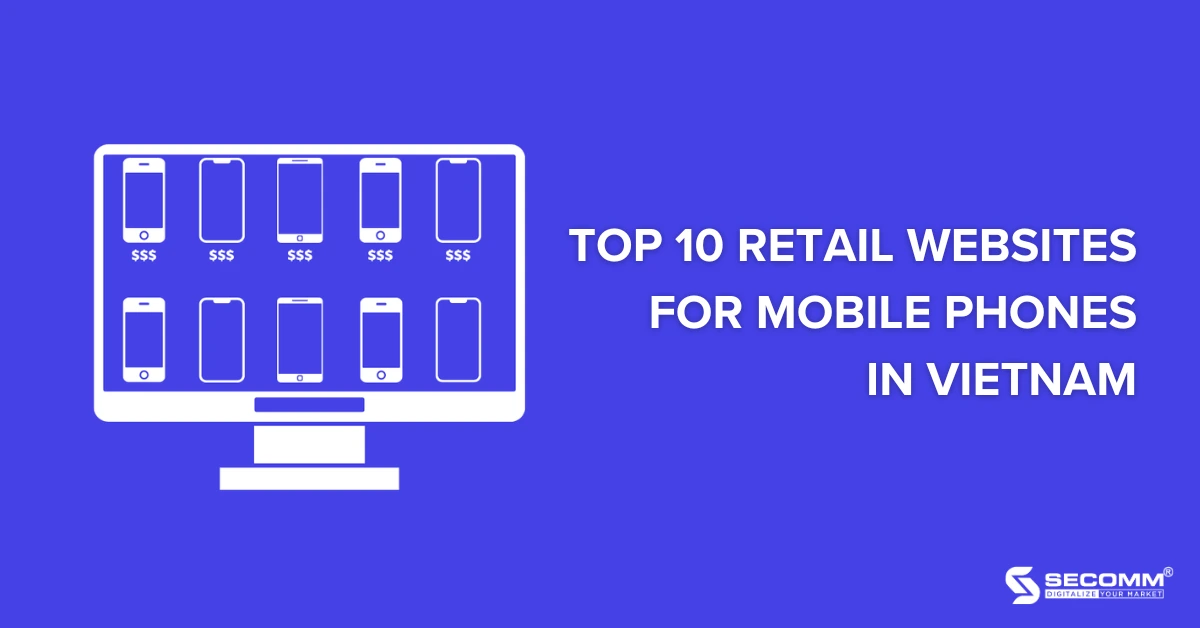
TOP 10 RETAIL WEBSITES FOR MOBILE PHONES IN VIETNAM
The retail market for mobile phones in Vietnam is booming like never before! With 61 million users, Vietnam is currently among the top 10 markets with the highest mobile phone usage in Asia. Furthermore, this market is predicted to grow in 2022 by 47.5% (according to Trendforce).
Taking advantage of this opportunity, many retail businesses in Vietnam have achieved tremendous success and continuously expanded their scale, such as The Gioi Di Dong, FPT Shop, Viettel Store, etc.
To contribute to this success, one cannot ignore e-commerce. Online sales channels such as websites, mobile apps, and e-commerce platforms play an increasingly important role for retail businesses in the mobile phone industry, especially post-pandemic.
According to Debasish Jana, an expert from the market research company Counterpoint Research, online sales of mobile phones have increased compared to the same period last year, accounting for 14% of the total market share. Not stopping there, the growth rate of online mobile phone retail is projected to increase even further shortly, reaching 29% by 2025 (according to Google, Temasek, Bain & Company).
E-commerce helps retail businesses develop their business models and contributes to revenue growth for enterprises.
The Gioi Di Dong
The Gioi Di Dong is a brand under the company The Gioi Di Dong Joint Stock Company, established in 2004. According to Euromonitor International, The Gioi Di Dong is the largest online retail company in Vietnam, holding a 10% market share. It is also the leading retail chain for mobile devices in Vietnam, with approximately 1,000 stores present in all 63 provinces and cities nationwide.
Currently, this retail business is heavily investing in online sales systems such as websites and apps.

- Website: https://www.thegioididong.com/
- Website Traffic: 30.20M/mn
CellphoneS
CellphoneS is a retail system for well-known technology products in Vietnam. Currently, the business has a presence in Ho Chi Minh City, Hanoi, Binh Duong, Hai Duong, Hai Phong, Bac Ninh, Vinh Phuc, Thai Nguyen, and Vung Tau.
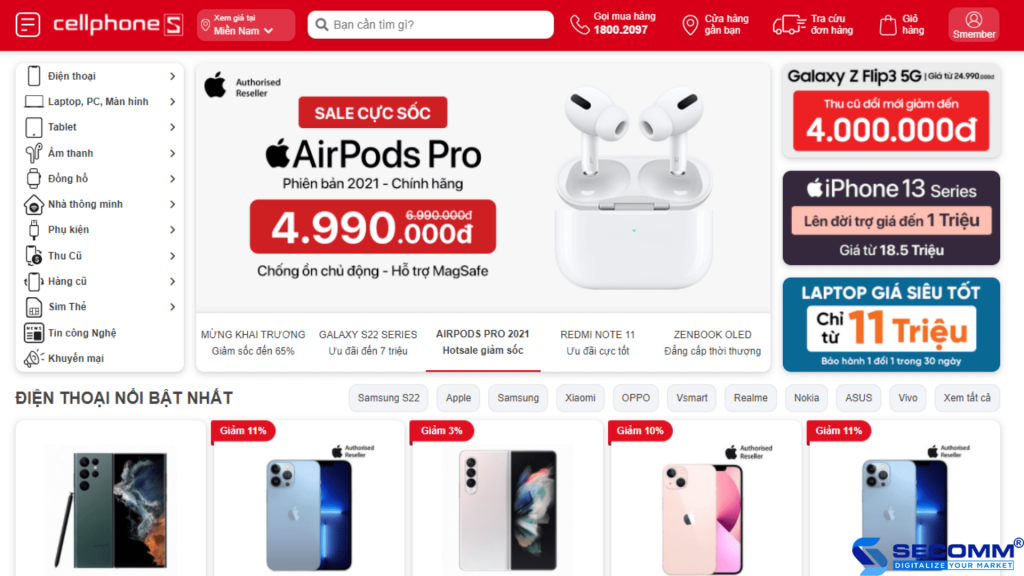
- Website: https://cellphones.com.vn/
- Website Traffic: 9.08M/mn
FPT Shop
FPT Shop is under the ownership of FPT Corporation Vietnam, established in 2012. It is an officially authorized dealer of Apple in Vietnam at the highest level, specializing in providing genuine electronic products. Currently, the retail chain system spans across the country with stores in all 63 provinces and cities.
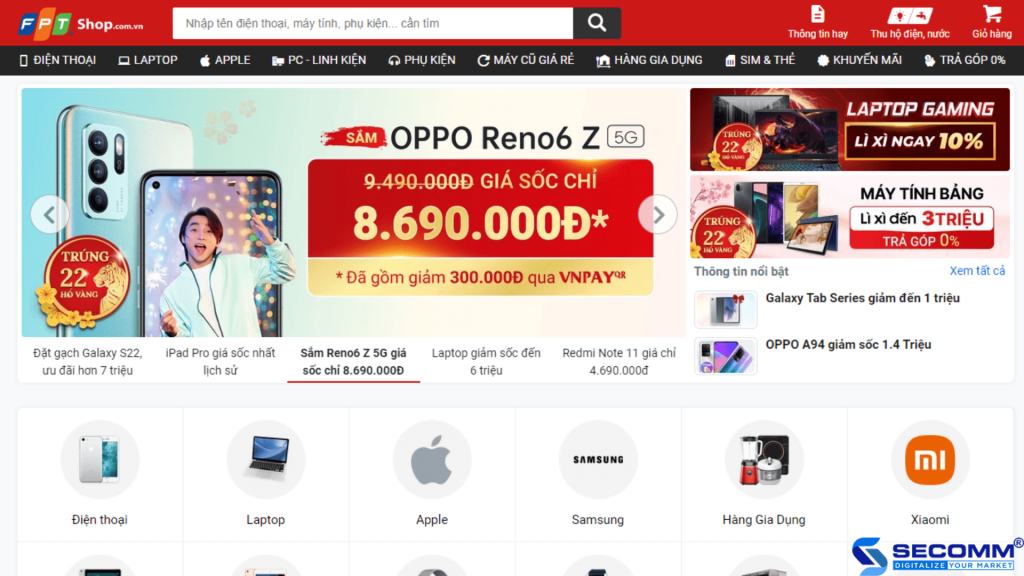
- Website: https://www.fptshop.com.vn
- Website Traffic: 5.933M/mn
Hoang Ha Mobile
Hoang Ha Mobile is a retail system specializing in providing genuine technology products and well-known mobile phones in Vietnam, established in 2014. Currently, the business has over 90 branches spanning from the North to the South.

- Website: https://www.hoanghamobile.com
- Website Traffic: 4.818M/mn
Di Dong Viet
The Mobile Technology Company Limited operates the Didongviet.vn retail chain, established in 2009 as a reputable system specializing in genuine technology products, notably mobile phones, tablets, laptops, accessories, and components.

- Website: https://www.didongviet.vn
- Website Traffic: 1.787M/mn
Viettel Store
Viettel Store was launched in 2009 with thousands of continuously updated products to meet the online shopping needs of customers nationwide. With over 200 stores, Viettel Store’s retail system provides a wide range of high-tech devices and products, including mobile phones, laptops, tablets, and medical equipment.
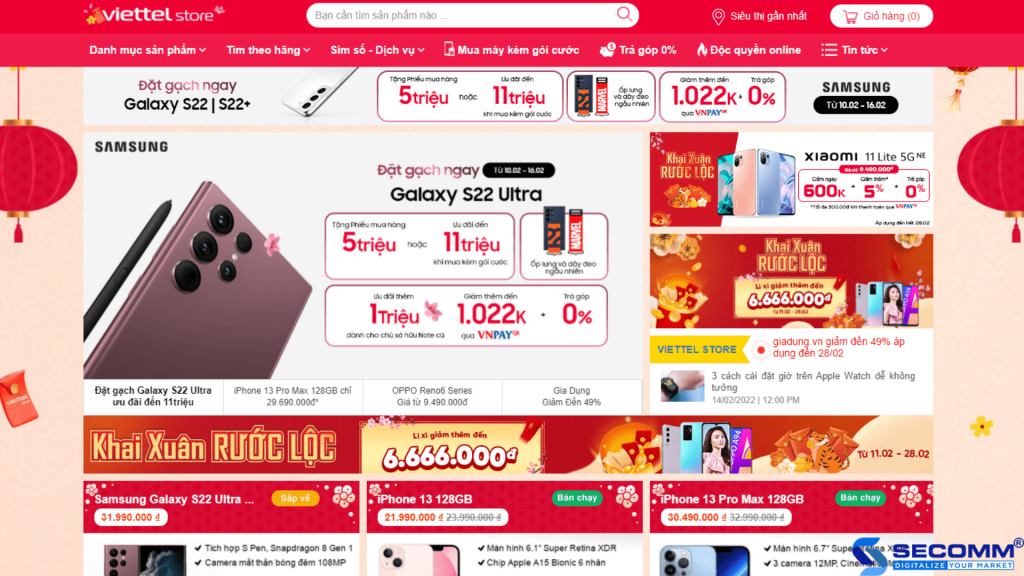
- Website: https://www.viettelstore.vn
- Website Traffic: 1.673M/mn
Sony Store
Sony is one of the most globally renowned brands in consumer electronics, thanks to its revolutionary innovations and product quality. After 21 years in Vietnam, Sony has established a retail system consisting of 11 Sony Shops and Sony Centers, over 160 official dealers, and 70 authorized service stations spread across the country.
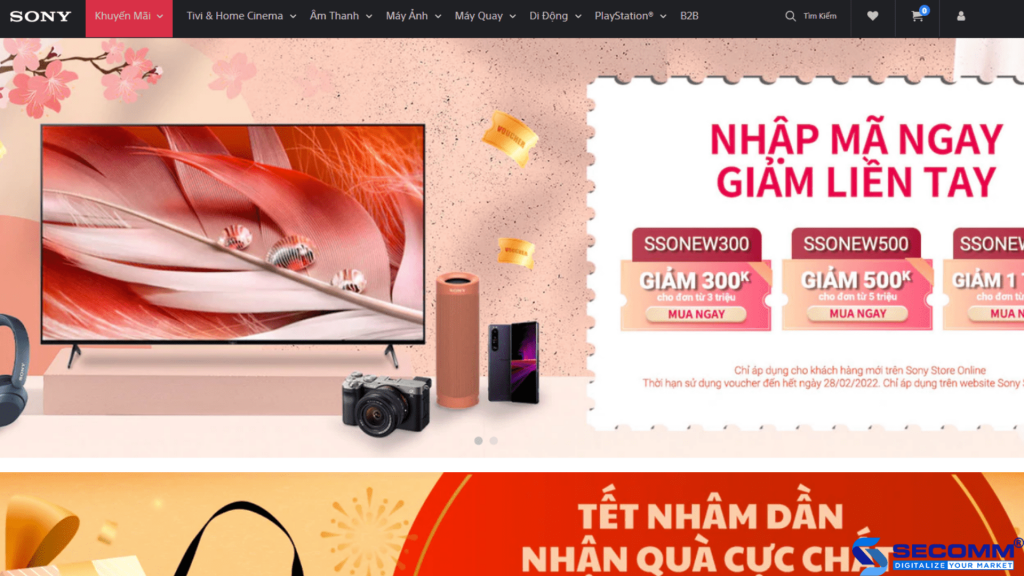
- Website: https://www. store.sony.com.vn/
- Website Traffic: 1.649M/mn
Phong Vu
Phong Vũ is known as a long-established and reputable retail unit in Vietnam since 2007, with over 30 stores nationwide. Specializing in the business of information technology products, gaming and entertainment devices, office equipment, and high-tech devices from various major brands.

- Website: https://www.phongvu.vn
- Website Traffic: 1.479M/mn
Mobile City
Mobile City is one of the popular retailers of smartphones, tablets, and technology accessories in Vietnam, with over 10 years of experience.
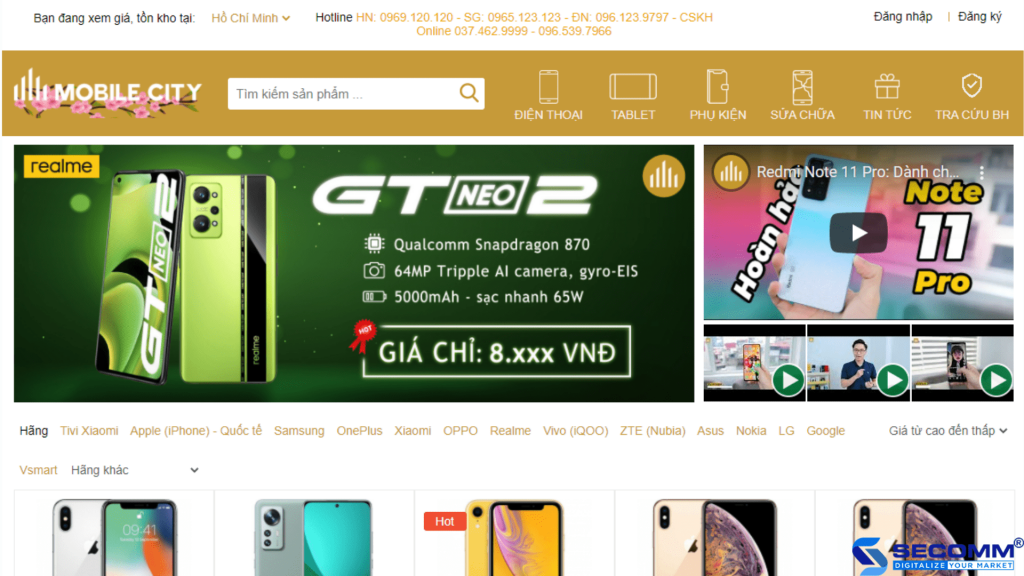
- Website: https://mobilecity.vn/
- Website Traffic: 1.216M/mn
Clickbuy
Clickbuy is a retail system offering well-known technology products in Vietnam, established in 2012. Currently, Clickbuy has expanded to include 5 stores and 2 modern service centers in Hanoi and Ho Chi Minh City.
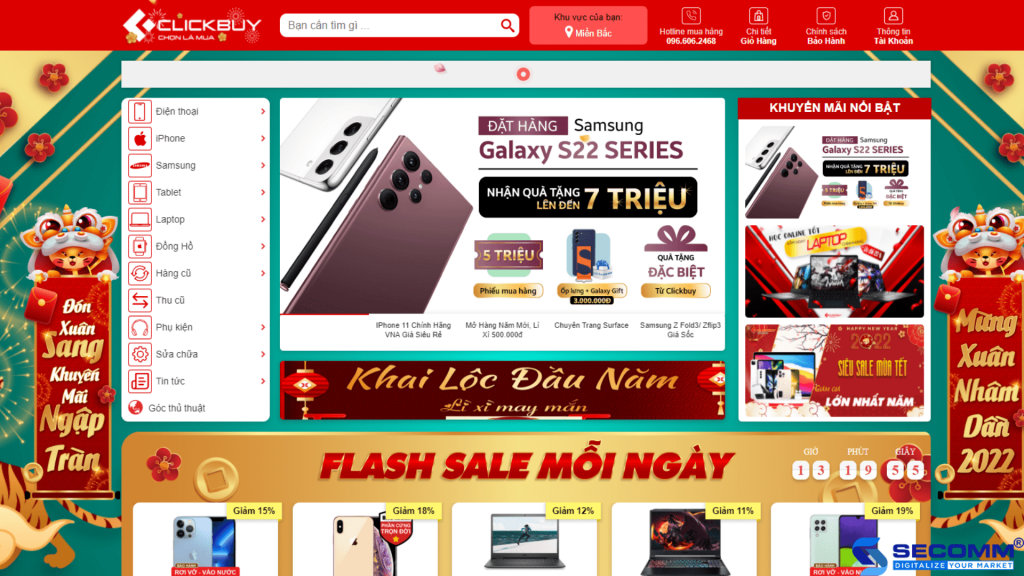
- Website: https://clickbuy.com.vn/
- Website Traffic: 1.190M/mn
Developing E-commerce Solutions for the Mobile Phone Retail Industry
Online business in the mobile phone industry presents numerous growth opportunities. However, to succeed, businesses need a partner with extensive experience in the e-commerce landscape.
With a successful track record in implementing complex e-commerce systems, SECOMM understands the challenges that businesses face.
Contact us now for a free consultation on comprehensive e-commerce system development solutions!
 2
2

 32,507
32,507

 0
0

 1
1

TOP 10 INCREDIBLE WINERY ECOMMERCE WEBSITE IN VIETNAM 2022
Many businesses have promoted winery eCommerce in the context of the Covid-19 pandemic, which has been described as a “nightmare” for many economic sectors but appears to be “luck” for eCommerce.
According to Rabobank, eCommerce sales in the wine industry will reach USD 6 billion in 2021, up 4% from the same period in 2020. As said by Forbes, the percentage of online wine orders increased significantly compared to previous years before the pandemic.
Recognizing the potential of this field, many wineries in Vietnam have begun to develop eCommerce websites in order to quickly establish a market position.
Nam An Market
Nam An Market is a retail chain of healthy food stores that Nam An International Investment Co., Ltd. invested in in 2012. Its eCommerce website, which receives over 100,000 visits per month, was built successfully on the Haravan platform.
Aside from fruits, vegetables, meat, and fish, alcoholic beverages, particularly wines, are popular on Nam An’s website. Furthermore, the online shopping experience focuses on safety, convenience, speed, reasonable prices, and various appealing incentives.
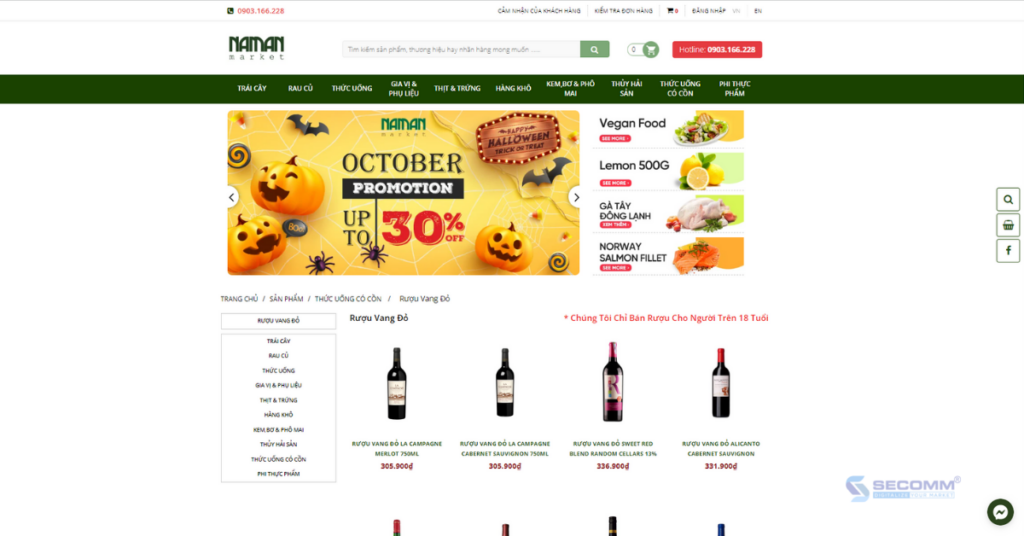
- Website: https://namanmarket.com/
- eCommerce platform: Haravan
- Traffic: 101.3K/month
- Ranking: 9,079 (Vietnam); 404,452 (Worldwide)
Winemart
Winemart was founded in 2015 to provide consumers with the best services and products possible. Currently, Winemart operates in two main areas:
- Premium wine brand distribution
- Design and package Tet gifts for businesses and customers as needed.
Winemart’s eCommerce website receives over 60,000 visits and is regarded as one of Vietnam’s most prestigious online wine suppliers.
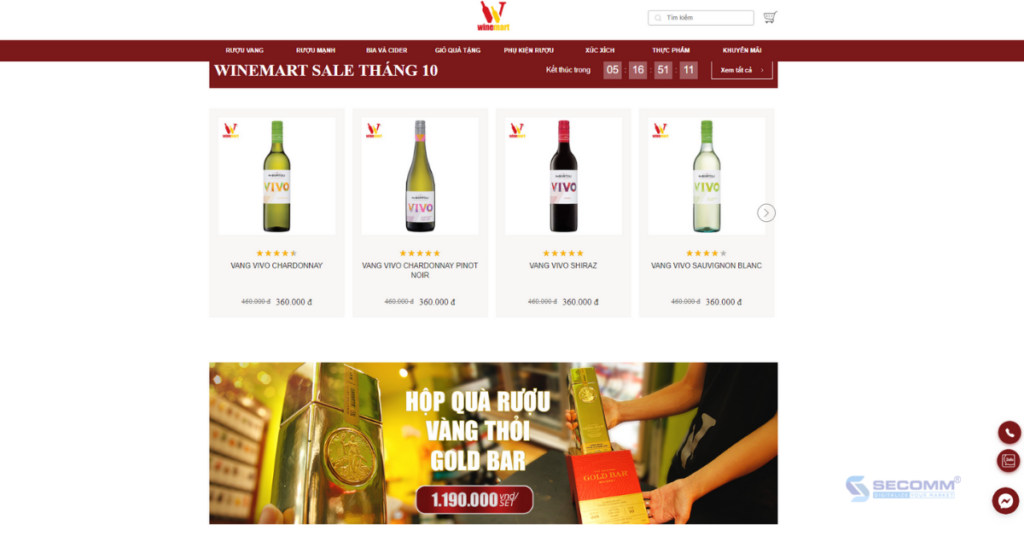
- Website: https://winemart.vn/
- eCommerce platform: WooCommerce
- Traffic: 66.4K/month
- Ranking: 17,459 (Vietnam); 730,667 (Worldwide)
Sieu Thi Ruou Ngoai
Sieu Thi Ruou Ngoai is not only an eCommerce website that sells imported foreign wine but also a knowledge system about culture, history, and how to choose, preserve, and enjoy wines from around the world, allowing people who are passionate about or want to learn about wine culture to share and improve their understanding.
Sieu Thi Ruou Ngoai now has its own eCommerce website system, which receives over 50,000 visits per month and is highly regarded by customers for both product quality and online shopping experience.
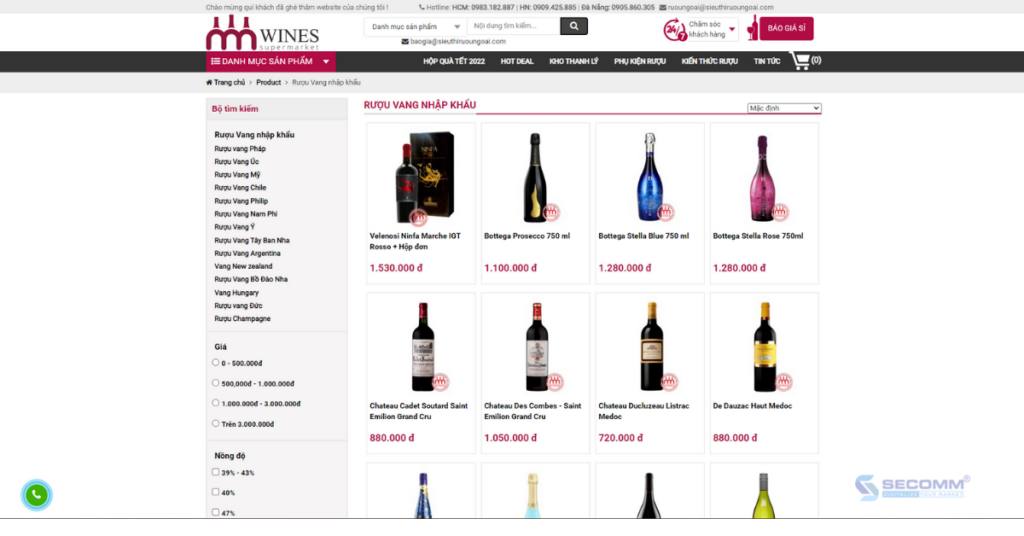
- Website: https://www.sieuthiruoungoai.com/
- eCommerce platform: PHP language
- Traffic: 48.1K/month
- Ranking: 16,664 (Vietnam); 735,935 (Worldwide)
Ruou Vang Cao Minh
Cao Minh was founded and developed by CEO Thanh Dung, a wine enthusiast who is passionate about learning about wine culture. After many years of research, learning, and improving service quality, Cao Minh has fully converged all the factors to become Vietnam’s leading wine supplier.
Cao Minh’s website is written in PHP and includes all the necessary features and an easy-to-use interface. Cao Minh Wine has become a household name among customers who prioritize online wine shopping.
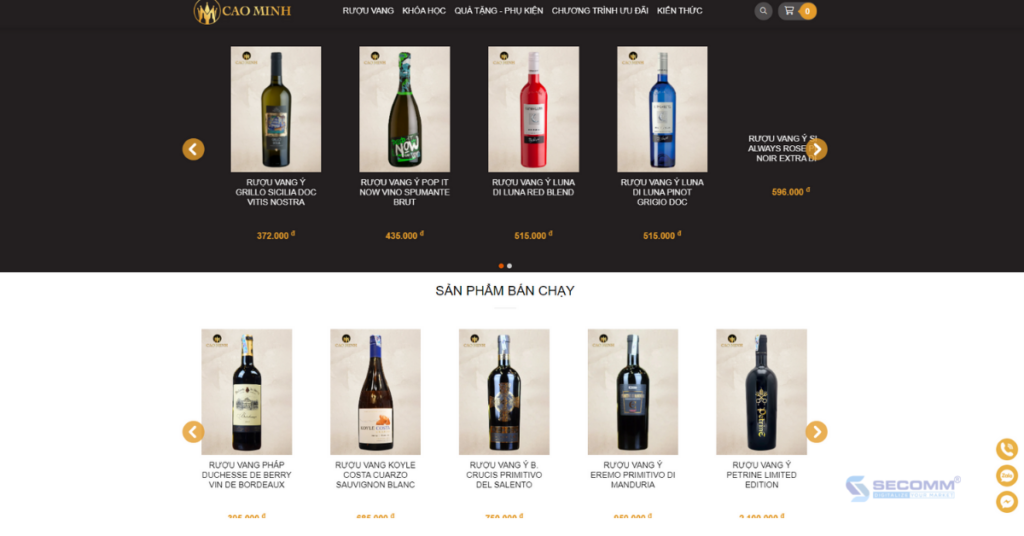
- Website: https://ruouvangcaominh.vn/
- eCommerce platform: PHP language
- Traffic: 45.9K/month
- Ranking: 22,324 (Vietnam); 982,166 (Worldwide)
Kho Ruou
Kho Ruou, also known as Kho Ruou Co., Ltd., is Vietnam’s leading importer and distributor of foreign wines and spirits, with over 3000 products of wine, spirits, beer, Japanese sake, and genuine high-end accessories.
Kho Ruou pursues an eCommerce business model by investing in developing a website using the WooCommerce platform. As a result, the company can easily reach a large number of potential customers both online and offline.
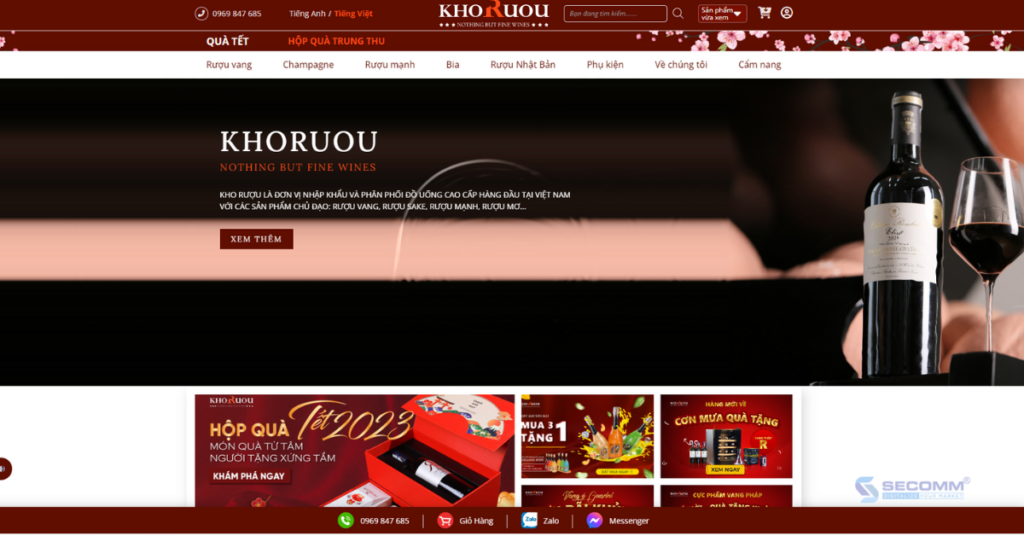
- Website: https://khoruou.com/
- eCommerce platform: WooCommerce
- Traffic: 32.9K/month
- Ranking: 52,372 (Vietnam); 2,140,674 (Worldwide)
Ruou Tot
When eCommerce is a new trend widely praised by the Covid-19 pandemic. To keep up with that trend, Wine Tot built an eCommerce website with WooCommerce, which helped to increase brand coverage and reach a large number of potential customers on the Internet.
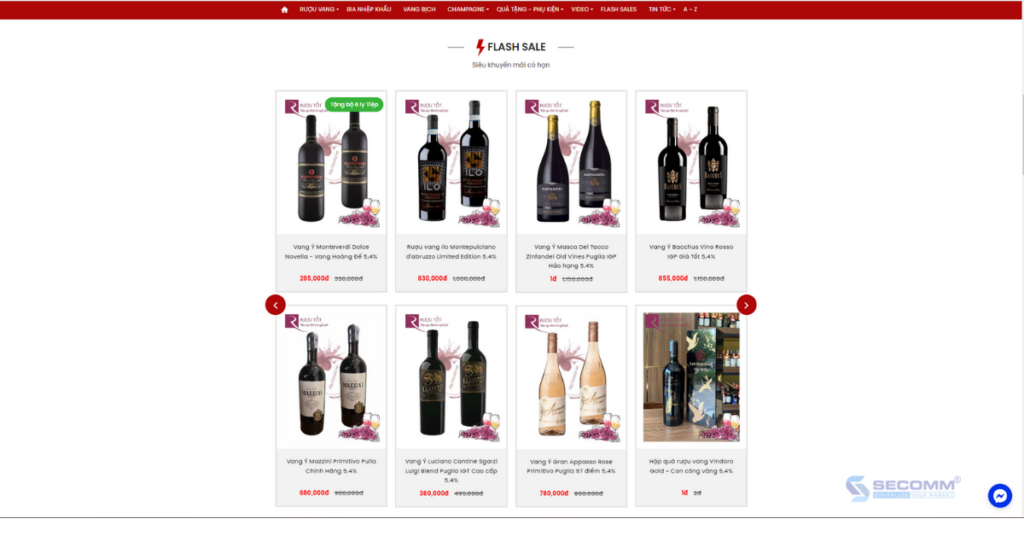
- Website: https://ruoutot.net/
- eCommerce platform: WooCommerce
- Traffic: 36.3K/month
- Ranking: 21,489 (Vietnam); 943,255 (Worldwide)
Ruou Nhap Khau
Ruou Nhap Khau is a wine eCommerce website operated by Ham Ruou Vietnam Co., Ltd, one of Vietnam’s leading import and distribution businesses.
Ruou Nhap Khau creates an e-commerce website with the PHP programming language. With an easy-to-use interface and good product quality and service, the company has gradually gained customer trust for its imported wine product lines ranging from popular to high-end.
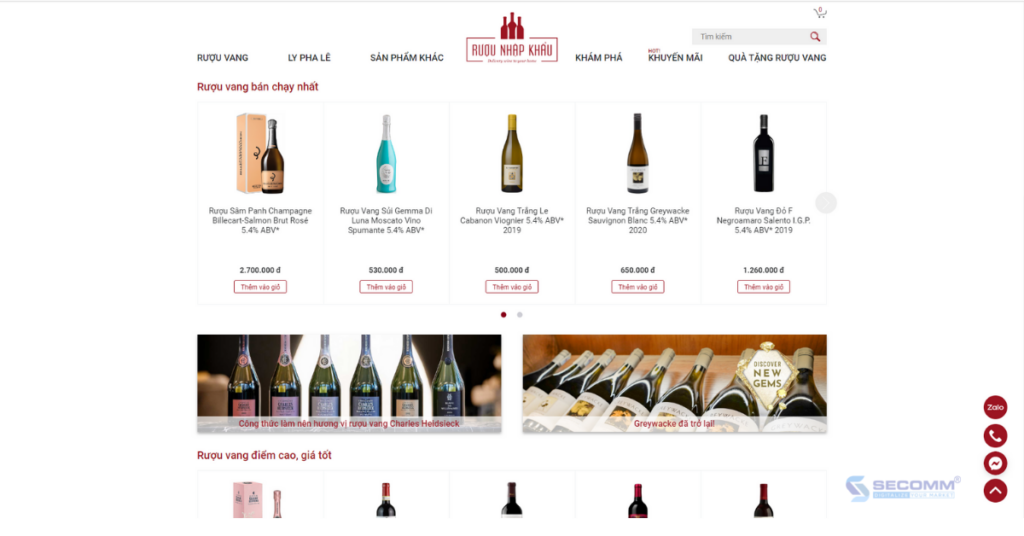
- Website: https://ruounhapkhau.com/
- eCommerce platform: PHP language
- Traffic: 28.3K/month
- Ranking: 31,246 (Vietnam); 1,334,043 (Worldwide)
Sanh Vang
Sanh Vang is a wine distribution brand founded in 2015 by Saigon Hoang Kim Investment and Trading Company Limited. Sanh Vang has expanded its branch network to many provinces, including Ha Noi, Ho Chi Minh City, Bien Hoa (Dong Nai), and Buon Ma Thuot.
Furthermore, Sanh Vang’s eCommerce website receives over 25,000 visits per month, and the brand receives many positive reviews from customers due to its wine quality, competitive price, available stock, and variety.
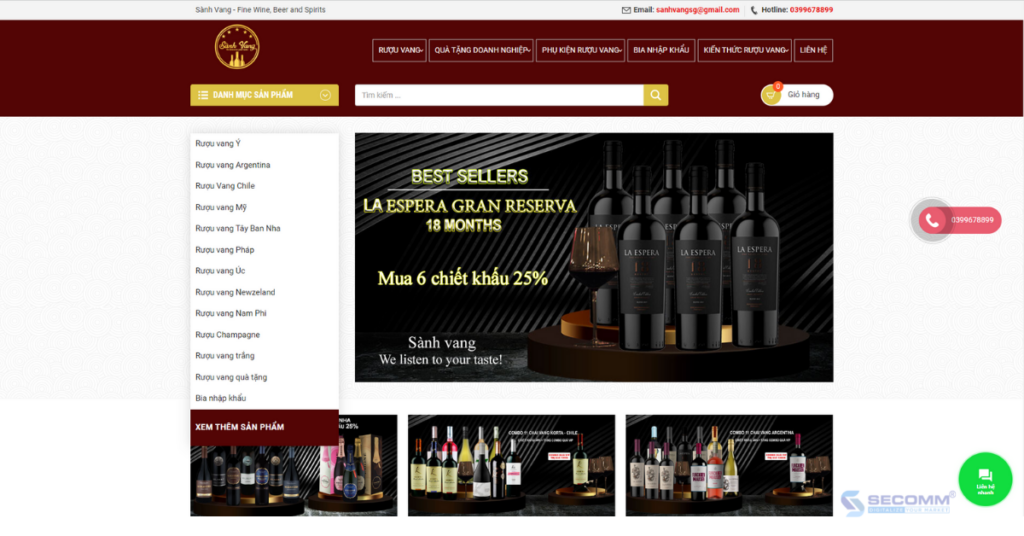
- Website: https://sanhvang.com/
- eCommerce platform: WooCommerce
- Traffic: 25.4K/month
- Ranking: 545,398 (Vietnam); 1,735,237 (Worldwide)
Winecellar
Winecellar, founded in 2007, is one of Vietnam’s largest wine companies, specializing in high-quality wine, beer, whiskey, food, mineral water, tea, and ceramic products. Winecellar, like Kho Ruou and Sanh Vang, uses the WooCommerce platform to implement eCommerce.

- Website: https://winecellar.vn/
- eCommerce platform: WooCommerce
- Traffic: 21K/month
- Ranking: 48,961 (Vietnam); 2,063,194 (Worldwide)
The Warehouse
The Warehouse is a wine and spirits distributor in the Vietnamese market, as well as one of An Nam Group’s retail brands.
With a long-term and sustainable eCommerce business in mind, this brand has decided to invest in developing its own eCommerce website on the open-source Magento platform and continuously upgrading this system to provide a better eCommerce experience for customers.
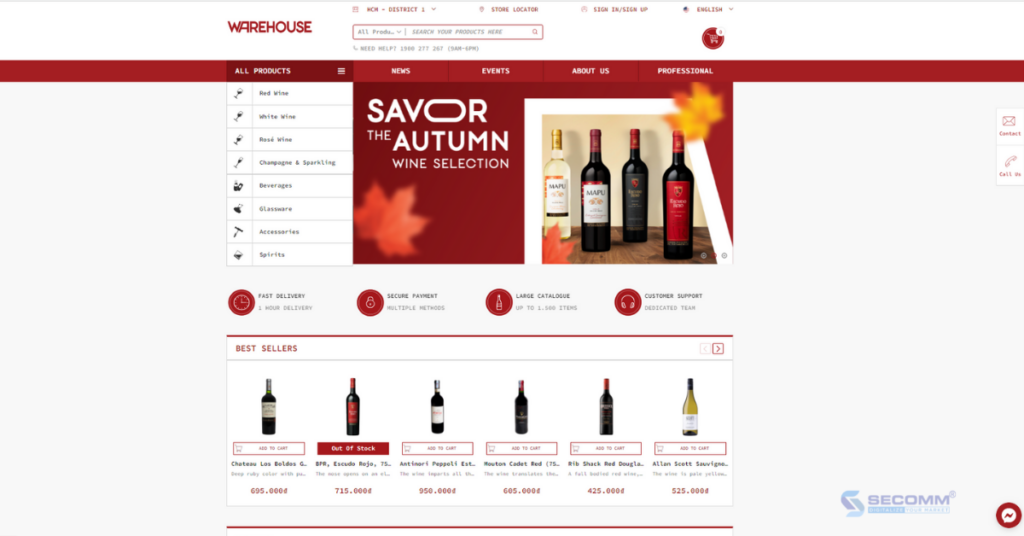
- Website: https://warehouse-asia.com/
- eCommerce platform: Magento
- Traffic: 5K/month
- Ranking: 78,311 (Vietnam); 3,571,809 (Worldwide)
In general, Vietnamese wine brands are reaping numerous market successes after successfully developing their own eCommerce websites. However, the wine eCommerce business necessitates careful consideration of tactics to take the most effective steps not only in the short term but also in the long term.
Furthermore, wineries need to find a support unit or build a highly qualified in-house team to help them to achieve a common goal.
With many years of experience implementing eCommerce in many countries, SECOMM provides free consulting services with professional eCommerce solutions.
Contact us today for free support and advice!
 2
2

 3,068
3,068

 0
0

 1
1
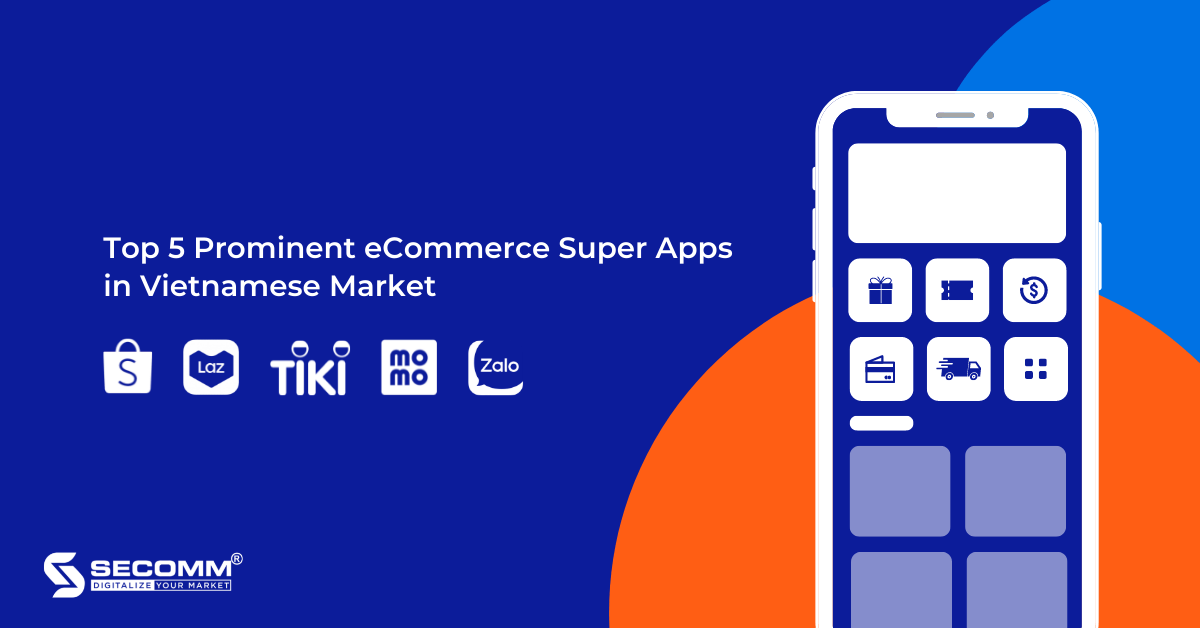
TOP 5 PROMINENT ECOMMERCE SUPER APPS IN VIETNAMESE MARKET
According to the latest of Ministry of Industry and Trade of the Socialist Republic of Vietnam in 2022, the eCommerce industry’s revenue is estimated at 13.7 billion USD, increase 16% compared to 2020 and accounting for 6.5% of the total retail revenue of Vietnam. Due to e-Commerce SEA, Vietnam’s eCommerce will grow by an average of 25% per year from 2022 – 2025, possibly reaching 35 billion USD in 2025.
The impact of the Covid-19 epidemic and social distancing orders, as well as changes in consumer behaviour, are driving the growth of this industry.
Thanks to super apps, such as Shopee, Lazada, Tiki, MoMo, and Zalo, it’s easier to deploy mini apps, creating a premise for inexperienced brands to build eCommerce systems to enter this billion-dollar market.
Shopee
Shopee is the most popular eCommerce market in Southeast Asia and Taiwan. Shopee was founded in 2015 to provide people with an easy, safe, and quick online buying experience.
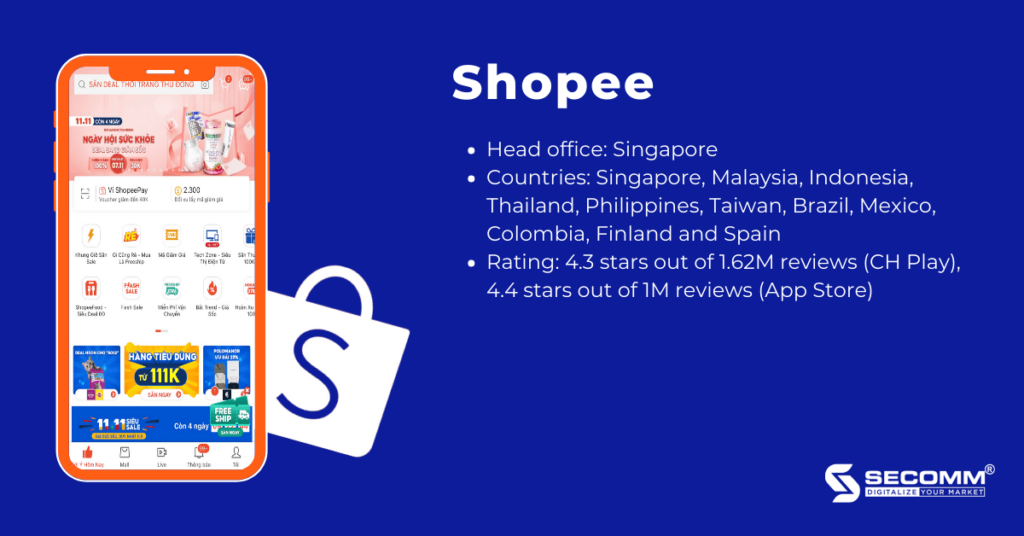
Shopee is gradually becoming an eCommerce super app, not only offering online shopping services but also owning various mini-apps such as Shopee Food, Shopee Mart, Shopee Wallet, insurance services from banks, booking flights, hotels and so on.
- Head office: Singapore
- Countries: Singapore, Malaysia, Indonesia, Thailand, Philippines, Taiwan, Brazil, Mexico, Colombia, Finland and Spain
- Rating: 4.3 stars out of 1.62M reviews (CH Play), 4.4 stars out of 1M reviews (App Store)
Lazada
Lazada, founded in 2012, is one of Southeast Asia’s biggest eCommerce marketplaces. This brand has always been a pioneer in fostering regional development via commerce and technology, intending to service 300 million consumers across Southeast Asia by 2030.
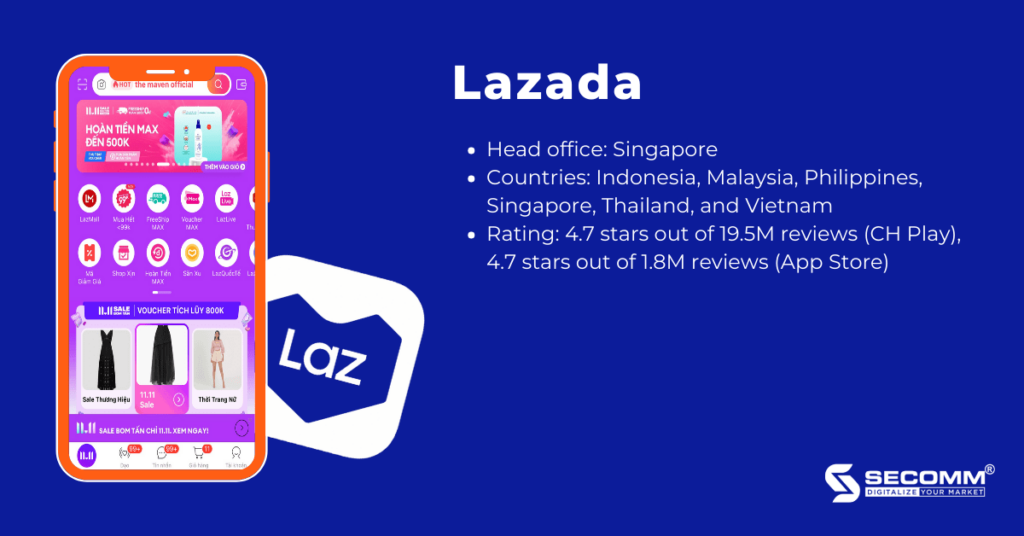
Like Shopee, Lazada has many mini apps and utilities for its own e-commerce business strategies, such as eM wallet, card and eVoucher recharge, online shopping, etc.
- Head office: Singapore
- Countries: Indonesia, Malaysia, Philippines, Singapore, Thailand, and Vietnam
- Rating: 4.7 stars out of 19.5M reviews (CH Play), 4.7 stars out of 1.8M reviews (App Store)
Tiki
Tiki is one of Vietnam’s most successful eCommerce marketplaces. Tiki was founded in March 2010 as an online English book-selling site. Since then, Tiki has evolved into an eCommerce super app, focusing on delivering hundreds of thousands of goods from a variety of product categories.
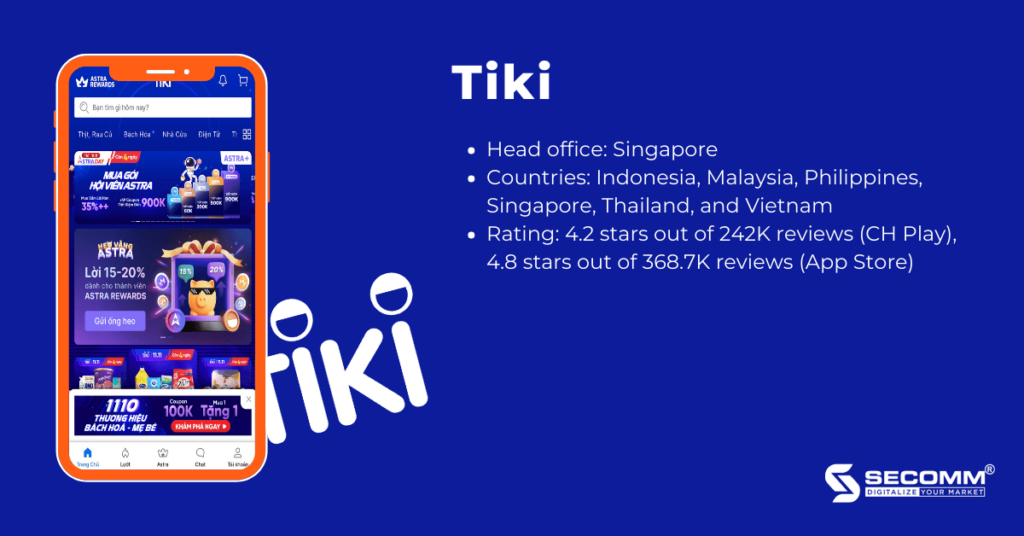
Tiki has been a pioneering marketplace in applying digital currency to business concepts, as proven by the launch of Astra, to boost up eCommerce. At the same time, Tiki refined its ecosystem by creating a series of extensions with mini apps from brands in various industries, including finance, gaming, food, shopping, health, insurance, entertainment, lifestyle, tourism, and community.
- Head office: Singapore
- Countries: Indonesia, Malaysia, Philippines, Singapore, Thailand, and Vietnam
- Rating: 4.2 stars out of 242K reviews (CH Play), 4.8 stars out of 368.7K reviews (App Store)
MoMo
MoMo is an e-wallet created by Online Mobile Services Joint Stock Company (M Service) that allows users to make mobile payments and transactions. Through partnerships with more than 90% of Vietnam’s banks and 10,000 local businesses, the company dominates more than 80% of the market for digital payments. As of 2022, MoMo e-wallet has more than 31 million users.
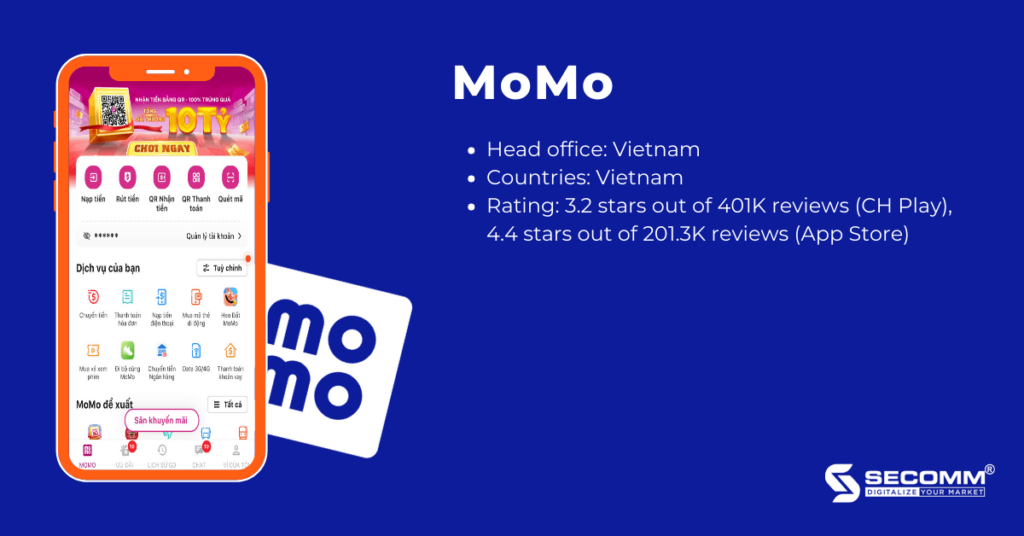
Since 2022, MoMo has developed a mini app technology, formally identifying itself as a super-payment app, helping small and medium companies to “climb on the shoulders of giants,” and construct an ecosystem for MoMo. In particular, utilities from businesses such as online shopping, restaurants, transportation services, tourism and hotels, investing and banking, medical services and so on.
- Head office: Vietnam
- Countries: Vietnam
- Rating: 3.2 stars out of 401K reviews (CH Play), 4.4 stars out of 201.3K reviews (App Store)
Zalo
Zalo was formally launched in December 2012, with the essence of a cross-platform instant messaging software built by the Vietnamese startup VNG. Zalo is a blend of Zing (a VNG-created social network) and alo (a phrase used to pick up a phone in Vietnam). Zalo has progressed to become a multi-functional, multi-platform social networking super app.
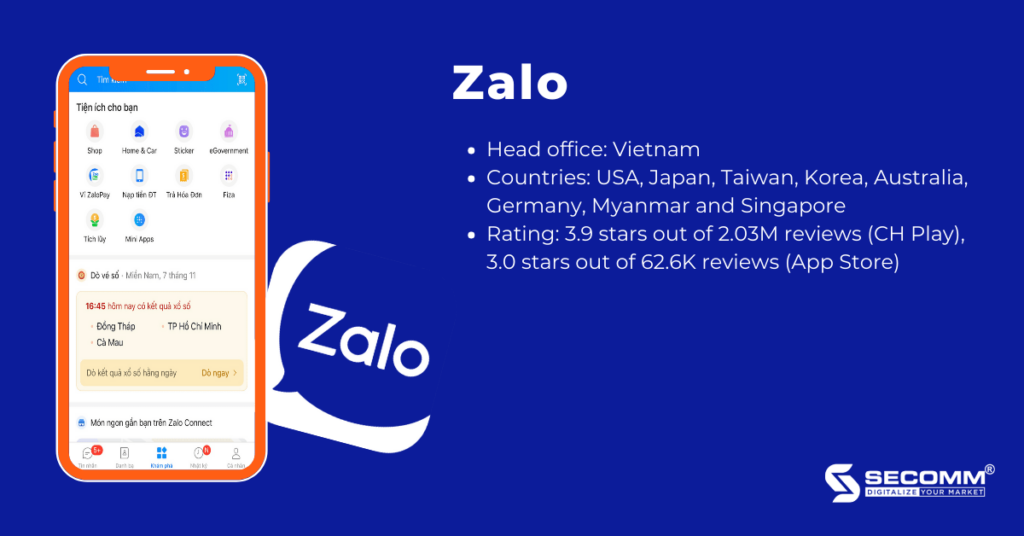
Like MoMo, Zalo created a new brand named Zalo Mini App to help other brands reach 65 million regular users on Zalo, and make diversity for this messaging platform. Since then, Zalo has also supported other services, primarily through partnerships with brands in finance, eCommerce, entertainment, games, restaurants and hotels.
- Head office: Vietnam
- Countries: USA, Japan, Taiwan, Korea, Australia, Germany, Myanmar and Singapore
- Rating: 3.9 stars out of 2.03M reviews (CH Play), 3.0 stars out of 62.6K reviews (App Store)
As can be seen, the future of Vietnam’s eCommerce industry will continue to rely on these “giants,” thus businesses should incorporate eCommerce super apps into their business models as soon as possible to reap the full advantages of these applications. However, companies should not rely on these apps for long periods of time since it will result in a loss of customer data, income from commission per order, and so on.
With more than 8 years of experience in consulting and deploying eCommerce systems, SECOMM understands the challenges businesses face in implementing eCommerce business effectively.
So we provide a free eCommerce consultation to help businesses catch on to this industry!
 2
2

 4,255
4,255

 0
0

 1
1



